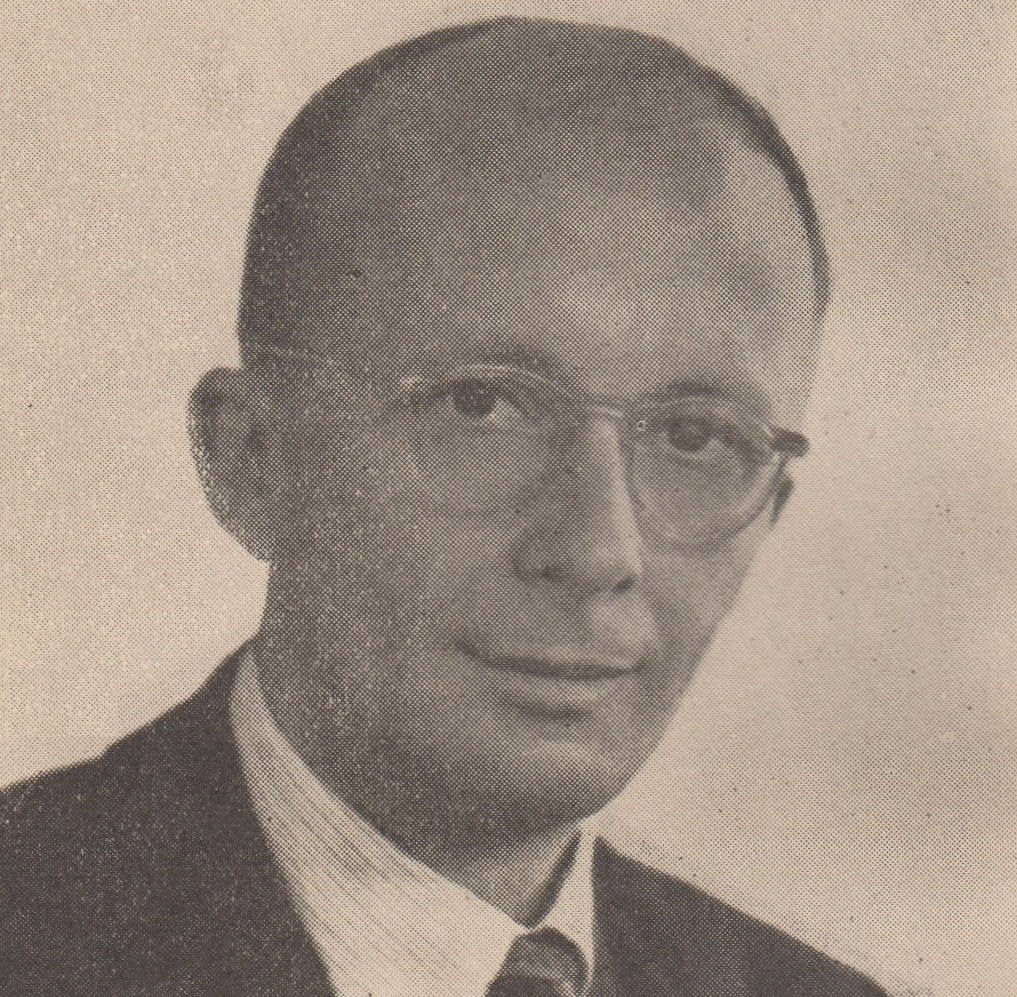
Edward Winter

Cecil John Seddon Purdy
Frontispiece, Guide to Good Chess (Sydney, 1950)
Some quotes from C.J.S. Purdy, His Life, His Games and His Writings by J. Hammond and R. Jamieson (Melbourne, 1982):
(434)
In an entertaining article on pages 169-170 of the April 1973 BCM, C.J.S. Purdy described the frustrations he had experienced in trying to discover more about Mary Houlding. Curiously, he appears to have overlooked that her obituary was indeed printed in the BCM (April 1940, page 129), and that a subsequent letter (June 1940, page 200) revealed her maiden name, Palmer, and a few more family details.
(1133)
We note that Mrs Houlding is to be seen in a group photograph on page 363 of the 1913 BCM. She appears to be about half the size of everybody else (hence the expression ‘small Houlding’). Examples of her play are rare, and the best we have found is the following game, which won the first prize for brilliancy in the British Ladies’ Championship Tournament of 1909. It is taken from page 450 of the October 1909 BCM:
Miss Taylor – Mrs Houlding
Scarborough, 1909
Queen’s Indian Defence
1 d4 b6 2 Nf3 Bb7 3 e3 e6 4 c4 Nf6 5 Be2 Be7 6 Nc3 O-O 7 O-O d6 8 b3 Nbd7 9 Bb2 Ne8 10 e4 f5 11 e5 Rb8 12 exd6 Bxd6 13 d5 exd5 14 Nxd5 Ndf6 15 Nxf6+ Nxf6 16 Ne5 Re8 17 f4 Bc5+ 18 Kh1 Ne4 19 Qxd8 Rbxd8 20 Bf3 Ng3+ 21 hxg3 Rd6 22 Ng4 fxg4 23 Bxg4 Rh6+ 24 Bh3 Rxh3 mate.
(1154)
The above-mentioned photograph is given, together with further information on Mrs Houlding, in C.N. 4500.
C.J.S. Purdy had a nice touch in irony. See, for instance, the March 1984 BCM, page 124. Another example is quoted on page 285 of the November 1941 issue of the same magazine. He gives ‘a marathon game at pawn and two moves’ (remove Black’s f-pawn) in Melbourne (players not identified): 1 e4 ... 2 d3 Nc6 3 Bg5 h6 4 Qh5+ g6 5 Qxg6 mate, and adds, ‘The odds-giver’s [sic] ultimate defeat can be traced right back to his weakening pawn-advance on move three.’
(1289)
Another illustration, from Purdy’s book The Return of Alekhine (quoted on pages 59-60 of the 14 October 1938 CHESS). It concerns the third game of the 1937 Euwe-Alekhine match:
‘A fine game marred only by annotators’ blunders. These jackals pulled Euwe’s end-game play to shreds, and actually missed the one mistake he made.’
(1589)
What constitutes a combination? Many books claim that a sacrifice is essential, but C.J.S. Purdy used the following position to dispute that:
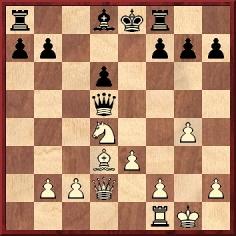
White, to play, wins by 1 Bb5+ Ke7 2 Nf5+ Ke6 3 Nxg7+, etc. He has made no sacrifices but ‘a succession of threats winding up with the capture of the netted piece’. See page 201 of C.J.S. Purdy: His Life, His Games and His Writings by J. Hammond and R. Jamieson (Melbourne, 1982).
Purdy wrote: ‘Combinations are characterized by violent moves, but not necessarily sacrifices.’
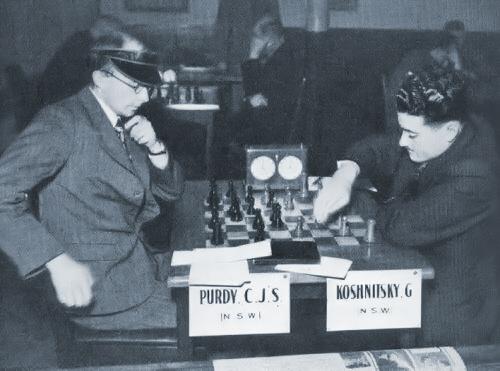
(1960)
For further discussion of this topic, and the diagrammed position, see What is a Chess Combination?
From pages 64-67 of How Purdy Won (Cammeray, 1983) by C.J.S. Purdy, F. Hutchings and K. Harrison:
F.L. Vaughan – C.J.S. Purdy
Correspondence, -1946
Grünfeld Defence
1 d4 Nf6 2 c4 g6 3 Nc3 d5 4 Bf4 Bg7 5 e3 c5 6 dxc5 Qa5 7 cxd5 Nxd5 8 Qxd5 Bxc3+ 9 bxc3 Qxc3+ 10 Ke2 Qxa1 11 Be5 Qc1 12 Bxh8 Be6 13 Qxb7 Qc2+ Drawn.
Purdy comments:
‘This game finished in 1946. Eight years later the same game occurred in the crossboard grandmaster tourney of Bucharest 1954, Filip v Pachman. And ten years after that, Pachman played it with Black again, this time against Darga, in the Interzonal, Amsterdam 1964. In the last round of the same tourney it occurred yet a fourth time, in Berger v Bilek.’
(1860)
From page 139 of the September 1963 Chess World:
‘A prominent article on Kotov appeared in a Sydney newspaper, crediting him with being a former world champion and being “second in the last world championship”. A few of us saw Kotov at lunch, and we solemnly shook hands with him, congratulating him on his new honours. He said, “We always say that if a newspaper article is 5% right, it is good. This one was not quite as good as that, but it was not so bad – it said my name was Alexander Kotov, and it is”.’
(Kingpin, 1998)
White to move:
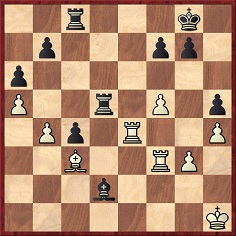
K. Reintals-S. Kruger, Australian Championship, Brisbane, 1951
White played 30 Rxc3, which M.E. Goldstein explained as follows in Chess World (October 1951, page 225):
‘Desperately short of time, White here captured his own bishop with his rook! His score sheet clearly reads 30 TxL, which is the Continental rendering of RxB.
The Director of Play rightly ruled that, as White had touched his R at B3 he must move it. As the rook could no longer protect the bishop, a piece is lost and White promptly resigned.’
The magazine’s editor, Purdy, remarked: ‘By the new rules, not yet in force, the FIRST piece touched must be moved; here perhaps it was the bishop. Present rules give the opponent the choice.’
Purdy added, ‘Ahues once took his own pawn in a big tourney’. He was doubtless thinking of the well-known game Przepiórka v Ahues, Kecskemét, 1927, but it was Przepiórka who captured his own bishop. By coincidence, there too the illegal move was ‘RxB’.
(Chess Café, 1998)
The Przepiórka v Ahues position was discussed by Tim Krabbé on page 501 of the September 1976 Chess Life and Review.
Referring to Oscar Wilde on page 261 of the December 1953 Chess World, C.J.S. Purdy wrote ‘Wylde’. The misspelling brought forth a clever correction from a reader, R. Jackson, on page 8 of the January 1954 issue:
‘Sir,
Why do you spell Wilde with a Y?
Was not the man lord of the I?
Now he shouts from the Shades,
Whether furnace or glades,
“Purdytion take Purdi’s damned Y”.’
(Chess Café, 1998)
C.N.s 2545 and 7819 quoted a remark on page 271 of C.J.S. Purdy’s The Australasian Chess Review, 31 October 1938:
‘We consider Botvinnik the most brilliantly searching annotator in the world – the ordinary junk written by annotators doesn’t go down in Russia, where there are thousands who can pull bad notes to pieces.’
Shortly before his death, H.J.R. Murray wrote:
‘The days when my copies of Chess World arrive are red letter days. I still think it the best of all chess magazines and revel in every word of it.’
Source: Chess World, May 1955, page 98.
(2490)
C.J.S. Purdy was in cracking form on page 43 of Chess World, 1 February 1950:
‘Chess Logic (sic) is by B. Koppin of the USA – that’s all the address given. The book gives the impression that the author knows what he is talking about; but it is a secret which the reader does not share. We quote here from the book’s second part, entitled “Theory”:
“Power, or intrinsic ability, consists in strength and its extension. Strength consists in quality and safety. Extension consists in space, interference, force, and potency. A strong, extended man or side is powerful. – Advantage, or extrinsic ability, is the difference in powers. It is received from the enemy. It readily changes in kind, but not degree …
Posting is an improvement of space and interference … A side with post equality at his turn to move, has a posting lead 1. In a perfect opening a side’s attainable, additional posting becomes zero …
Potency is possession of a series of moves progressing towards an intent. The initiative is definite potency. A combination is decisive potency …
If powers are even and a win can evolve, then play continues. A man’s power can be high, normal, low, none or detrimental, because of its location or presence.”
This book will be permanently available for inspection at our office.
We believe the author’s statement that he has master rating in the International Correspondence Chess Association, but only because he says so in the preface. The book is called Chess Logic, for Beginner and Master. Truly the beginner and the master may read it with equal safety; neither should suffer bodily harm. It consists of 45 octavo pages. It is well printed. But why was it printed?’
(2613)
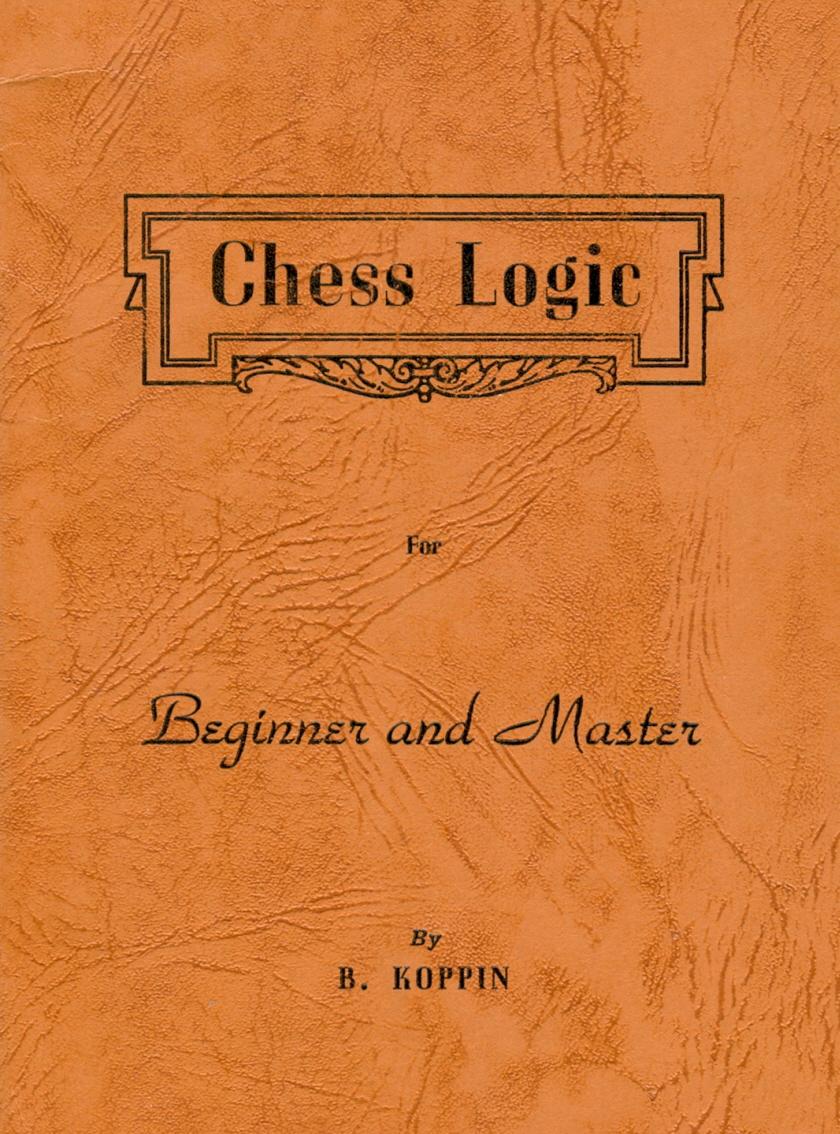
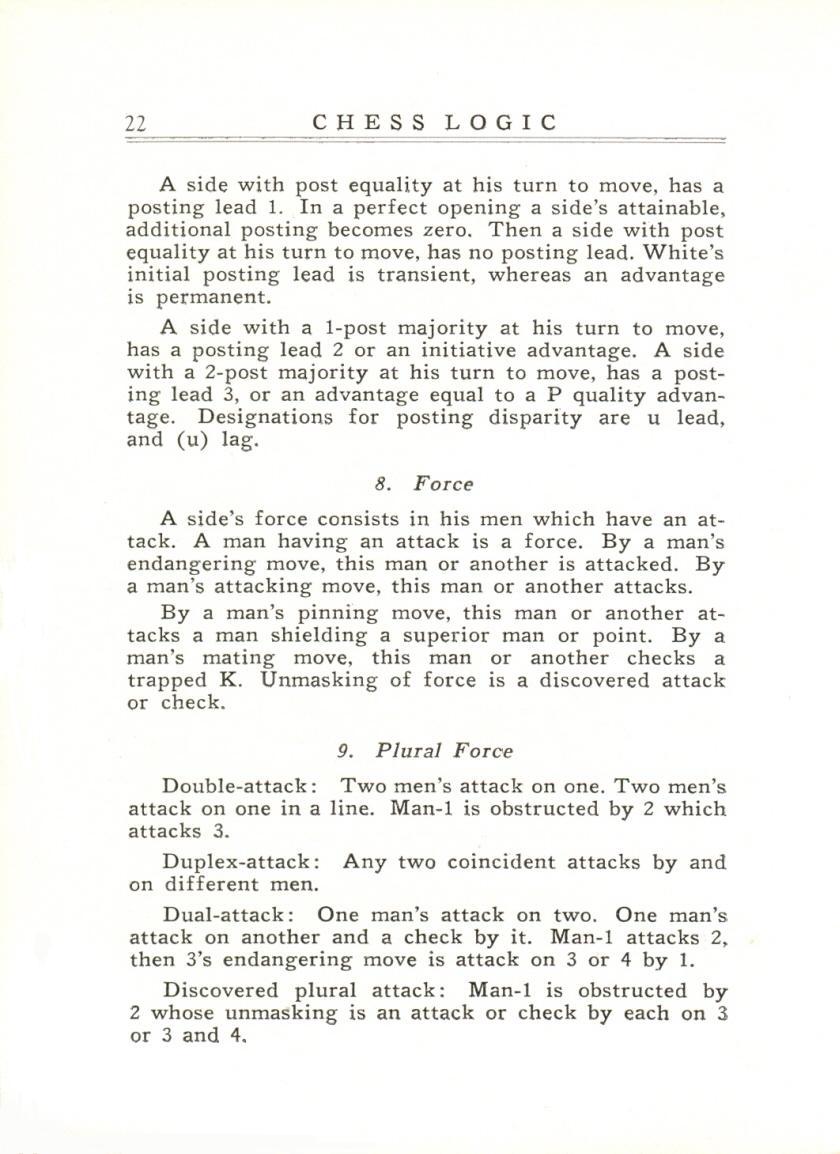
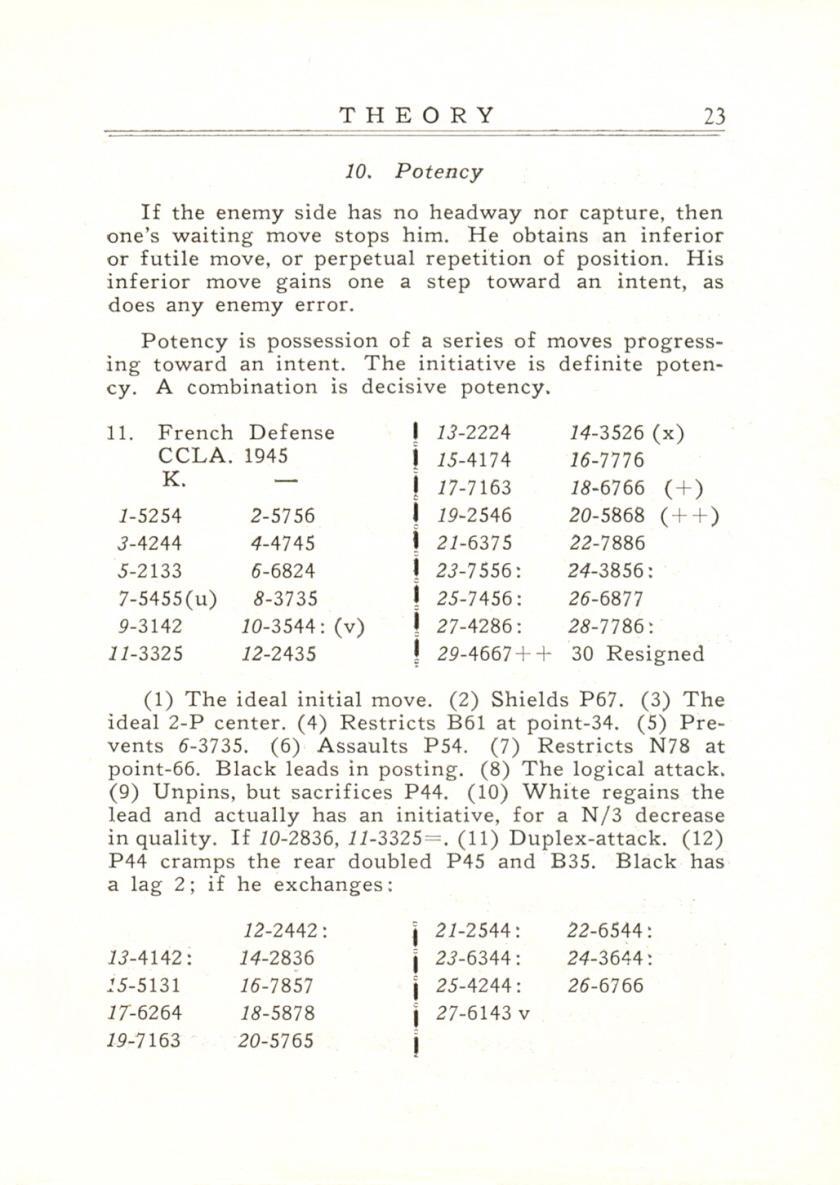
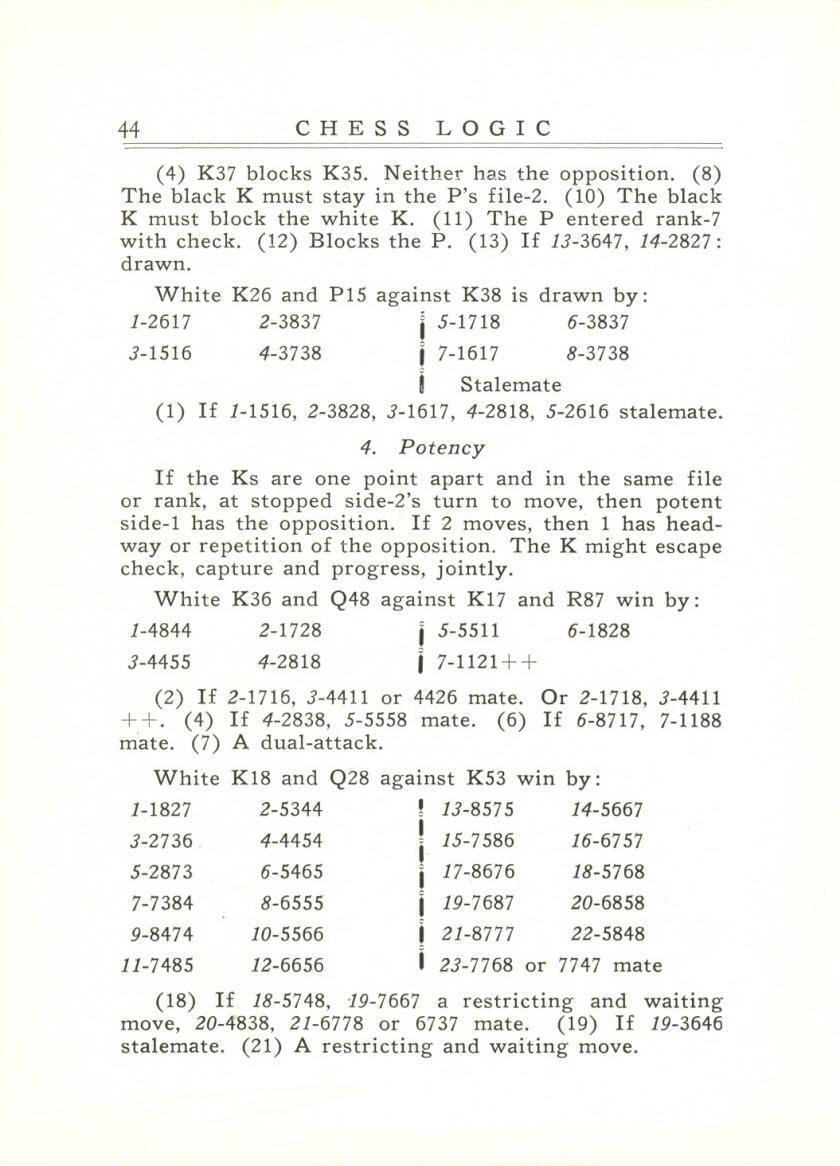
From an article entitled ‘Memories of Boris Kostić’ by C.J.S. Purdy on pages 23-25 of the February 1964 Chess World:
‘I cannot picture him as 76. Like all Australians and New Zealanders who remember him from 1924, I can only picture him in his late 30s – handsome though plump, expansive and genial, highly voluble and able to dish out wise truths or flagrant lies at will in eight different languages. He exuded self-esteem, but his vanity was so naïve that no-one disliked him for it. He was always so entertaining that his foibles were forgiven.’
(2741)
C.N. 1164 (see Memory Feats of Chess Masters) cited William Winter’s reminiscences of the memory feats of Boris Kostić, and it may be recalled that on page 194 of My Chess Career (London, 1920) – although the page number varies in some later editions – Capablanca referred to Kostić’s ‘extraordinary memory’, adding: ‘he knows by heart every game played by a master in the last 20 years, and a considerable number of games of much older date.’
A modified version of the Cuban’s claim was commented upon by C.J.S. Purdy on page 66 of the April 1960 Chess World:
‘He is said to know by heart “every master game played in the last century”. Capablanca published this about Boris Kostić, but when, as a schoolboy, I asked Kostić if it were true he replied that it was absolute nonsense – that Capablanca had wildly exaggerated in order to enhance the value of his easy victory over Kostić in a match.’
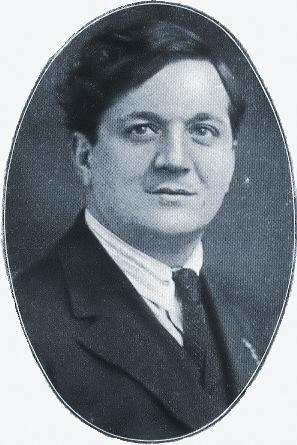
Boris Kostić
(6331)
Some mordant comments by Purdy from page 89 of the July-August-September 1966 Chess World:
‘The worst annotator of all time was Tinsley, who used to edit the chess column of the London Times Weekly [sic] in my boyhood and quite a long time after that. His father was S. Tinsley (an expert who played at Hastings, 1895), and when the father died, the son came along with copy as usual. The management (not chessplayers) took him on, and paid him good money for gibberish over several decades till at long last he died, regretted by none of the many chess-playing readers of the Times in the far-flung outposts of the Empire.
He earned the curses of the chess world, and many players would have reserved him a special corner of Hell where he could receive his weekly cheques as usual but never cash them through all eternity.’
(2742)
An item on pages 394-395 of Kings, Commoners and Knaves:
‘When we discovered André Chéron, in his earlier Traité complet d’échecs, we realized we had discovered the best writer on chess in the world, in the limited sense that he presented his material in the most orderly, lucid and logical way, and expressed his ideas in the clearest and simplest language. His neatness is almost Euclidean.’
C.J.S. Purdy, Chess World, May 1954, page 109.
From pages 396-397 of Kings, Commoners and Knaves:
A feature by C.J.S. Purdy on pages 261‑262 of Chess World, December 1963 entitled ‘How to Talk Like Tarrasch’:
‘We have no doubt that Oscar Wilde brought off a lot of his sallies by trying how various trite sayings sounded back to front – such a lot of his efforts are on the pattern of ‘Work is the curse of the drinking classes’.
Tarrasch’s favourite pattern is seen in:
‘It is not enough to be a strong player: one must also play strongly.’
‘It is not enough to have a won game: one must also win it.’Well worn as these sayings are, most players never completely realize their importance. However, it would be easy to continue on in this strain with:
‘To win, it is not enough that your opponent be a weak player: he must also play weakly.’
‘It is not enough to sacrifice: one must also sacrifice enough.’
‘It is not enough to write down one’s games: one must also write them up.’
‘It is not enough to compose a maxim: one must also be Tarrasch.’
That last one is proved thus. Some years ago a contemporary quoted some sayings allegedly by Tarrasch. We thought they sounded too frivolous for Tarrasch, and after long pondering, realized that we ourselves had written them in a short humorous skit in some old issue of the ACR. There must have been something said therein about Tarrasch which our contemporary misunderstood. Now, nobody else in the world thought those things worth quoting – and rightly so. But one person thought they were by Tarrasch, and that made them extremely witty ...
D.M. Spackman [sic], the American novelist, chess theoretician and correspondence expert, made up a much better parody of Tarrasch than any of ours. His is:
“Chess, like gunfire, like love, has the power to keep men quiet”.’
Page 263 of Kings, Commoners and Knaves pointed out that several chess writers have muddled the basic facts about the Capablanca-Alekhine title match. Although it was played in Buenos Aires, one book put ‘New York’. But now we have ‘Havana’ on page 123 of Action Chess by C.J.S. Purdy (Thinkers’ Press, 2000). This was Purdy’s blunder (Chess World, July 1952, page 150), but somebody involved with the Thinkers’ Press volume might have been expected to notice it.
Incidentally, page 119 of Action Chess has unwittingly reproduced a private marginal note (about the slang word ‘square’ – in the annotations it makes no sense) which Purdy wrote to his printer. His explanation of the mix-up appeared on page 173 of the August 1952 Chess World, but that too has been missed by Thinkers’ Press.
(Chess Café, 1999)
C.J.S. Purdy became involved in a dispute in the Sydney Morning Herald regarding the number of published books on bridge. As reported on pages 154-155 of the November-December 1965 Chess World, an article by Frank Cayley in the Herald of 4 January 1966 had suggested the existence of ‘10,000 books on bridge’. Since this figure exceeded the common estimate of volumes on chess, Purdy risklessly offered $500 to the first person who could prove the 10,000 claim. (‘He will have to write most of the books himself or pay other people to.’) Purdy reported that M.V. Anderson was ‘inclined to place the total number of books in and out of print in various languages at “under 500”.’
(3280)
The fifth game of the 1963 world championship match between Petrosian and Botvinnik began 1 c4 g6 2 d4 Nf6 3 Nc3 d5 4 Nf3 Bg7 5 e3 O-O 6 Be2. For Petrosian’s view of 6 Be2 see pages 395-396 of The Games of Tigran Petrosian Volume I: 1942-1965 compiled by E. Shekhtman (Oxford, 1991).
On pages 237-238 of the October 1963 Chess Life Fischer annotated his game (as Black) against Greenwald at Poughkeepsie, 1963. It began 1 d4 Nf6 2 c4 g6 3 Nc3 d5 4 cxd5, at which point he wrote:
‘This is White’s only chance of gaining any real advantage against the Grünfeld. Much weaker, for example, is 4 Nf3 Bg7 5 e3 O-O 6 Be2? (A genuine beginner’s move). So far, Petrosian-Botvinnik, Game Five, 1963 World Championship Match. Botvinnik now played 6…dxc4? 7 Bxc4 c5? (Better is 7…Nfd7! and then 8…e5) 8 d5! e6 (Better is 8…Ne8.) 9 dxe6 Qxd1+ 10 Kxd1 Bxe6 11 Bxe6 fxe6 and despite all of Black’s lemons, the game is still only slightly better for White, which only proves again the weakness of White’s first move, 1 d4.
Correct for Black after 6 Be2? is 6…c5! and White must play carefully to equalize, e.g.,
(a) 7 O-O? cxd4 8 Nxd4 Nc6 9 cxd5 Nxd5 10 Nxd5 Qxd5 11 Bf3 Qc4 12 Nxc6 bxc6 and Black stands better; Aaron-Gligorić, Stockholm, 1962.
(b) 7 cxd5 Nxd5 8 Qb3 Nxc3 9 bxc3 Qc7 10 O-O b6 11 a4 Nc6 again better for Black; Goglidze-Botvinnik, Moscow, 1935.
(c) 7 dxc5 Qa5 8 cxd5 (8 O-O dxc4 9 Bxc4 Qxc5 with advantage) 8…Nxd5 9 Qxd5 Bxc3+ 10 Bd2 (10 Kf1 Bg7 11 Bd2 Qc7 Black regains the pawn at will, with a strong attack to boot) 10…Bxd2+ 11 Qxd2 Qxc5 12 O-O Nc6 13 Rac1 Qb6 and White should draw with correct play.’
Under the heading ‘And Now Fischer as Annotator’ Purdy wrote on page 7 of the January 1964 Chess World:
‘We like especially the opening paragraph of Fischer’s note to 4 cxd5. It is matchless in the whole literature of chess.’
(3371)
Following the death of Huxley St John Brooks Chess World (1 January 1949, page 23) quoted from the South African Chess Magazine what C.J.S. Purdy described as ‘the best short humorous chess sketch ever written’. It is a seldom-seen genre, and we give the complete text below (proof-read with particular care):
‘“I am playing dam bad this evening”, remarked Mr Bronski, placing his reluctant King gracefully upon its side. “Once again I lose the Old Lady.”
“It is not so you are playing exactly bad, if you understand me”, replied his opponent. “Tonight I am playing too superior for you. Capablanca himself should be losing his Queen in such a wobbly position.”
“It would be because I play the Peasant to Bishop four?”
“That lose, of course.”
“But if I play my Peasant to Bishop three?”, Bronski rejoined with a note of hopeful interrogation.
“That also lose.”
“But if play der Horse and hit your Qveen?”, persisted Bronski.
“Then also I have a plan.”
Bronski sighed and proceeded to set up the pieces for another encounter.
“Chess is a very heavy game”, he said slowly. “If you play qvick you lose your Qveen, and if you doan’t play qvick the other fellow tink so strrong that also you are in trrouble.”’
(3417)
From page 242 of Chess World, November 1952, the writer being C.J.S. Purdy:
‘Sarapu thinks nothing of playing lightning chess at five seconds a move – his opponent seeing the board. Besides Sarapu, Reuben Fine and George Koltanowski are the only players I have heard of who play lightning chess blindfold, but as far as I know they have only played at ten seconds. Dawdlers!’
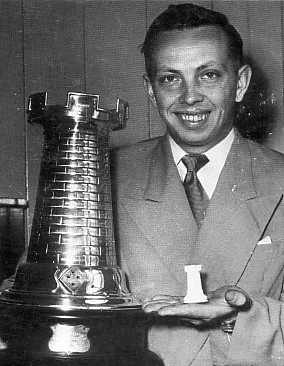
Ortvin Sarapu
(3444)
Purdy’s well-known quote ‘Pawn endings are to chess what putting is to golf’ is often repeated (e.g. on page 280 of Chernev’s The Chess Companion) without any source being specified. We therefore point out that the following appeared on page 71 of Guide to Good Chess by C.J.S. Purdy (Sydney, 1950):
‘Pawn endings are to chess what putting is to golf, with the big difference that they do not occur in every game. They occur just often enough to make them well worth while studying, and they have a fascination all their own.’
(3474)
Gary Lane (Richmond, NSW, Australia) asks:
‘Should the opening sequence in the Nimzo-Indian 1 d4 Nf6 2 c4 e6 3 Nc3 Bb4 and now 4 e4 be known as the Dilworth Gambit?’
We believe that there are strong grounds for the name. Vernon Dilworth contributed an article on 4 e4 (entitled ‘A new move in the Niemtso-Indian Defence’) on pages 136, 137 and 156 of the March 1949 CHESS. He described 4 e3 ‘?’ as seeming ‘wantonly passive’ and suggested 4 e4 ‘!’ as preferable, with the continuation 4...Nxe4 5 Qg4 ‘!’. Some analysis was provided, much of it ‘based on trial games with the strong amateur A. Clegg’, and one such encounter was presented by Dilworth, enthusiastically annotated:
Vernon Dilworth – A. Clegg1 d4 Nf6 2 c4 e6 3 Nc3 Bb4 4 e4 Nxe4 5 Qg4 Nxc3 6 Bd2
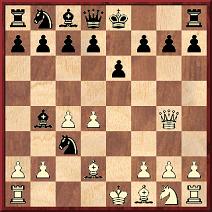
6...Nd5 7 cxd5 Bxd2+ 8 Kxd2 Qf6 9 Nf3 O-O 10 d6 cxd6 11 Bd3 Nc6 12 Rae1 b6 13 Re3 h6 14 h4 Bb7 15 Qe4 Qg6 16 Qf4 Qf6 17 Qxd6 Qe7 18 Qf4 Rac8 19 a3 f5 20 Rg1 Qf6 21 g4 fxg4 22 Qxg4 Ne7 23 Ne5 Rc7 24 Reg3 Qxf2+ 25 Kd1 Resigns. (‘An extremely interesting game, showing to advantage the attacking possibilities of the move 4 e4.’)
CHESS, however, sounded a note of caution:
‘Quite frankly, we doubt whether, in the fury of analysis which followed the introduction of the Niemtso-Indian Defence, 4 e4 failed to be examined. We fear this suggestion is more bold than sound.’
Readers were invited to refute the gambit, and on page 161 of the April 1949 CHESS a 15-year-old-reader from Manchester, I. Lanz, gave some analysis, beginning with 4...Nxe4 5 Qg4 Nxc3 6 Bd2 Nxa2 (a move not mentioned by Dilworth). On page 244 of the July, August and September 1949 CHESS the analytical debate was cut short:
‘We have received several more refutations of Mr Dilworth’s suggestion 4 e4, but have decided that the line really does not merit further discussion.’
After the original CHESS article appeared, the opening was scrutinized by C.J.S. Purdy on pages 134, 135, 136 and 144 of Chess World, 1 June 1949, under the title ‘Pipe-dream Chess’. Examining the above Dilworth v Clegg game in some depth and with some enmity, he wrote of 4 e4:
‘This is the new gambit. At first sight it looks like the only plausible losing move on the board, and that is how it still looks to us.’
After both 4...Nxe4 and 5...Nxc3 Purdy asked ‘why consider any other move?’, adding in the latter case:
‘Sometimes you can reason this way in chess: either this wins or I’m crazy, and if I’m crazy I won’t win anyway. It saves a lot of analysis.’
A number of Clegg’s moves were criticized, and especially 23...Rc7 (it being stated that 23...h5 would have at least drawn). Purdy also commented:
‘It is true that nobody has claimed that the gambit is sound. But the mere discussion of it as a worthwhile line for White is likely to warp the average student’s judgment. Hence the necessity for a counter-demonstration.
Granted, also, this gambit may succeed against very bad play. But any opening on earth will do that.
Some unsound opening variations in chess are well worthy of close study because there is only one way of refuting them. The one under discussion merely requires reasonable care and common sense.’
(3762)
From page 59 of the March 1956 Chess World:
‘Although the BCM has never been guilty of sensation-mongering, in 1893 it carried one of the most startling items of chess news ever published. This was it:
“In the late terrible cholera epidemic at Hamburg, it is remarkable that no chessplayer of the large number living in that city and its suburbs was even attacked by the disease.”
Seeking for some rational cause that might at least partially explain this phenomenon, one remembers the late F.K. Esling’s comment that there was quite a big class of leisured people in Germany when he was there, and that most of the strong players belonged to it; they would presumably live in the less congested and insanitary areas. Esling visited Germany in the ’eighties, and ’93 was not much later.’
The BCM quote had appeared on page 25 of the January 1893 issue, i.e. shortly after publication of the following on page 349 of the November 1892 Deutsche Schachzeitung:
‘Im Hamburger Schachclub fand die Eröffnung der diesjährigen Spielsaison, welche sich in Folge der ungünstigen Zeitverhältnisse etwas verspätet hatte, am Dienstag den 18. October im neuen Locale im Patriotischen Gebäude statt. Der Vorsitzende leitete die Generalversammlung mit einigen Worten der Freude ein darüber, dass kein Mitglied des Vereins von der Cholera betroffen worden ...’
In short, a chess official merely reported that no member of the Hamburg association had caught cholera.
(3763)
The first sentence of an article by C.J.S. Purdy on page 250 of Chess World, November 1956:
‘If asked what I found the most useful principle of chess I should unhesitatingly reply: Reserve the greater option.’
(3769)
‘Reserving options is always good, provided you don’t lose more options than you reserve, or concede a valuable option to your opponent.’
Source: C.J.S. Purdy, Chess World, August 1964, page 123.
(9587)
C.J.S. Purdy was a consummate chess teacher, and it is therefore of interest to note his choice of ‘the very best beginner’s book’, on page 157 of Chess World, October 1963. Below is an abridged version of his remarks:
‘Is there one beginner’s book that is better than all the others? ... Up till now we have never had a sure answer ... Now we have. It is Learn Chess by C.H.O’D. Alexander and T.J. Beach. ... There is not one ambiguous or difficult sentence, or even word, in the whole book. ... We seldom praise a book so highly. We think most chess books have something good in them and are worth reading despite a percentage of twaddle. But here is a book which, for the players it’s intended for, is 100% good. Don’t forget, it is for genuine beginners, not for near-average players. It is excellent for children, and excellent for adults.’
Learn Chess was first published in 1963, in two volumes. It has been republished a number of times, e.g. by Cadogan Chess in 1994 as a single volume (algebraic notation).
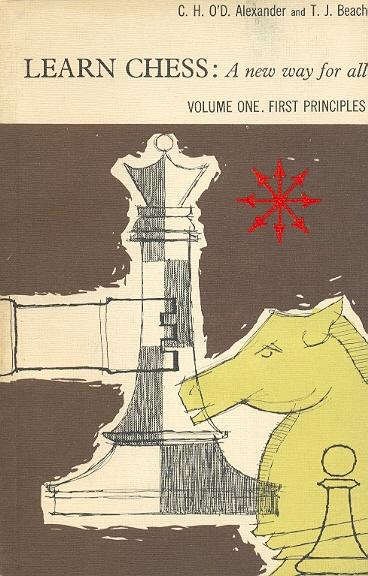
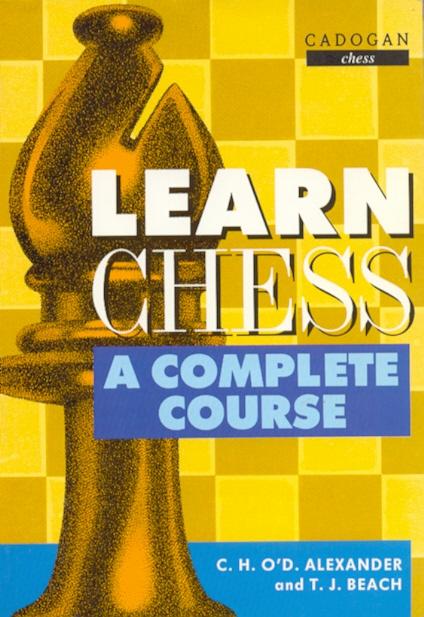
(4017)
C.N. 4017 quoted C.J.S. Purdy’s high praise for Learn Chess by C.H.O’D. Alexander and T.J. Beach on page 157 of Chess World, October 1963.
He reiterated his recommendation (‘the very best book of both theory and practice for raw beginners’) on page 121 of the July-August 1967 Chess World, as well as on the inside front cover of the September-October 1967 issue, where he added:
‘The inexperienced player loses mainly by sheer oversights. He has no “sight of the board”. Nothing is obvious to him. What is wanted is a book to remedy this, and the only way is to concentrate on the “little combinations” that must be seen before you can play at all sensibly. Mere understanding of positional principles helps a bit but not much.
... As we always say, the best books for learners are those that are both theory and practice combined, and we’d add more practice than theory.’
The present-day publisher of Alexander and Beach’s work (two volumes in one) is Everyman Chess.
(9813)
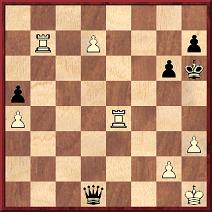
This position arose on 25 November 1962 in a game between C.J.S. Purdy and O. Sarapu on board one of a match by teleprinter between Sydney and Auckland. We quote from pages 16 and 32 of Chess World, February 1963:
‘At the suggestion of Lajos Steiner, the Sydney player [Purdy] was required to demonstrate a win, but he only found time for a little perfunctory analysis which Sarapu could not admit as adequate. As Sarapu is in regular correspondence with Grandmaster Paul Keres, he suggested that he send the position to him to look at, and Purdy naturally jumped at this.
Keres very kindly did look at it, in response to a request from his old friend (they were at school together – we mention this because it would be a solecism to make such a request without a background of this sort). Naturally Keres was not prepared to adjudicate officially, “but”, writes Sarapu, “the variations he shows have convinced me clearly that there is nothing I can do against them.” Accordingly Sarapu admits the game as a loss ...
Keres’ analysis seems so simple that we feel a bit ashamed of not having worked it out even in the short time we permitted ourselves to look at it. In a correspondence game we would no doubt have found it, but equally certainly would have taken a good deal longer than Keres. Readers may like to have a shot themselves. At first sight it seems impossible for White to avoid a draw; not only is it not impossible but Keres shows two ways, though both lead up to the same idea.
... Keres’ winning plan is very simple. White must build a position with g3 and h4, so that if he got both rooks on the seventh and could evade perpetual check, he could mate at h7. So the problem is only to get his king to h2 in that position and his king’s-side rook either to e2 or f2, then play d8(Q), allow Black to take the queen and then double on the seventh rank. Black can then check once, and that is all.
Keres gives two lines that lead to the win. The simpler is 1 Kh2 Qd6+ 2 g3! Qd2+ 3 Kg1 Qd1+ 4 Kf2 Qd2+ 5 Re2 Qd3 (say).
All White has to do then is first to protect his rear rook by playing it to b2, then march back with his king to h2; then play h4; then play his rook back to e2 or f2, whichever is available; then queen the pawn and after ...Qxd8 the final kill by doubling on the seventh. All this assumes that Black has not meanwhile chosen to lose by ...g5.
The second and slower way of doing it starts with 1 Kh2 Qd6+ 2 Kg1 Qd1+ 3 Kf2 Qd2+ 4 Re2.
In the first line, suppose Black comes out with his king, e.g. 6 Reb2 Kg5 7 Kg2 Kf6 (nothing else makes much sense) 8 Rf2+ Ke6 (if 8...Ke7 he gets mated) 9 h4, and White is threatening Rf8. Black can win a rook but then White queens. Nor will ...Qd6 help as White then has Re2+ and Re8. In other words, bringing out the king is only frying-pan to fire.
White has no need to hurry. Using the advanced passed pawn to keep the black queen semi-tied, White can slowly weave his web.’
Most of the game itself had been given on pages 150-151 of the September [sic] 1962 Chess World: 1 d4 Nf6 2 c4 c5 3 d5 e6 4 Nc3 exd5 5 cxd5 d6 6 e4 g6 7 Nf3 Bg7 8 Nd2 O-O 9 Bd3 Re8 10 O-O Na6 11 Nc4 b5 12 Nxb5 Nxe4 13 f3 Nf6 14 Ncxd6 Re7 15 Bc4 Bd7 16 Nc3 Qb6 17 Nde4 Nxe4 18 Nxe4 Bb5 19 Qb3 Nb4 20 Be3 Qa6 21 Bxb5 Qxb5 22 Rac1 Qe2 23 Bxc5 Rxe4 24 fxe4 Nd3 25 Rc2 Qxe4 26 Qb7 Re8 27 Qxf7+ Kh8 28 Kh1 Nxc5 29 Rxc5 Rf8 30 Qxf8+ Bxf8 31 Rxf8+ Kg7 32 Rf1 Qd4 33 Rfc1 Qxb2 34 d6 Qe2. ‘There now followed some tedious repetitions and other manoeuvres, White requiring to gain time on his clock, and the final position on move 50 was as diagrammed [above] ...’
(4031)
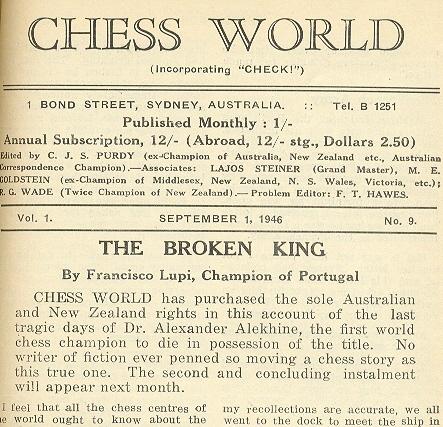
Francisco Lupi’s prime contribution to chess literature was his celebrated two-part article ‘The Broken King’, the full text of which is included in Morán’s book on Alekhine. The English version was originally published in Chess World, 1 September 1946, pages 161-165 and 1 October 1946, pages 185-187. As may be seen above, the Editor, C.J.S. Purdy, accorded it high praise:
‘No writer of fiction ever penned so moving a chess story as this true one.’
(4388)
From page 41 of the March 1963 Chess World:
‘Unquestionably, the most important single contribution to chess literature has been Nimzowitsch’s Mein System (My System in the English version).
... Although the individual Nimzowitsch is dead, he lives on collectively in every chess master to a greater or less degree. Thus Korchnoi is really Korchnoi plus Nimzowitsch, and so forth. Some masters show little of Nimzowitsch in their styles, but all have been influenced by him.
Other great players contributed to chess theory, but their contributions were mainly indirect. None could be compared with Nimzowitsch, whose contribution was direct, original, and not to the few but to the many.’
(4529)
All kinds of opinions, for and against, informed and uniformed, have been expressed about Nimzowitsch’s My System. It is worth noting the view of C.J.S. Purdy, a great author in his own right, on page 62 of Chess World, 1 March 1949:
‘Nimzowitsch’s immortal masterpiece. The greatest of all chess books, in the sense that it has, more than any other, really changed the methods of master players – and equally, of course, those of strong amateurs.
We all hear books described as “must” books, but this is the “must” book.’
(8170)
On pages 174-175 of Chess World, September 1960 Purdy annotated Ujtelky v Barcza, Budapest Zonal tournament, 1960, introduced as follows:
‘Real Nimzowitsch!
Barcza produces a manoeuvre to delight the heart of Nimzowitsch, who once won a brilliancy prize with the move N-KR1.’
1 c4 e5 2 g3 d6 3 Bg2 f5 4 e3 Nf6 5 d4 Be7 6 Ne2 c6 7 b3 O-O 8 Bb2 Nbd7 9 Nbc3 Qe8 10 a4 a5 11 Ba3 Nb8 (‘A brilliant bit of strategy. The goal is QN5.’) 12 Qd2 Na6 13 O-O-O Nb4 14 d5 c5 15 f3 Bd7 16 h3 Qg6 17 Rhg1 Ne8 (‘Another knight retreat. As the game is so blocked, tempos don’t count, but rather placing.’) 18 f4 Bf6 19 Kb1 Nc7 20 Bf1 Rae8 21 Bc1 Re7 22 Qe1 Rfe8 23 Qf2 Ra8 24 Qg2 Kh8 25 Bd2 Qe8 26 Nc1 exf4 27 gxf4 Rxe3 28 Bxe3 Qxe3 29 N3e2 Bxa4 30 Nd4 Bd7 31 Nc2 Nxc2 32 Kxc2 Qc3+ 33 Kb1 Qa1+ 34 Kc2 Qb2+ 35 White resigns.
An advocate of N for knight was C.J.S Purdy, in a letter on page 326 of the August 1934 BCM. After announcing that he was ‘abandoning the international notation scheme’ he remarked:
The Australasian Chess Review thus switched from Kt to N in the mid-1930s.‘What I would like to see, however, is the general use of N for knight. All the columns in Australia use it now, except Gundersen’s, and the ACR will soon follow. I am going to circularize all English and American columns and magazines, but of course the BCM sets the standard.
N is laid down as absolutely alternative by the BCF. The aesthetic objection is purely superficial, for the letters are symbols, not primarily abbreviations (when they would require points after them), so that the first significant letter in knight is the most logical possible to use. I consider it more logical than S, which is not sanctioned officially ...’
(4503)
The conclusion to Fischer’s draw against Botvinnik at the Varna Olympiad in 1962 has also given rise to discussion, on a human level. On page 153 of Analiticheskiye I Kriticheskiye Raboti 1957-1970 (Moscow, 1986) Botvinnik reported that Fischer was distraught as he left the hall. To quote the English translation on page 183 of volume three of Botvinnik’s Best Games (Olomouc, 2001):
‘Only here, with his face [as] white as a sheet, did Fischer shake my hand, and with tears in his eyes he left the hall.’
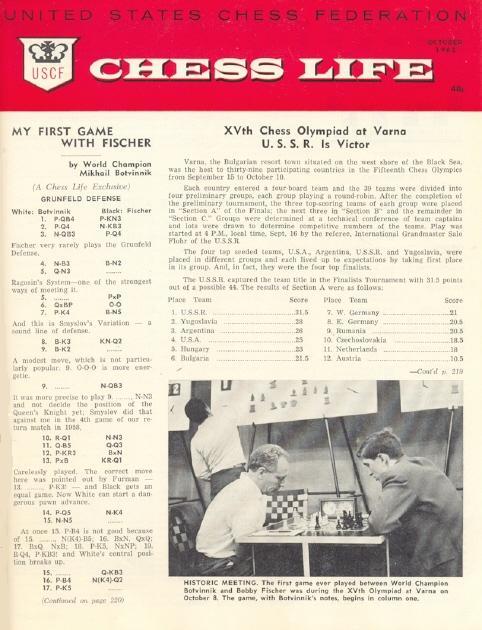
The matter arose on page 137 of the September 1963 Chess World when C.J.S. Purdy was discussing Alexander Kotov:
‘I also knew that he was a very kindly writer. I have never known him to treat anyone unkindly in print. By contrast, his countryman Flohr, a clever journalist, handled Bobby Fischer almost spitefully, when he reported that after he had only succeeded in drawing with Botvinnik in Varna, after having a winning advantage, he left the room and, having reached the corridor, burst into tears. As Fischer probably thought he was alone by then, it was cruel to record such a thing, but Flohr knew it was good “copy”. Kotov would never initiate such a story. Nor would I myself; I am prepared to use it once it has been made public already, for I am not a censor, but I think Kotov is too kind even to do that ...
I do not decry Flohr. There is virtue in sheer truth. But Flohr could have written sympathetically or purely factually, without spiteful overtones.’
Can a reader quote Flohr’s exact words?
(4595)
As shown in C.N. 2750 (see pages 335-337 of A Chess Omnibus), Chess (Basics, Laws and Terms) by B.K. Chaturvedi (Chandigarh, 2001) copied extensively from Chess Made Easy by C.J.S. Purdy and G. Koshnitsky.
(4683)
In a number of C.N. items (listed on page 271 of Chess Explorations) Cecil Purdy’s year of birth has been discussed. It used to be given as 1907 but now appears in reference books as 1906. In the entry for Purdy in Jeremy Gaige’s Chess Personalia (Jefferson, 1987) one of the citations is the announcement of his birth on page 1 of The Times (London) of 26 May 1906. Below is the text:
‘PURDY – On the 27th March, 1906, at Port Said, to EMILY and J.S. Purdy, M.D., F.R.G.S., Surg.-Capt., New Zealand Militia, a son (CECIL JOHN SEDDON). New Zealand papers, please copy.’
That might be regarded as putting an end to the matter, but, as mentioned in C.N. 1623, page 146 of the 1 July 1949 issue of Purdy’s own magazine, Chess World, stated that he was born, in Port Said, in 1907.
Lest that be thought an isolated erroneous reference, we add that 1907 was given too in an article about Purdy by Gunars Berzzarins on page 282 of the December 1951 Chess World. Also before us lies the second edition of Purdy’s book Guide to Good Chess (Sydney, 1951). Once again, the year stipulated (in a ‘thumbnail biography’ from Who’s Who in Australia) was 1907. Page 161 of the August 1960 Chess World had a biographical feature on Purdy, and it too put 1907. Jeremy Gaige was still giving 1907 in the revised edition of A Catalog of Chessplayers & Problemists (Philadelphia, 1971).
However, 1906 was the year presented by Anne Purdy (whom he married in 1934) on page 14 of C.J.S. Purdy His Life, His Games, and His Writings edited by J. Hammond and R. Jamieson (Melbourne, 1982). Assuming that Purdy was not born in 1907, we wonder when exactly he found out.
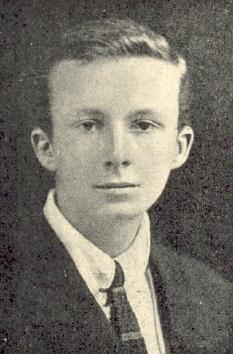
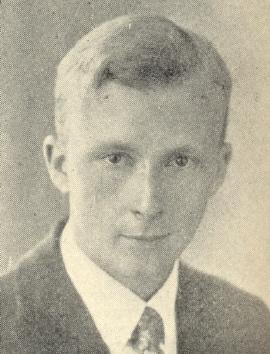
C.J.S. Purdy in the 1920s (from page 284 of Chess World, December 1951)
(4924)
‘Error is the lifeblood of chess’, wrote C.J.S. Purdy on page 52 of the 1 March 1949 issue of Chess World concerning the following position:
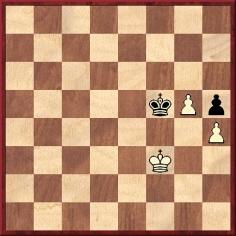
White to move
The full paragraph was:
‘Error is the lifeblood of chess. Not only must the greatest masters inevitably make errors in play, but also writers in books – unless they confine themselves to exceptionally easy positions.’
After praising C.H.O’D. Alexander’s Chess (first published in 1937 and reissued in the 1940s), Purdy noted that Alexander had given the position on page 109 and the following solution on page 120:

On page 72 of his magazine Purdy commented:
‘Most errors in analysis arise through taking something for granted. In chess, you must always be taking something for granted, or you could hardly ever come to a decision at all – hence the inevitability of error. On move 7, Alexander has assumed as a matter of course that the white king will take the opposition. We are all taught that the opposition is the great desideratum in pawn endings. The trouble is that every generalization in chess breaks down – sometimes. Here White can win by deliberately giving Black the opposition, temporarily.
Thus, 7 K-K5! This enables White to force the win of the black pawn and win easily, e.g. 7...K-N2 8 K-B5 K-B2 9 P-N6ch, etc. Or 7...K-K2 8 P-N6.
After 7 K-B5 K-N2 the book says White has “nothing better” than 8 P-N6. This, again, is wrong; with a little shuffling, White can “change the move” and still win, e.g. 8 K-K5 K-B2 9 K-Q6 K-N2 10 K-K7 K-N3 11 K-K6 K-N2 12 K-B5, etc. Indeed, with the pawns as diagrammed, White can win no matter where the kings are.
But in the diagram, if you move all the pawns [and the kings, of course] one rank or two ranks nearer to Black’s side, then it really is a draw.
Here we have two paradoxes: (a) that taking the opposition on move 7 is bad, (b) that if White is nearer queening he is worse off. Both paradoxes arise because of the law of stalemate, which is itself paradoxical.
These draws nearly always involve a rook’s pawn. There is one exception. In the diagram move the pawns two ranks nearer Black’s side and one file to the left – still a draw. If you take all these statements for granted, they are well-nigh useless; all should be verified, which is quite easy, and you will then really benefit.’
It seems that Purdy’s correction did not come to Alexander’s attention, for the faulty solution still appeared on page 105 of the final edition of his book, Alexander on Chess (London, 1974).
A mirror image of the same pawn ending (demonstrated as a win) was given on page 42 of volume four of Comprehensive Chess Endings by Y. Averbakh and I. Maizelis (Oxford, 1987).
(5479)
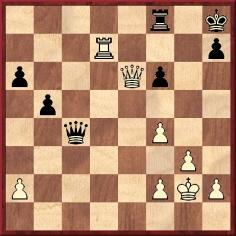
In this position, Black has just played 32...Qc1-c4. White exchanged queens and brought about his opponent’s resignation at move 46. This ending (Flohr v Noteboom, Hastings, 1930-31) was discussed on pages 4-6 of Practical End-Game Play by Fred Reinfeld (London, 1940), but when a copy of the book was awarded to C.G. Watson a decade later C.J.S. Purdy wrote on page 240 of Chess World, 1 October 1950:
‘Thanking us for it, he characteristically pointed out a flaw in the very first position in the book – “just to show he had looked at his prize”.
... Flohr exchanged queens and won a hard endgame. Instead, Watson points out a very pretty smash by 33 Q-K7 Q-N1 (forced) 34 R-Q8.
Black has to accept the rook, then White quickly wins it back, swaps queens, then plays K-B1 with two pawns up and a fatuously easy win in the pawn ending.’
Below is the full game, from page 14 of Československý Šach, January 1931:
Salo Flohr – Daniël Noteboom1 d4 Nf6 2 c4 e6 3 Nc3 Bb4 4 Qc2 c5 5 dxc5 Bxc5 6 Nf3 b6 7 g3 Bb7 8 Bg2 d5 9 O-O dxc4 10 Qa4+ Bc6 11 Qxc4 Qc8 12 b3 Qb7 13 Bb2 Nbd7 14 b4 b5 15 Qb3 Be7
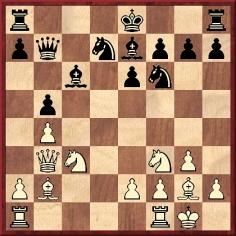
16 Bh3 Bxf3 17 exf3 O-O 18 f4 Rad8 19 Rfe1 a6 20 Bxe6 Bxb4 21 Qxb4 fxe6 22 Rxe6 Rde8 23 Rae1 Rxe6 24 Rxe6 Qc8 25 Ne4 Nxe4 26 Rxe4 Nf6 27 Re7 Qd8 28 Qb3+ Kh8 29 Qe6 Qc8 30 Bxf6 gxf6 31 Rd7 Qc1+ 32 Kg2 Qc4 33 Qxc4 bxc4 34 Rc7 Rb8 35 Rxc4 Rb6 36 Rc7 Rb2 37 Rc6 Rxa2 38 Rxf6 Kg7 39 Rb6 Ra5 40 g4 Ra4 41 Kg3 Ra3+ 42 f3 h6 43 h4 a5 44 g5 h5 45 f5 Ra1 46 Rb7+ Resigns.
Flohr contributed some notes to the Czech magazine but wrote nothing after move 20.
(5617)
‘The isolated queen’s pawn is an important learning element in chess strategy. The late Bob Wade first coined the term IQP in his 1963 book on the World Championship match between Botvinnik and Petrosian.’
Source: Raymond Keene, in his chess column in The Times, 11 April 2009.
With Google Books it takes about ten seconds to find earlier occurrences of ‘IQP’, one instance being in The Return of Alekhine by C.J.S. Purdy (Sydney, 1938). We add that the text in question, concerning the nineteenth match-game between Euwe and Alekhine, had already appeared on page 349 of Purdy’s Australasian Chess Review, 20 December 1937:
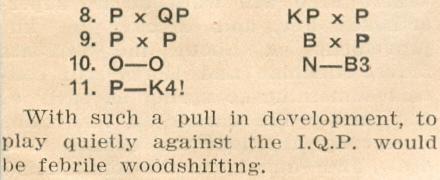
For our part, we would never claim that even Purdy ‘first coined the term IQP’ (or that it was only in 1937 that he first used it).
(6074)
To our Zugzwang article we shall be adding this comment by C.J.S. Purdy on page 34 of the February 1960 Chess World:
‘Zugzwang just doesn’t happen in a middle-game. There is a win by Nimzowitsch against Sämisch in the middle-game which one annotator has called a “Zugzwang” finish. It is true that any move by Sämisch loses, but he would lose just as surely if his opponent had to move. It is not the compulsion to move that hurts him; his position is lost anyway. So it is no more Zugzwang than any other resignable position.’
(6756)
Regarding The Luzhin Defense, a notable review by C.J.S. Purdy was published on pages 30-32 of Chess World, February 1965. Purdy did not mention von Bardeleben but considered it likely that ‘the story of Rubinstein gave Nabokov part of the idea’.
(6852)
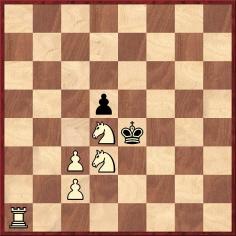
‘What is the smallest number of moves in which White can mate?’
From page 27 of “Among These Mates” by Chielamangus (Sydney, 1939):
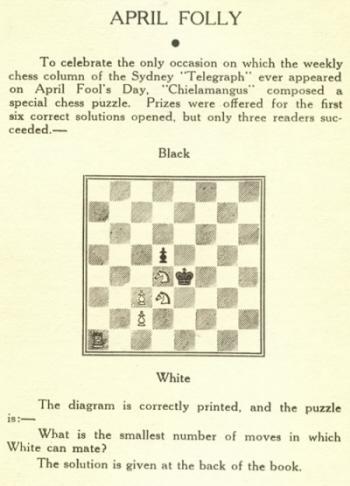
And from page 79:
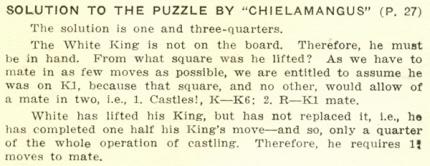
An item on pages 178-179 of A Chess Omnibus noted that C.J.S. Purdy attempted to make light of Hitler in a satirical one-act play ‘Hell Hitler’ in “Among These Mates” (Sydney, 1939), a book which he published under the pseudonym Chielamangus. The dramatis personae were Shade of Napoleon, Shade of Hitler, and Satan, and the play was founded on a spoof Hitler v Napoleon game: 1 e4 e5 2 Bc4 Bc5 3 Nf3 d6 4 d3 Be6 5 Bxe6 fxe6 6 Be3 Nd7 7 Bxc5 dxc5 8 Nbd2 Ne7 9 O-O O-O 10 Nc4 Ng6 11 c3 Qf6 12 Qb3 Nf4 13 Ne1 Qg5 14 Kh1 Rf6 15 Qxb7 Raf8 16 Qxc7 R8f7 17 Rg1 Qh4 18 Qc8+ Nf8 19 Ne3 Qxh2+ 20 Kxh2 Rh6+ 21 Kg3 Ne2+ 22 Kg4 Rf4+ 23 Kg5 Rh2 24 Qxf8+ Kxf8 25 Nf3 Kg8 26 Nxh2 h6+ 27 Kg6 Rf5 28 exf5 Nf4 mate.
This score was based on the famous brilliancy F. Herrmann v H. Hussong, Frankfurt, 1930 published on pages 314-315 of the October 1930 Deutsche Schachzeitung, October 1930, and, with Alekhine’s notes taken from Denken und Raten, on pages 340-342 of the December 1930 issue of Kagans Neueste Schachnachrichten:
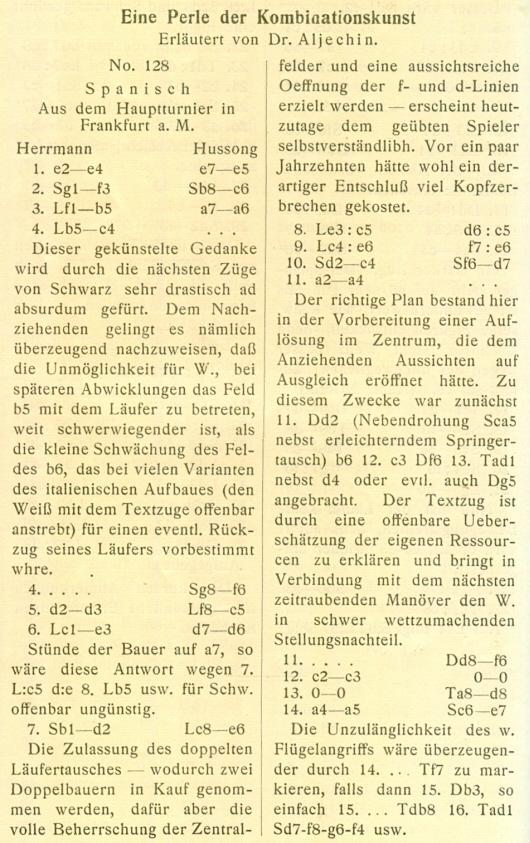
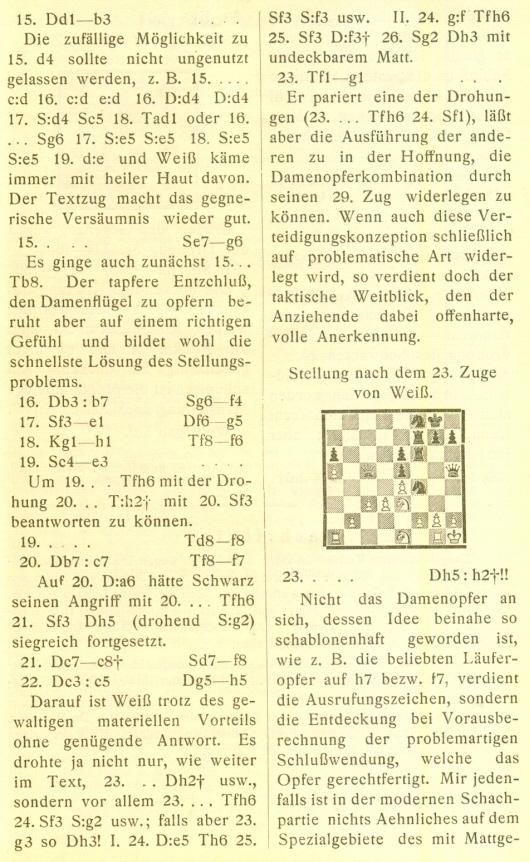
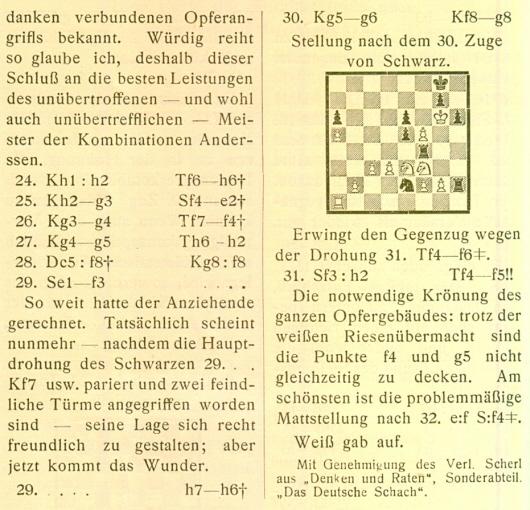
Below, from Purdy’s book, is the illustration on page 6 and the conclusion of the play on page 11:
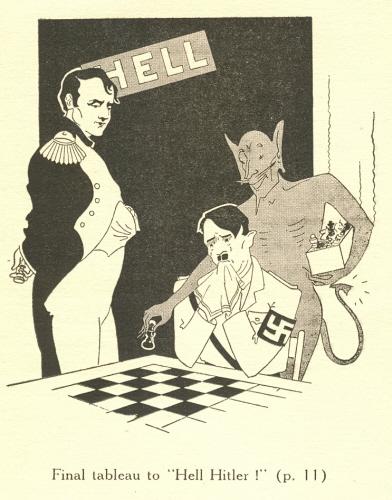
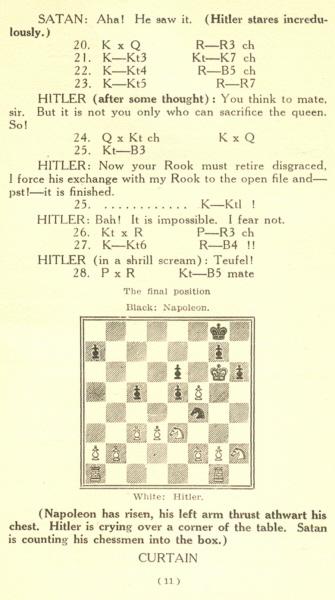
In conclusion, we add the following from page 8 of the October 1944 Chess Review:
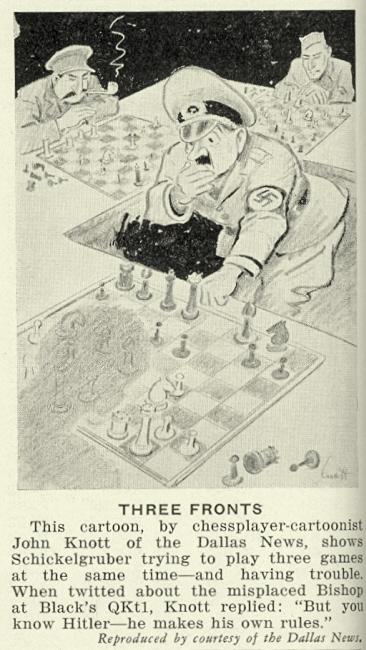
(7402)
On pages 30-32 of the February 1953 Chess World M.E. Goldstein (Black) annotated his win against F.A. Crowl. The first note, to 3 Be2, began:
‘A favourite début of Tartakower and Crowl. In fact, 20 years ago Crowl played this opening so often that he was nicknamed “the Limited Bishop”.’
A game on pages 135-136 of the November-December 1965 issue of Chess World again mentioned Crowl:
‘The Limited Bishop’s Gambit has probably never been so minutely analysed as in the Australasian Chess Review of 1930. At one time this opening was so actively sponsored by Crowl that F.L. Vaughan christened him the Limited Bishop, and this was where “Chielamangus” [a pseudonym for Purdy] got the title for his one-act play.’
The play had been published on pages 17-26 of “Among These Mates” by “Chielamangus” (Sydney, 1939). Below are pages 20 and 23:
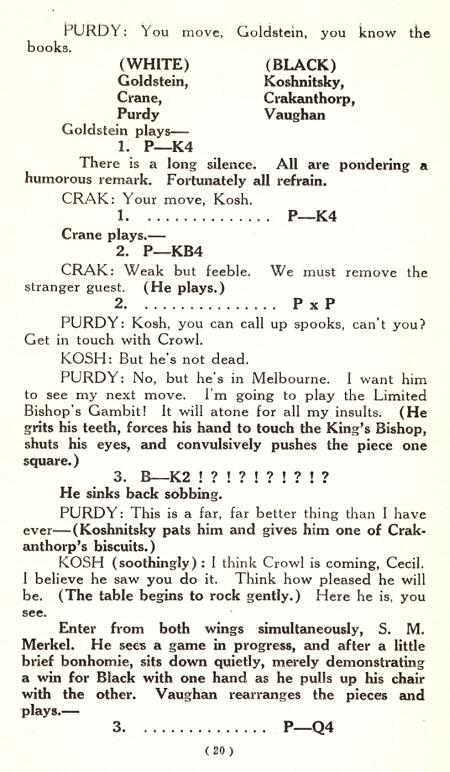
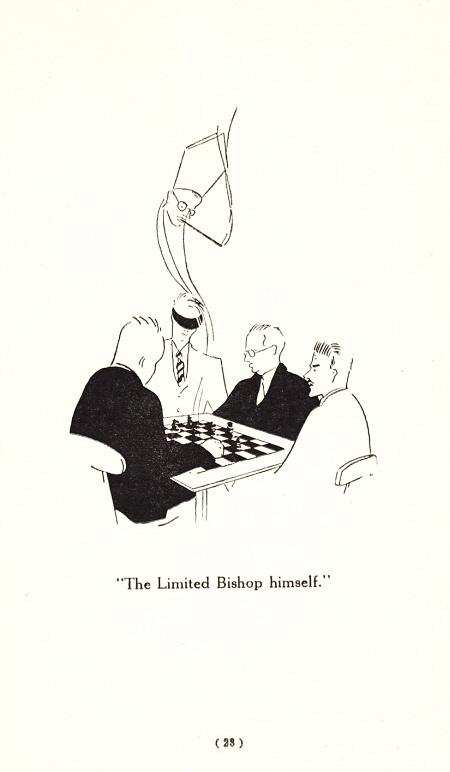
(7583)
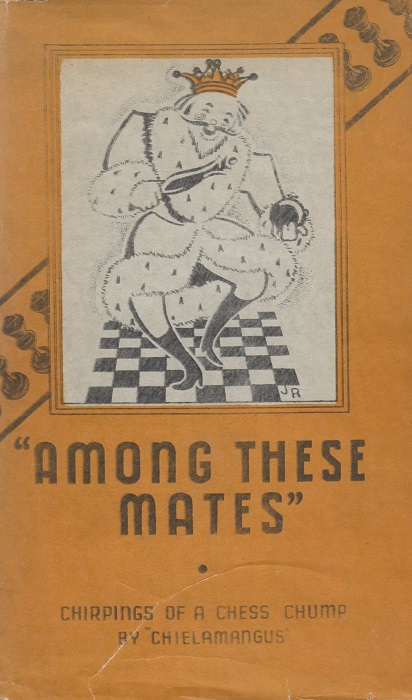
A review by Julius du Mont on pages 139-140 of the May 1941 BCM:
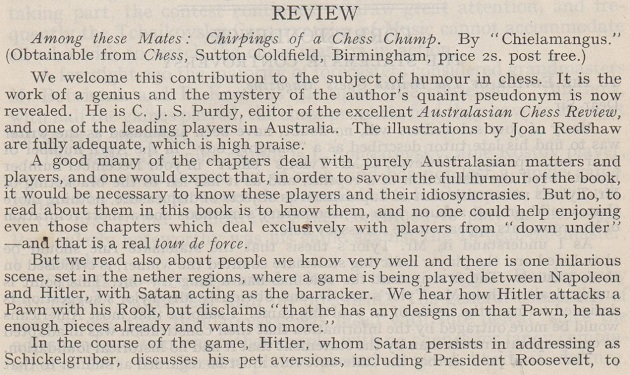
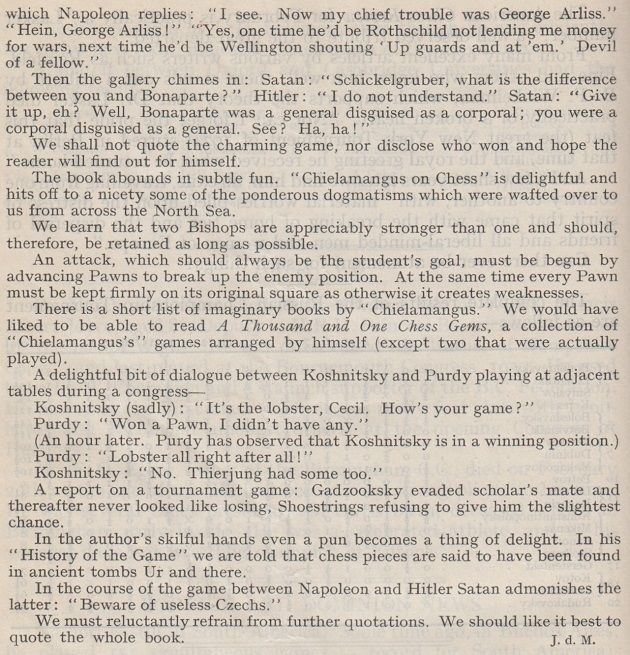
On page 271 of C.J.S. Purdy’s Australasian Chess Review, 31 October 1938 the following appeared:
‘We consider Botvinnik the most brilliantly searching annotator in the world – the ordinary junk written by annotators doesn’t go down in Russia, where there are thousands who can pull bad notes to pieces.’
(7819)
Larry Evans had a habit of lifting other writers’ bons mots and prose for presentation as his own. For example, on page 71 of Guide to Good Chess (Sydney, 1950) C.J.S. Purdy wrote:
‘Pawn endings are to chess what putting is to golf, with the big difference that they do not occur in every game.’
Two misappropriations:
L. Evans, on page 270 of Chess Life & Review, May 1970.
L. Evans, on page 29 of Evans on Chess (New York, 1974).
(8221)
An item from our collection (the Australian team at Nice, 1974):
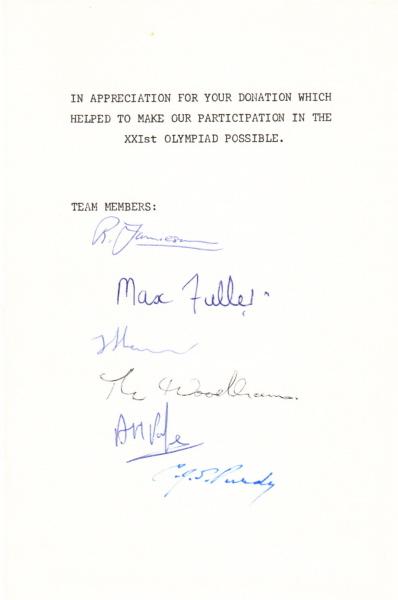
Page 80 of “Among These Mates” by “Chielamangus” (Sydney, 1939) comprised an advertisement for a forthcoming book by C.J.S. Purdy (whose pseudonym was “Chielamangus”) which never came forth:
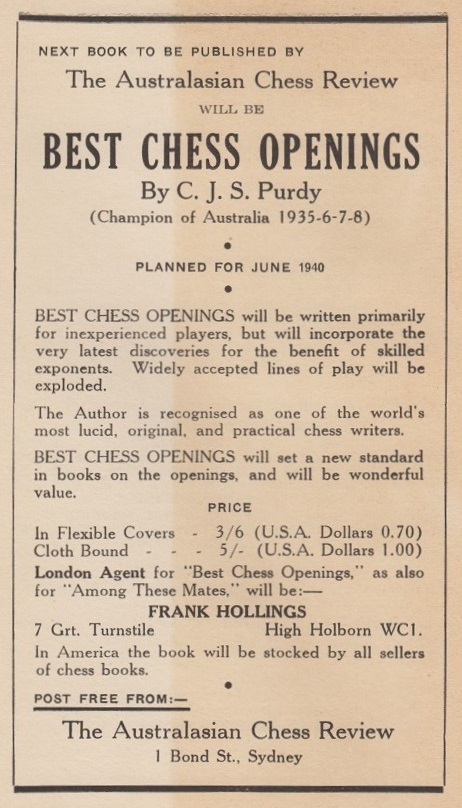
(8928)
On the subject of Chess Advertisements Ian Rogers (Carlton, NSW, Australia) sends the following (page 26 of Woman’s Day, 18 May 1959):
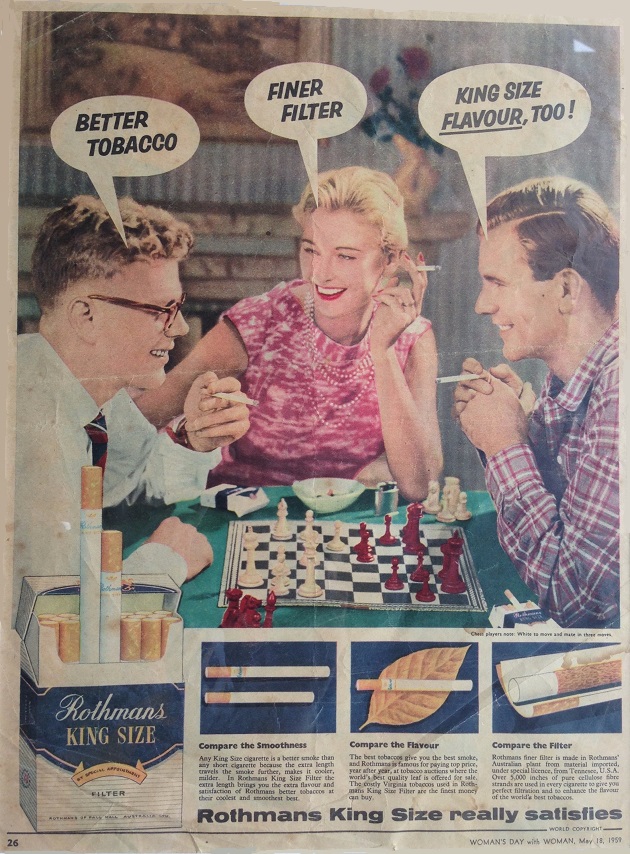
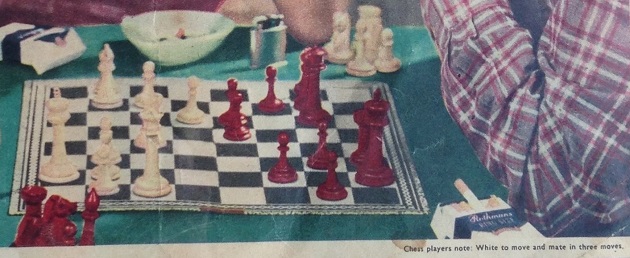
On the left is the former (and future) Australian chess champion John Purdy. The page has been provided courtesy of his widow, Felicity.
(9061)
The discussion of The Art of The Checkmate by G. Renaud and V. Kahn in C.N. 9149 referred to C.J.S. Purdy’s review (in Chess World, December 1955, pages 269-270) of the edition published by Bell in 1955. For example, Purdy wrote:
‘... the translation of Renaud’s and Kahn’s work reaches what I sincerely hope is an all-time low. I am no French scholar, but any fourth-former could fault this stuff. It’s murder.
In almost every page one finds sentences that are not translations at all, or even paraphrases ...’
The ‘thought for the month’ on the inside front cover of the October 1950 Chess Review, in ‘Chernev’s Chess Corner’:
‘“Chess is as much a mystery as women” – Purdy.’
See too page 1 of Winning Chess by Irving Chernev and Fred Reinfeld (New York, 1948). How far back can this well-known remark be traced?
(9211)
We now note the following on page 5 of the Australasian Chess Review, 20 January 1938:
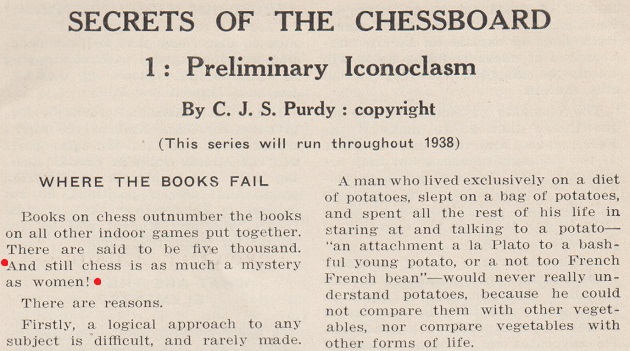
(11688)
‘One of the chess books of the century’ was discussed by C.J.S. Purdy on page 140 of Chess World, 1 June 1948. ‘We have searched for some fault so that our review should not be all praise, but we have searched in vain. No, we must congratulate the authors on a brilliant idea executed with meticulous attention to every detail.’
Purdy also wrote:
‘... the ordinary beginner’s book plunges into a slough of dull verbiage. But how can you explain chess without words?
Well, the miracle has been accomplished as far as is humanly possible in Invitation to Chess by Kenneth Harkness and Irving Chernev.’
The book, based on material which had appeared in Chess Review, was first published by Simon & Schuster, New York in 1945, and an advertisement on the inside front cover of the June-July 1945 Chess Review called it ‘the most revolutionary chess primer ever published’. The book’s early sales were reported in a full-page advertisement on page 9 of the November 1945 Chess Review. The relevant half of that page:
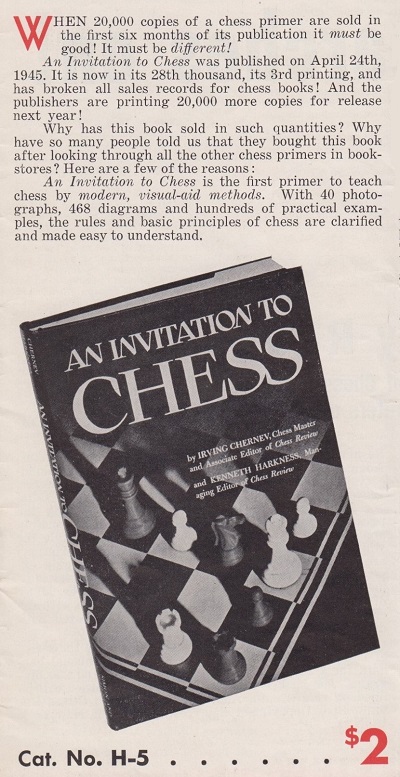
An Invitation to Chess was also published by Faber and Faber Limited, London in 1947.
(9212)
A remark by Cecil Purdy on page 16 of the Australasian Chess Review, 25 January 1939:
‘It is usually no harder to win a drawish game than a losish game, and the latter has the disadvantage that you may lose.’
(9225)
Below, from page 1 of the 1 January 1949 issue of Chess World, is a remark by Purdy at the start of a letter to the editor from J. Hibbert, as quoted in C.N. 1622 (see page 246 of Chess Explorations):

(9235)
‘An open game can never be forced upon you, whether you are Black or White; a close game always can.’
Source: C.J.S. Purdy, Chess World, 1 February 1950, page 43.
(9285)
E.A. Znosko-Borovsky’s article in Le monde des échecs (C.N. 9208) appeared in an English translation, ‘The Ruy López: A Bad Opening’, on pages 234-237 of Chess World, 1 December 1946. In his introduction Purdy wrote:
‘Even beginners know that the Ruy López has long been considered the strongest opening for White. This is therefore the most provocative article on chess theory ever published.’
See too ‘The Ruy’s Revenge’ by W. Ritson Morry on pages 17-19 of CHESS, October 1947; the second of two annotated games was Znosko-Borovsky’s (readily available) loss to K.P. Charlesworth at Harrogate in August 1947, on the black side of a Ruy López.
(9305)
C.J.S. Purdy’s comments on the word ‘equality’, on page 93 of Chess World, 1 April 1950:
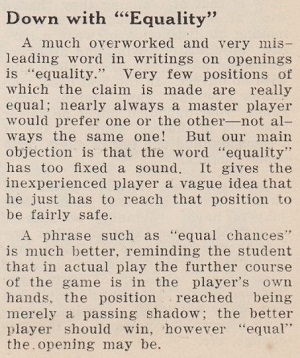
(9311)
C.J.S. Purdy wrote the following at the start of an article about the Evans Gambit, ‘“Evans” in World Title Tourney’, on pages 90-91 of Chess World, 1 April 1950:
‘An Evans Gambit – even if declined and if the game itself is nothing wonderful – is always “news”. This is not only because of its romantic story but because it still stands as one of the few unrefuted genuine gambits.
The Evans Gambit never wore swaddling clothes. Like Minerva it was born in panoply. The very first known game in which it was played was between its inventor and a great master of those days, Alexander McDonnell, and the inventor won.’
The most detailed historical account of William Davies Evans and the gambit is on pages 9-34 of Eminent Victorian Chess Players by Tim Harding (Jefferson, 2012).
(9322)
From page 170 of Chess World, 1 July 1949:
‘One of the best things about chess is that physical death means so little to it. Alekhine is just as alive now to millions of players as he ever was in his lifetime. They never saw him. To them, even while he lived, he was simply the games which he played and which they played over. Those games are as alive now as they were when played. The sad part is that there will be no more. Yet there are enough for most players to go on with. It takes immeasurably longer, for instance, to play through the published games of Alekhine intelligently than the published music of Beethoven. And there’s this great advantage, that whereas the ordinary music-lover has to have his Beethoven played by others, the chess-lover can play through his Alekhine himself.
There was a phrase used by Dr Woinarski on page 37 of the ACR [Australasian Chess Review] of March 1943, referring to the late Gunnar Gundersen: “A personal immortal game is chess.” If anyone found it obscure at the time, it will be clear to him now.’
(9324)
A common error is Australian Chess Review, rather than Australasian Chess Review. See, for instance, The Encyclopedia of Chess by H. Golombek (London, 1977 and Harmondsworth, 1981) and The Batsford Chess Encyclopedia by N. Divinsky (London, 1990).
A remark by Imre König about Leonard Barden in a report on the 1949 British championship in Felixstowe:
‘Barden’s knowledge of theory is extraordinary, he is a walking compendium of MCO and Bilguer.’
Source: BCM, September 1949, page 312.
After quoting this on page 282 of the 1 December 1949 Chess World, C.J.S. Purdy wrote:
‘Understatement! He is years ahead of the latest editions of both. Barden is 20 – a modern history student at Oxford.’
(9348)
A comment by C.J.S. Purdy about A Guide to Chess Openings by Leonard Barden (London, 1957), on page 104 of the April 1957 Chess World:
‘... it’s the best book on openings ever.’
(9928)
When presenting Réti v Alekhine, Baden-Baden, 1925 (under the heading ‘The Gem of Gems’) on pages 110-111 of the 1 June 1946 issue of Chess World, C.J.S. Purdy wrote:
‘We disagree with Mr Goldstein when he says that Alekhine’s chess is easier for the ordinary player to understand than Capablanca’s. Capablanca’s moves may often surprise, but usually their logic is soon apparent after examination. But many of Alekhine’s moves depend on some surprise that comes far too many moves ahead for an ordinary mortal to have the slightest chance of foreseeing it. Alekhine’s chess is like a god’s. One can revere, but never hope to emulate.’
(9384)
On pages 120-122 of the May 1946 issue of Le monde des échecs Tartakower annotated the game Najdorf v Cortlever from the 1939 International Team Tournament in Buenos Aires. His concluding notes:
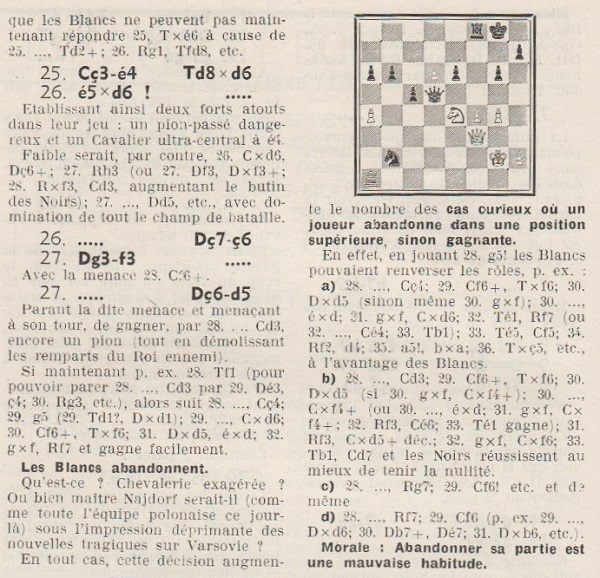
The game was also given on pages 226-227 of Chess World, 1 November 1946, under the title ‘Resigns??’. After quoting Tartakower’s final note (including ‘Moral: Resigning is a bad habit’), Purdy commented:
‘We hope beginners will not use Dr Tartakower’s witticism as an excuse for dragging on hopelessly lost games. Friendly games, by the way, should be resigned earlier than match games. By resigning quickly, you give time for another game – more fun and more practice.’
(9400)
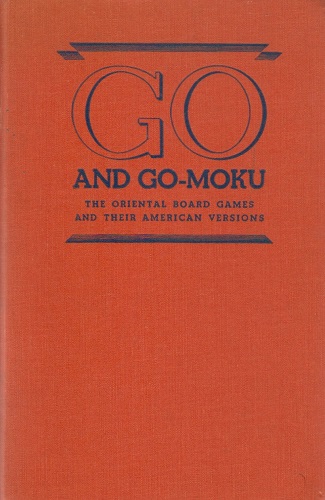
In 1934 Edward Lasker brought out a 214-page book Go and Go-Moku. A revised edition was issued by Dover in 1960, and below is the title page of our signed copy:
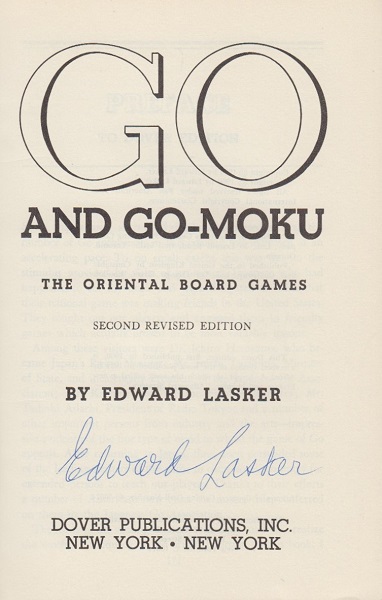
Lasker included a lengthy appendix on Go in the Philadelphia, 1945 edition of Modern Chess Strategy:
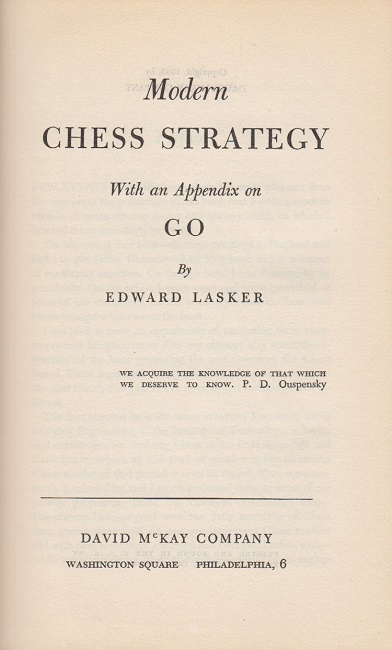
The book had two photographs, between pages 368 and 369:
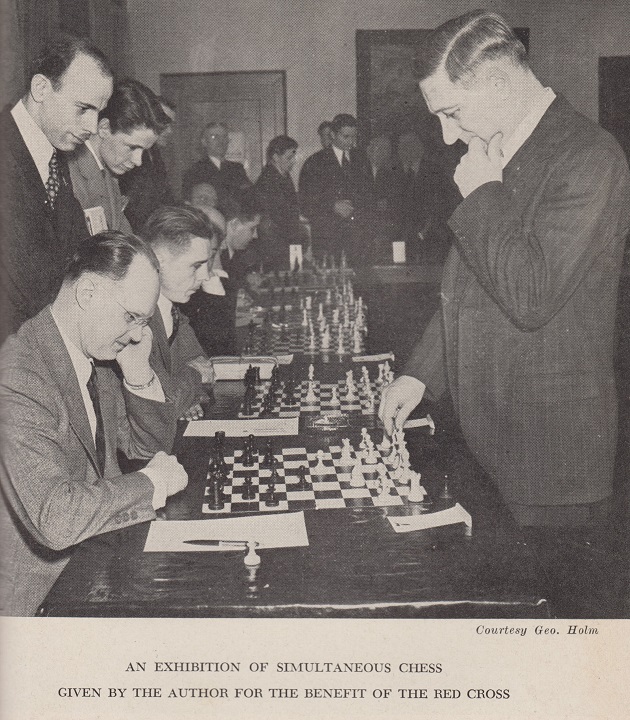
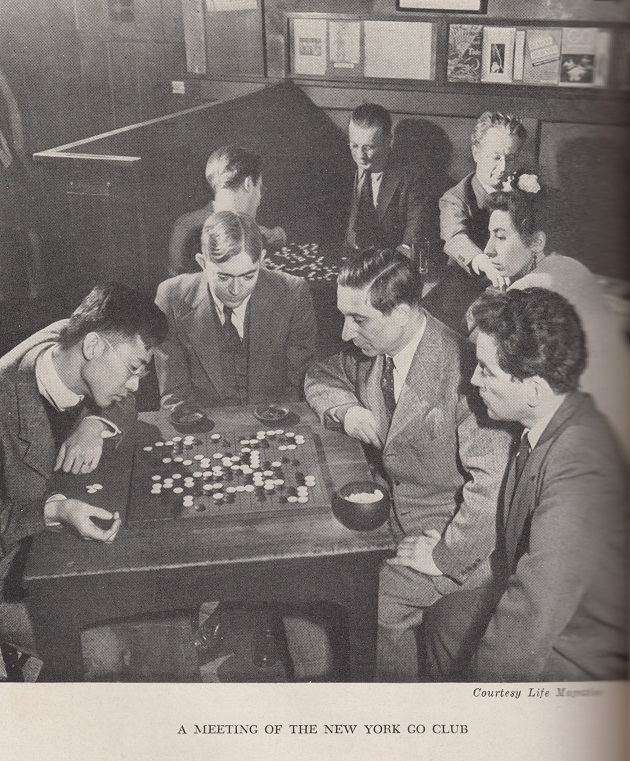
When the 1945 edition of Modern Chess Strategy was reviewed on pages 112-113 of Chess World, 1 June 1946, C.J.S. Purdy praised the chess coverage but criticized the Go material:
‘We cannot understand how so logical a man could have added a 66-page appendix on the game of Go. The McKay Company will be wise to omit Go from the second edition, enabling them to lower the price.
We cannot discuss Go here, except insofar as Lasker compares it with chess. Following false “authorities”, he makes a colossal error in saying it is older than chess, “possibly three times as old”.
After mentioning Chinese legends setting the invention of wei-chi (go is only the modern Japanese name) as far back as 2000-odd BC, he goes on to say, more confidently:
“It is certain that in the tenth century BC, Wei-Chi was well known, for it is mentioned in a number of poems and allegories found in Chinese works dating from that period.”
The game mentioned is some other -chi, not wei. Chi means simply a board game. Lasker is about 20 centuries out.
H.J.R. Murray, the world authority on the histories of indoor games, wrote in a letter to us dated 15 January, “We now know that wei-chi, which the Chinese encyclopaedias date back to 2300 BC, was really only invented about 1000 AD.”
Later, Murray wrote to us:
“I haven’t Edward Lasker’s book, but from what you say I think he has used Korschelt’s articles on Go in the Mittheilungen der deutschen Gesellschaft für Natur- und Völkerkunde Ostasiens 1881, for I find the same story there. My impression is that references to the game’s antiquity are all taken from a fairly modern Japanese encyclopaedia and are no more reliable than what was said about the age of chess in similar European works. (There is some balderdash on this subject in the Encyclopaedia Britannica – Ed. Chess World.)
Chinese and Japanese claims for the antiquity of their games are all exaggerated, often by confusing similar names of dynasties or emperors and taking the earlier ones as the ones meant. Thus, when Lasker says that the first books devoted entirely to Wei-Chi were written during the T’ang dynasty (618-906 AD), he or his authorities have confused it with the Tang Dynasty (1000 AD) ...”
Lasker also calls go “unquestionably the greatest of all strategic games, including chess”. What are the criteria of greatness? Go is certainly the greatest in size, for it is played on a board of 361 points, each player having 181 counters. The object is to surround pockets of your opponent’s counters, so that the game develops into a number of separate engagements. As Lasker well says, go is more like modern war than chess is; it is ponderous, soulless.
Go will never appeal to as many diverse types of mentality as chess. Nor could it possibly inspire a literature of thousands of books, as chess has.’
(9417)
During the Interregnum, C.J.S. Purdy wrote an article entitled ‘The World Championship’ on page 100 of Chess World, 1 June 1946. After briefly referring to the London Rules and stating that with Alekhine’s death ‘the way is now clear for the FIDE to take complete control of the championship’, Purdy presented these proposals:
‘Match or Tournament?
Some advocate that the world title should be decided by tournaments.
After much thought, we disagree.
In the first place, a tournament proves nothing unless the winner’s margin is substantial; luck often plays a big part.
Further, the lifting of one tournament to overwhelming importance would reduce interest in other tournaments; before the War, big international tournaments were held frequently, and they aroused tremendous interest. Each big tournament was important in itself; it did not have to play second fiddle to anything. The proposed change would seriously jeopardize all that.
Nobody had any complaints against the match system except that matches were too infrequent and the champion more or less selected his challenger.
If matches are held at regular intervals of say 18 months or two years, and the challenger is selected by the FIDE on recent tournament results, there may still occasionally be faulty choices made, but there will undoubtedly be a vast improvement.
So the choice is between a revolutionary change which may be harmful, and an alteration which is certain to be beneficial.
Suitable conditions for a match would be: First to win four games, but by a margin of at least two points; provided that at least 12 games must be played, and not more than 24 games. After 24 games, the leader shall be champion. If scores equal, holder retains title.
In other words, do not let a one-point margin decide unless after a very protracted struggle neither player can do better. A 4-3 win after ten or 12 games would not be very satisfactory. On the other hand, if one player could build up a lead of four wins to two after 12 games it should be good enough. The strain of a 24-games match or longer should not be imposed unnecessarily. Labourdonnais and McDonnell killed themselves with long matches.
As to finance, we suggest a purse of 5,000 American dollars. Half the purse and expenses to be raised by the nation holding the match; the other half from a fund raised by the FIDE from subscriptions in all affiliated countries.
By all means hold a tournament to pick the first champion; after that, matches.’
(9429)
From page 282 of Chess World, 1 December 1948:
‘Not to care for Sam Loyd’s chess problems is, in a chessplayer, simply ignorance – to know them is to like them. Even the most besotted anti-problemist must count Loyd an exception. Sam Loyd’s ingenuity was really incredible. In the puzzle world he was what Shakespeare is in literature.’
(9491)
From page 215 of The Treasury of Chess Lore by Fred Reinfeld (New York, 1951):
‘For years I have been proclaiming that the Australian Purdy is the world’s outstanding writer on chess. His work is alive with ideas, crackling with wit and good humor, and notable for its originality and clarity.’
(9502)
Fred Reinfeld’s description of C.J.S. Purdy as ‘the world’s outstanding writer on chess’ (C.N. 9502) was mentioned by Purdy in his obituary of the American on pages 121-122 of the August 1964 Chess World. Entitled ‘A Whirling Pen is Stilled’, the tribute began with an interesting view of Reinfeld’s standing:
‘Too many books may spoil an author’s reputation. Critics are too inclined to average out rather than judge on the best. It doesn’t happen to the really great; for instance, Shakespeare is judged virtually on his best dozen or so plays, and even Wordsworth, though everyone knows he wrote much puerile drivel, is considered a great poet because of a few masterpieces. But if a writer is less than great, probably his best things do not become famous enough to induce people to ignore his mere pot-boilers. This is why Reinfeld is under-rated.
He never, like Wordsworth, wrote drivel, but he wrote many books that say much the same things in different ways. These books are for learners and average players. They are lucidly written and easy to follow, but not noticeably bespattered with brass tacks. Not meaty, but sugar-coated. Sugar-coating is quite a virtue in teaching, but there should be good medicine underneath.
However, leaving such books aside, Reinfeld made many notable contributions to chess literature.’
A number of Reinfeld books were then singled out for praise, including his two ‘1001’ volumes: ‘These are only books of diagrams (chess exercises) but two of the most useful books to any chessplayer.’
After personal reminiscences, Purdy concluded:
‘“A Whirling Pen is Stilled” is intended metaphorically. If Reinfeld had used a pen, his output would have been impossible. No, he used a typewriter. He used it too much! And yet of that too much, much deserves to live.’
(9586)
On pages 36-37 of the 7/2015 New in Chess Nigel Short’s article about chess magazines includes this observation regarding the BCM:
‘Sadly, this once esteemed gazette has barely crawled into the 21st century, on life-support and with reputation threadbare, but, for much of its long existence, with its donnish prose, historical articles and news from distant dominions, it was a very fine read.’
Short also refers to the Australasian Chess Review and Chess World, edited by Cecil Purdy:
‘The first World Correspondence Champion had such an admirable way of explaining games and expressing ideas with great clarity that it is no wonder that Bobby Fischer held him in high regard.’
Fischer’s opinion of Purdy as a teacher and annotator has often been mentioned, and we should like to cite any direct statements made by the American. In the meantime, an extract from the back cover of Purdy’s Guide to Good Chess (Davenport, 2006):

(9561)
In C.N. 239 W.D. Rubinstein (Victoria, Australia) informed us:
‘Purdy told me that Bobby Fischer held his annotations in high esteem, and Fischer made a point of greeting him warmly at Siegen [the 1970 Olympiad] when they met for the first time.’
The start of the Preface to How Fischer Won by C.J.S. Purdy (Sydney, 1972), page vii:
‘At least a thousand million people have heard of the new World Chess Champion, Bobby Fischer. Most of them, including almost all the non-players and moderate players, are inclined to dislike what they hear. The enthusiasts excuse what they don’t like because chess looms large in their lives, and Fischer plays chess that is out of this world.
In this book I have tried to show that there is really little to dislike, and therefore little to excuse.’
The back cover:
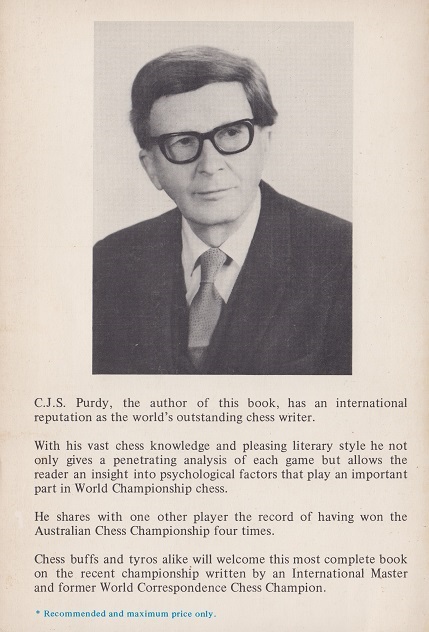
An earlier book, Guide to Good Chess (Sydney, 1954), had the following on its back cover:
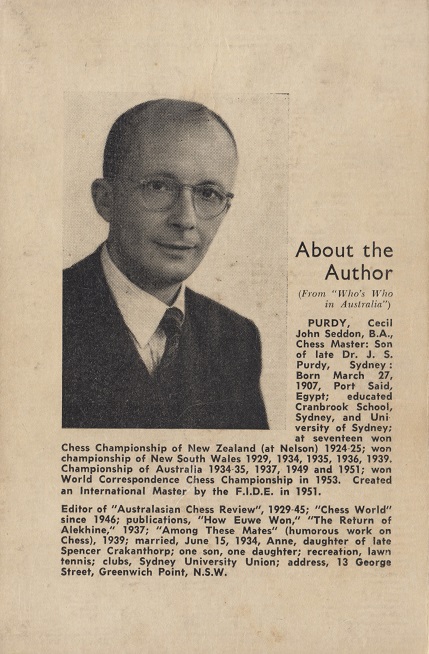
Purdy’s year of birth was discussed in C.N. 4924 (see above).
(9571)
From a syndicated column (19 November 2000) by Larry Evans:
‘“His best books are those with hardly any words at all, but only diagrams, captions and solutions”, quipped a wag about Fred Reinfeld, the world’s most-prolific chess author.’
Evans did not bother to give a source or to name the ‘wag’.
The remark was by C.J.S. Purdy, on page 120 of the July-August 1967 Chess World. The passage can also be found on page 67 of The Search for Chess Perfection II by C.J.S. Purdy (Davenport, 2006) and on page 149 of The Chess Gospel According to John edited by R.J. Tykodi and Bob Long (Davenport, 2010).
In isolation and out of context, the words extracted by Evans give a false impression of Purdy’s view of Reinfeld as a chess writer. See, for instance, C.N. 9586 above.
(9614)
From page 132 of Chess World, September-October 1967:
‘The teaching gift is not the same thing as genius but fairly rare. The genius has a brain too far removed from most students. The great teacher understands better the real needs of students partly because his own mind is nearer to theirs. Many great players would be quite hopeless as teachers because they themselves play well but do not really know why they play well. The teacher is able to rationalize everything. Not that laying down rules is enough. He must discover or pick out the best rules to lay down.’
(9621)
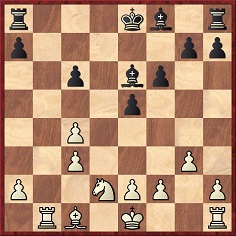
Position after 14 Nf3-d2 and before 14...O-O-O
C.N. 795 mentioned the castling incident which occurred in Averbakh v Purdy, Adelaide, 1960, as reported on page 110 of Wonders and Curiosities of Chess by Irving Chernev (New York, 1974). In The Facts about Larry Evans we commented:
In July 2000 [Chess Life] Evans presented a diagram from the famous game between Averbakh (Evans writes ‘Averbach’) and Purdy, played in 1960 in Australia (‘Austalia’), which had been published in his book Chess Catechism. In that volume (page 39) Evans had given an inaccurate diagram, omitting a white pawn on g3, so has his level of accuracy changed in the three decades since the book appeared? Yes, indeed. In his July 2000 column the white pawn on g3 is still missing, but now there is a second absconder, from the black side: a pawn at a7.
Subsequently (Chess Life, August 2002, page 47), Evans achieved a correct diagram.
The game was misdated 1961, instead of 1960, by T. Krabbé on page 281 of the May 1976 Chess Life & Review and on page 6 of Chess Curiosities (London, 1985), as well as by R. Timmer on page 49 of Startling Castling! (London, 1997) and by E. Schiller on page 396 of Encyclopedia of Chess Wisdom (New York, 1999). On pages 100-101 of The Book of Chess Lists (Jefferson, 1984) A. Soltis managed the right year but asserted that ‘R-QN7’ had been played by Averbakh.
Chernev’s above-mentioned account quoted Purdy’s words (albeit without specifying their provenance) and is the most detailed and accurate version found in a secondary source. Later writers took the matter backwards, not forwards.
Purdy had annotated his loss to Averbakh on pages 221-222 of Chess World, November 1960, and after 14...O-O-O he wrote: ‘Amusing incident here: see October, page 198’. In that earlier issue Purdy reported:
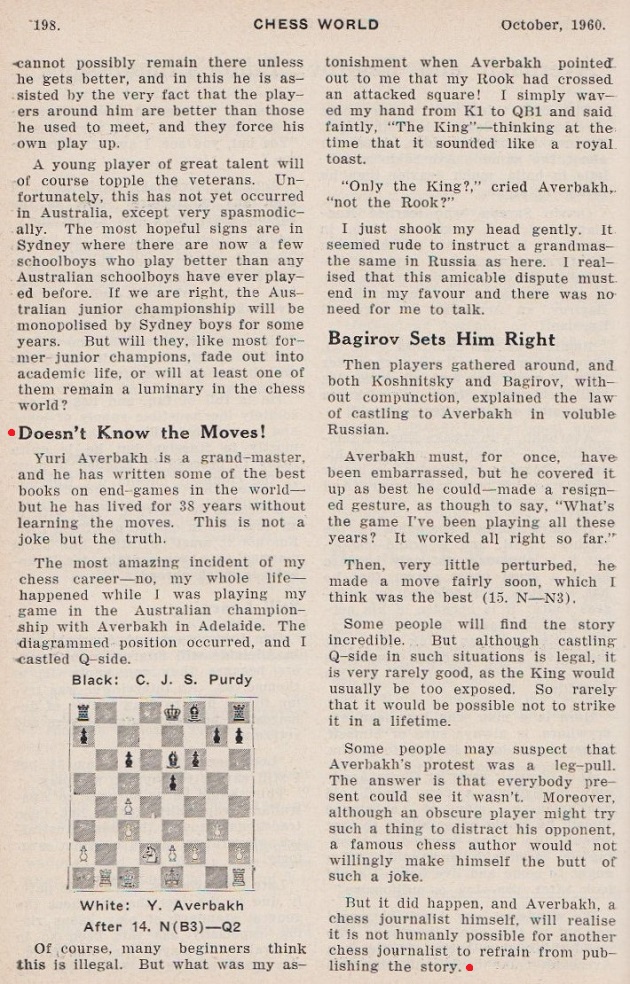
The episode was referred to again by Purdy on page 124 of the July-August 1967 Chess World (which included an impossible date, Sunday, 17 January, in connection with Averbakh’s further stay in Australia):
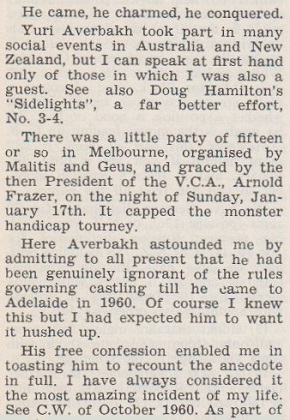
As regards Averbakh’s side of the story, however, the final paragraph of a review (by ‘B.C.’ – Bernard Cafferty) of his book V poiskakh istiny (Moscow, 1967) on page 2 of CHESS, October 1967 deserves attention:
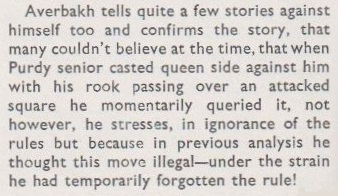
Towards the end of the Adelaide tournament Averbakh spoke highly of Purdy in an interview with W.J. Geus (Chess World, October 1960, page 211):
‘One of the oldest competitors, but put all his strength into his games. His qualities as a fighter are wonderful. Had no luck in this tournament. His technical positional knowledge is first class, and one could say: “Understands chess.”’
(9622)
Michael Clapham (Ipswich, England) notes that a similar castling story was reported on page 156 of CHESS, 14 January 1937:
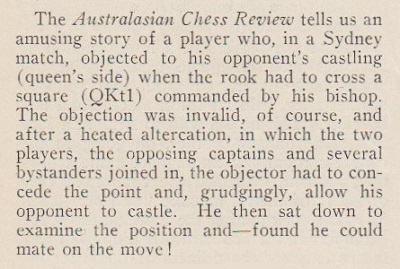
It will be appreciated if a reader can forward the original account in the Australasian Chess Review (edited by Purdy), since we lack the issue in question.
(9644)
It is now possible, courtesy of the Cleveland Public Library, to show the earlier account of the castling story, published on page 238 of the 10 September 1936 issue of the Australasian Chess Review:
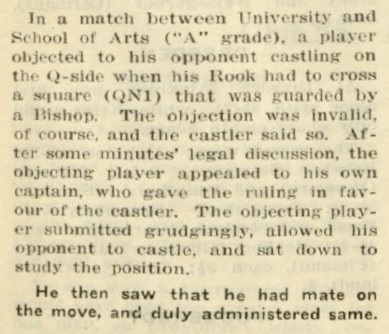
(9666)
Michael Clapham quotes the final paragraph of an article, ‘Fischer Dialogue’, by Ed Edmondson in the June 1970 Chess Life & Review, pages 317-319:
‘What next for Fischer? At this writing he is reported still in Yugoslavia, considering whether or not to play in Skopje. Meantime, the entire chess world cannot help but be intrigued once again by the question C.J.S. Purdy posed in his Chess World shortly after Fischer’s withdrawal from the 1967 Interzonal: “Why all this ponderous succession of tournaments to select an official challenger? When the whole world can see that we have one sheer chess genius among us, why can’t we cut the red tape and let him play a match against the titleholder?”’
We consider this an excellent illustration of how all quoted material needs to be double-checked. Did Purdy really suggest in 1967 that the world championship qualification system should be set aside because of Fischer’s supposed supremacy over all possible challengers (with the consequence that Spassky would not have played his second title-match against Petrosian)?
Firstly, a news item on page 108 of Chess World, July-August 1967 gave the background to Fischer’s withdrawal from that year’s Interzonal in Sousse:
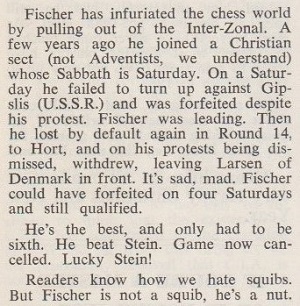
An article by Purdy entitled ‘The Fischer Problem’ on pages 137-139 of the September-October 1967 issue of Chess World contained the comments quoted in Chess Life & Review, but it will be observed that Edmondson did not respect their context:
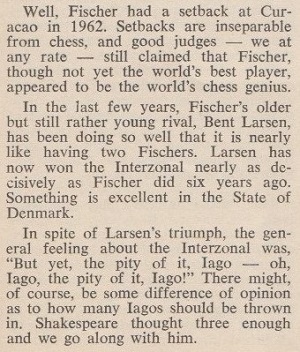
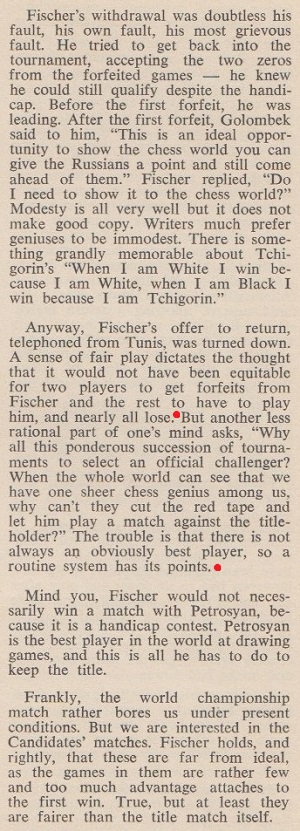
(9605)
‘Fischer, a New Tchigorin’ was the title of an article by C.J.S. Purdy on pages 134-136 of Chess World, September-October 1967. He annotated Fischer v Stein, Sousse, 1967 (the final game in Fischer’s My 60 Memorable Games) with this introduction:
‘Here is the game, which in the tournament doesn’t officially exist and yet was its masterpiece, symbolising the triumph of genius over schooled mastery.’
Purdy’s concluding observation:
‘By ordinary human standards, playing chess like White in this game would seem to require nerves of steel. Fischer’s powers of calculation and confidence in his judgment make it possible for him to conduct vital contests in a style which nobody else would venture over the board except in games played for fun. Tal certainly has played with at least equal daring, but it seems to me that he deliberately speculates. Fischer gives the impression of having everything sewn up.’
Irving Chernev tinkered with Purdy’s words on page 197 of The Golden Dozen (Oxford, 1976). The full annotations were reproduced on pages 90-92 of C.J.S. Purdy’s Fine Art of Chess Annotation and Other Thoughts by Ralph J. Tykodi (Davenport, 1992).
Purdy’s note after 25 Qg3 began:
‘The Purdy rule, “Always unpin”, is dead right here.’
(9702)
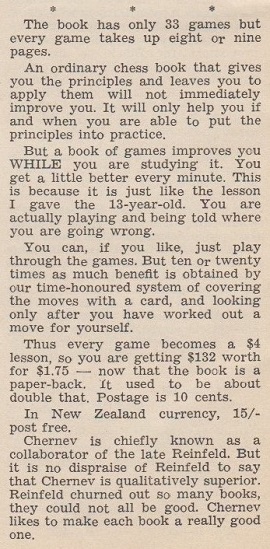
The above passage about Logical Chess Move by Move by Irving Chernev comes from page 80 of the March-April 1967 Chess World. It was omitted from page 65 of The Search for Chess Perfection II by C.J.S. Purdy (Davenport, 2006) and from page 147 of The Chess Gospel According to John edited by R.J. Tykodi and Bob Long (Davenport, 2010). In both books its place would have been just before the paragraph beginning ‘In this series ...’.
(9713)
Blindfold games by C.J.S. Purdy are scarce, but one can be given here, from pages 257-258 of the 10 September 1936 issue of the Australasian Chess Review. It was played during his tour of New Zealand, in a six-board blindfold exhibition. As we do not have a complete run of the magazine in the mid-1930s, any further details which may have been published in another issue will be appreciated.
Cecil John Seddon Purdy (blindfold) – W.H. Joyce
Christchurch (date?)
‘Caro-Kann (in effect)’
1 d4 e6 2 c4 Nf6 3 Nc3 c6 4 e4 d5 5 e5 Nfd7 6 cxd5 cxd5 7 Nf3 a6 8 a4 Bb4 9 Bd3 Qc7 10 O-O Bxc3 11 bxc3 Qxc3 12 Ba3 Qa5 13 Qb3 Nc6 14 Rfc1 Qd8 15 Bd6 Qb6 16 Qa3 g6 17 Rab1 Qa7 18 a5 f5
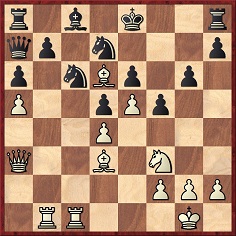
19 Bc2 Nxd4 20 Nxd4 Qxd4 21 Ba4 h6 22 Rc7 Qh4 23 Rbxb7 Qd8 24 Bxd7+ Bxd7 25 Rxd7 Qxd7 26 Rxd7 Kxd7 27 Be7 Rhb8 28 h4 Rb7 29 Qd6+ Kc8 30 Qd8 mate.
(9724)
Eduardo Bauzá Mercére (New York, NY, USA) reports that the blindfold game in Christchurch between Purdy and Joyce given in C.N. 9724 was played on 13 January 1936 and that a report was published on page 13 of the Christchurch Press the following day. Extensive information about Purdy’s 1935-36 tour of New Zealand is available via the website of the National Library of New Zealand, and our correspondent has sent this summary:
‘Auckland:
11 December (afternoon): blindfold simultaneous exhibition +2 –1 =3 (New Zealand Herald, 12 December 1935, page 14);
11 December (evening): simultaneous exhibition +17 –4 =10 (New Zealand Herald, 12 December 1935, page 14);
Hamilton:
12 December: simultaneous exhibition +22 –2 =4 (New Zealand Herald, 14 December 1935, page 17);
13 December: blindfold simultaneous exhibition +6 –0 =0 (New Zealand Herald, 16 December 1935, page 12);
13 December: consultation game against Hamilton team; Purdy won in 20 moves (New Zealand Herald, 16 December 1935, page 12);
Auckland:
18 December: simultaneous exhibition +16 –1 =1 (New Zealand Herald, 19 December 1935, page 12);
Tauranga:
23 December: blindfold simultaneous exhibition +4 –0 =3 (New Zealand Herald, 24 December 1935, page 12);
Wellington:
26 December to 6 January: New Zealand championship. Purdy was entitled to win any of the prizes, but not the New Zealand title, as he was born in Egypt and had not been a resident of the Dominion during the previous six months (Wellington Evening Post, 24 December 1935, page 16). Leading final scores: 1 Purdy, 12/13 (lost to Gyles); 2 A.W. Gyles 11 (won the championship), 3-4 Ian Burry and D.I. Jones, 8½; 5 J.A. Erskine 8.
7 January (afternoon): blindfold simultaneous exhibition +2 –0 =4 (draw with Joyce); (Wellington Evening Post, 8 January 1936, page 11);
7 January (evening): simultaneous exhibition +13 –2 =4;
8 January (afternoon): first match-game with Gyles (adjourned);
8 January (evening): simultaneous exhibition +20 –1 =5;
9 January (afternoon): won the adjourned game and the second game with Gyles; (evening) simultaneous exhibition +9 –1 =2;
Christchurch:
11 January (afternoon): Purdy-W.D. Khoury 1-0 (first match-game) (Christchurch Press, 13 January 1936, page 10);
11 January: simultaneous exhibition +17 –2 =5 (Christchurch Press, 13 January 1936, page 10);
13 January: blindfold simultaneous exhibition +4 –1 =1 (Christchurch Press, 14 January 1936, page 13);
14 January: W.D. Khoury-Purdy (second match-game?);
15 January (afternoon): Purdy-W.D. Khoury 1-0 (third match-game); (Christchurch Press, 15 January 1936, page 15);
15 January (evening): simultaneous exhibition +14 –3 =6 (Christchurch Press, 15 January 1936, page 15).’
Mr Bauzá Mercére adds that although no game-scores have been found, two photographs from the tour can be shown:
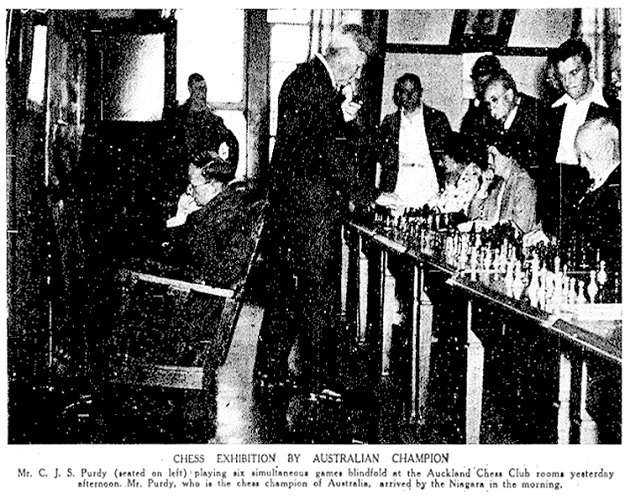
New Zealand Herald, 12 December 1935, page 10
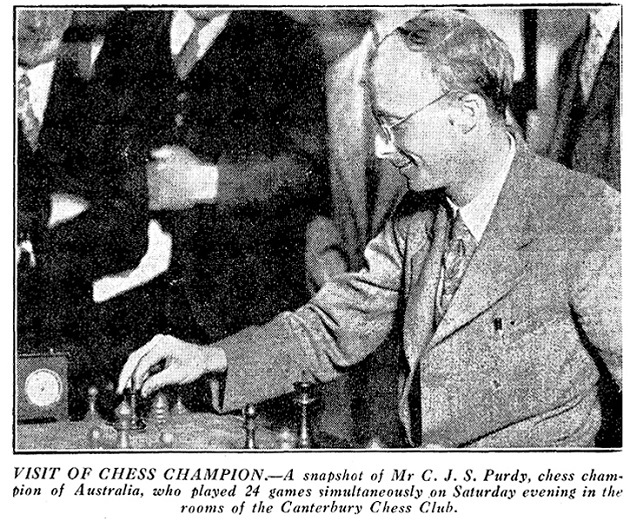
Christchurch Press, 13 January 1936, page 16.
(9735)
From page 151 of the June 1957 Chess World:
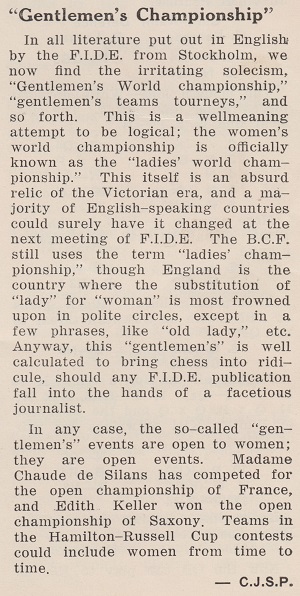
(9729)
‘But being female does have its limitations. Since, in Australia anyway, women do not seem to have the same natural ability as men, they can never be serious threats in a mixed tournament, no matter how hard they may study and prepare.
However, as long as a woman does realize the limited heights that her chess can ever reach, then she can certainly find chess a most interesting pastime in an atmosphere where there is definitely no unfair bias against women.’
Those were the concluding paragraphs of an article ‘“Only Old Fogeys Play Chess”’ by Daphne Hewson on pages 103-104 of Chess World, May-June 1967. Purdy added an editorial note:
‘Miss Hewson’s second-last paragraph has no demonstrable scientific basis. The only boys who get good at chess are those who study it. Teach chess to more girls of around nine or ten, well before they get too interested in boys and inundated with homework at secondary school, and you’ll get results.’
(9754)
From page 208 of Chess World, September 1957:
‘Many players imagine that “freak” openings are bad. But if you are White, they do no worse than put you in the position of Black, and are usually better than that, as moves like P-QB3, etc. are apt to become useful later on. Black should try to prevent that happening, but this is often difficult. Eccentric first moves for Black are less to be recommended.’
(9736)
‘The historical treatment is the best; nobody can understand modern methods in chess without first understanding just what older ideas they replaced and why they replaced them.’
Source: an article (‘A Page of Hints’) by C.J.S. Purdy, Chess World, March 1957, page 80. He was discussing Chess from Morphy to Botwinnik by Imre König (London, 1951), ‘an important treatise on position play’.
(9764)
‘Superior skill at chess does not indicate superior intelligence; it only indicates superior skill at chess.’
Source: an article entitled ‘A Page of Hints’ by C.J.S. Purdy, Chess World, November 1957, pages 242-243.
(9774)
From page 30 of the January 1957 Chess World:
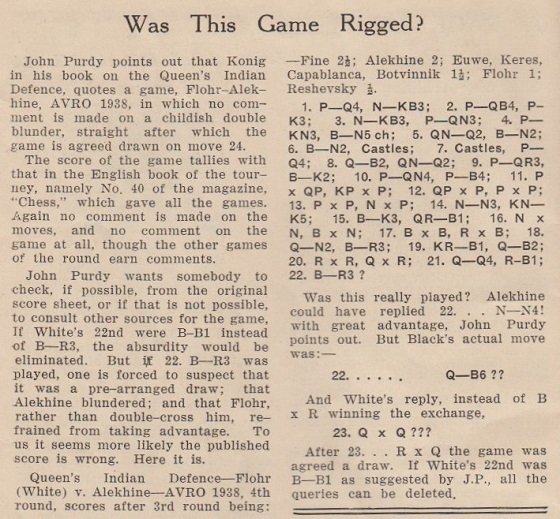
The question in the headline was answered on page 60 of the March 1957 issue:
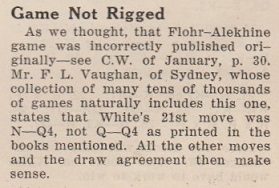
The full score of Flohr v Alekhine, AVRO, 12 November 1938: 1 d4 Nf6 2 c4 e6 3 Nf3 b6 4 g3 Bb4+ 5 Nbd2 Bb7 6 Bg2 O-O 7 O-O d5 8 Qc2 Nbd7 9 a3 Be7 10 b4 c5 11 cxd5 exd5 12 dxc5 bxc5 13 bxc5 Nxc5 14 Nb3 Nfe4 15 Be3 Rc8 16 Nxc5 Bxc5 17 Bxc5 Rxc5 18 Qb2 Ba6 19 Rfc1 Qc7 20 Rxc5 Qxc5
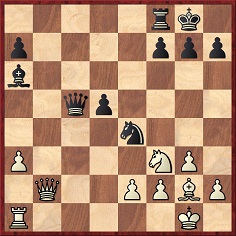
21 Nd4 Rc8 22 Bh3 Qc3 23 Qxc3 Rxc3 Drawn.
Apart from the two mentioned by Purdy, the sources that we have consulted state that White’s 21st move was Nd4, and not Qd4, with one notable exception: page 632 of the Skinner/Verhoeven volume on Alekhine.
The publications cited by Purdy are shown below, beginning with page 131 of the 14 December 1938 issue of CHESS (the sole source indicated by the Skinner/Verhoeven book):
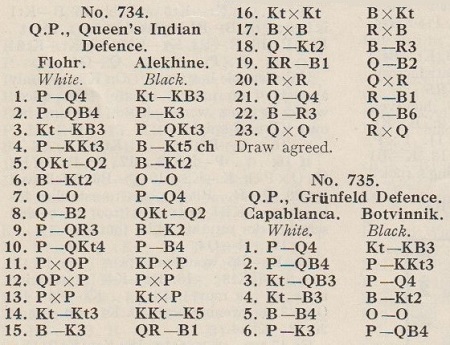
In the relevant part (pages 46-47) of König’s book The Queen’s Indian Defence (London, 1947) our copy has a handwritten correction at move 21:

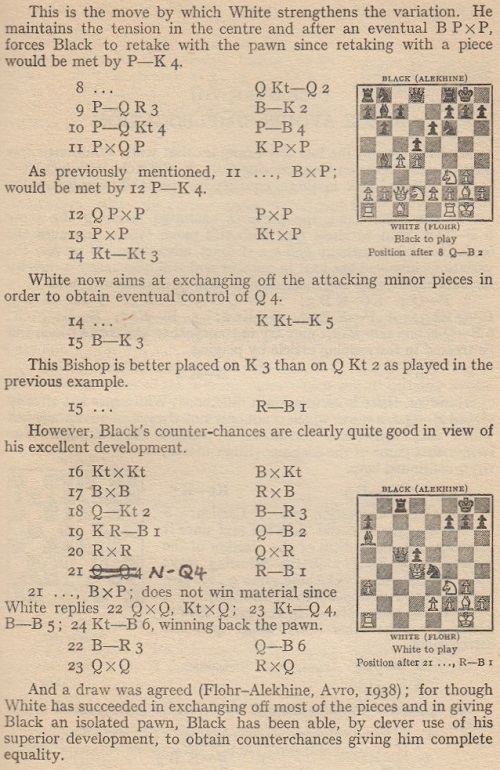
(9797)
On page 29 of Chess World, February 1960 C.J.S. Purdy wrote:
‘If – we almost wrote “when” – Botvinnik loses the current match, he will have the right to a return match in 1961 ...
Tal seems generally favoured to beat Botvinnik. We think stamina will decide in Tal’s favour ...’
And from page 73 of the May 1960 issue:
‘This was the only world title match about which we have ever ventured a prophecy.’
On page 57 of the April 1960 Chess World Purdy criticized Harry Golombek, under the heading ‘Extraordinary Prediction’:
‘At that stage [after the short draw in the 13th match-game], with Tal two games ahead, Golombek published an extraordinary prediction that Botvinnik would hold his title. Golombek faces the alternative prospect of becoming known as either the greatest prophet or the greatest neck-out-sticker in chess history.
... One of the reasons that Golombek gives is that Botvinnik has a better knowledge than Tal of the openings that are being played! Here is logic to make poor old John Hanks writhe in agony. It would be just as sound to say one tennis player should beat another because his service is superior.
... Golombek’s writings all tend to show that he regards chess rather too much as a body of knowledge. If knowledge of the openings went far, Golombek himself would be one of the world’s best players.
Chess is primarily a skill. It’s mainly a matter of who sees the mostest the fastest. Tal sees the mostest the fastest of all. He would have done better still had he played more soberly after amassing a three-point lead.
Seeing the mostest the fastest is not the whole story. Petrosian may be Tal’s equal there. That is technique. After that comes the art of choosing between moves that technique ranks equal, or as possibly equal. Petrosian, like Capablanca, will always choose the calculable. Tal will often choose the incalculable. Such a player develops an intuition for chances. Tal’s intuition is not perfect, as we see from the ninth game, below, but many of his other games show that it is almost magical, all the same.
Golombek’s prediction may possibly come true, but the reasoning he bases it on is faulty. He seems to be a Botvinnik fanatic.’
It is unclear to us which particular text or texts by Golombek prompted Purdy’s remarks. Our reading of the game-by-game reports by Golombek from Moscow in the BCM and the Times is that he was even-handed and not remotely a ‘Botvinnik fanatic’.
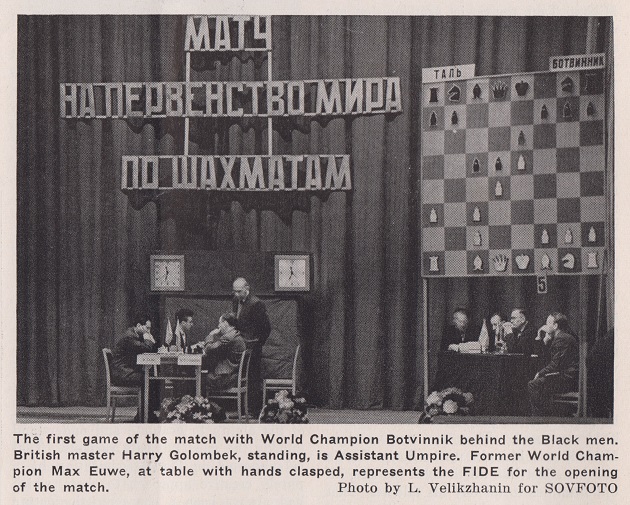
Chess Review, May 1960, page 136
(9835)
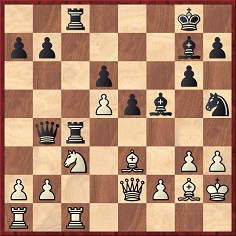
Black to move
In this position from the sixth match-game between Botvinnik and Tal (Moscow, 26 March 1960) Purdy wrote regarding 21...Nf4:
‘Perhaps the most daring sacrifice ever made in a world championship match, for the consequences were certainly not fully calculable. It is easy to see that Black gets two pawns for his piece, but White retains his two bishops and there is no crash on White’s king.’
Source: Chess World, March 1960, page 47.
(9836)
An observation by Purdy on page 43 of the March 1960 Chess World:
‘I have never believed that Lasker played designedly bad moves in the opening. I think he played designedly rapid moves – to conserve time – and it naturally turned out fairly often that they were not the best. And he would vary from “the book” if he thought a move had a good chance of turning out just about as good as the “book” move.’
(9837)
The present sequence of Purdy items ends with a paragraph by him about Réti’s Masters of the Chess Board, on page 20 of Chess World, January 1960:
‘How many chess books do players as a rule go through from cover to cover? Not many. This is one. Réti’s idea was that the chessplayer should go through the same evolution as chess theory itself – first learn the Anderssen and Morphy way, then learn what Steinitz added, then Tarrasch and so on up to modern times. He was right. He also knew that most players want moves really explained – not strings of analysis. For all except very advanced players, Masters of the Chess Board is a really wonderful book.’
(9838)
C.N. 3779 (see too Reviewing Chess Books) quoted a remark by Fred Reinfeld on page 96 of Chess Review, March 1951:
‘If a reviewer spends all of an hour nowadays reading the book he is supposed to be reviewing, he feels that he has done more than his duty. This is particularly unfortunate in the field of chess, in which it often requires years to write a good book.’
That was the first paragraph of his highly favourable review of Chess Secrets I Learned from the Masters by Edward Lasker (New York, 1951). The second paragraph:
‘Chess Secrets must have taken many years to write, and the events which it chronicles took some 40-odd years to live through. I consider myself fortunate to have had the opportunity of reading this book three times: in manuscript, in galley proofs and in page proofs. Each reading was an enjoyable experience.’
Reinfeld’s three readings did not save the book from its many historical errors, some of which have been mentioned in C.N., but the qualities of Chess Secrets are not in dispute.
On page 40 of Chess World, February 1952, C.J.S. Purdy wrote:
‘This excellent book is by the international master Edward Lasker, but the best of the many good things in it are by Emanuel Lasker. We mean things Emanuel, in his lifetime, said to Edward and from which Edward profited in his own games, and put in this book. The two were unrelated but great friends.
Edward Lasker is one of the few chess writers who have the faculty of writing well and entertainingly; he lapses but rarely into journalism.
... Some people like their expositions of chess to be systematic. That is important in mathematics or science but much less so in chess, which is more art than science. This book, with its sugar-coating of gossip, will teach most students more than many orthodox text-books. Drudgery should be avoided.
... The reviewer can claim to have derived more entertainment from Chess Secrets than any other chess book, and in our view there is not much to beat it for instruction, either.’
On page 133 of the September-October 1967 Chess World Purdy referred back to his review and added:
‘People picking it up casually would mistake it for a book of gossip about the masters, which it partly is. They overlook that it contains 75 superbly annotated games by one of the best chess writers and annotators of all time. Each one is a work of art.’
(9950)
In a report on the Melbourne Olympic Tourney, 1956-57 C.J.S. Purdy wrote about Florencio Campomanes on pages 9-10 of Chess World, January 1957:
‘We believe it was largely through his efforts that the Philippines has been the scene of an extraordinary mushroom growth in chess absolutely without parallel in the world’s history. He is a lecturer at the National University but temporarily resigned to go to Moscow and afterwards Melbourne. He lived seven years in the USA.
Through most of the tourney he seemed more sinister than genial, but he was putting on an act; it seemed that he deliberately set out to irritate his opponents as a matter of tactics. At the prizegiving he disclosed his view that friendly chess is one thing and tournament chess another – more or less apologizing for his gamesmanship. The answer is that in most countries, including Australia, players tacitly agree not to use gamesmanship, and everybody plays ruthlessly but follows a strict code of behaviour.
We must add our opinion that Campomanes gained absolutely nothing by his irritation tactics – mostly of a mild and to us rather amusing kind – and that he upset nobody’s nerves more than he did his own.
The moment the tourney was ended, he ceased walking around like a wounded rhinoceros, and became a very genial fellow. He is a rather overpowering character, but his driving force has been used to great effect in the service of chess – we hope to meet him again when we have time to talk. On this occasion we were representing rival newspapers in Manila and had no time for idle chat between games. He may be surprised at our candour, but we remind him of a snatched conversation as we passed each other one day.
Campo: You seem to be taking your chess writing very seriously.
Purdy: It’s my profession.
Campo: Mine, too.
Purdy (realizing he had been misunderstood): Not chess, I mean writing.
Now, a professional writer must be candid. And we really think Campomanes would be insulted if we plastered him with insincere eulogy. Suffice it to say that he made an indelible impression. He was certainly the strongest of the three Filipinos at chess [the others were R. Cardoso and J. Pascual], and well deserved fourth prize, which, as he said at the prizegiving, he cherished far beyond the value of £A35 or its equivalent in pesos.
He is to be congratulated on doing so well in spite of the burden of press work. For he took his newspaper work quite seriously, even though in jest he might have seemed to disclaim it.’
Page 99 of the April 1957 Chess World gave the conclusion of Campomanes’ victory in round seven of the Melbourne tournament over C.J.S. Purdy’s son, John, after 29...Kg7-f6:
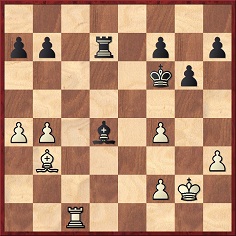
30 Kf3 Bc5 31 bxc5 Rd3+ 32 Ke4 Rxb3 33 c6 bxc6 34 Rxc6+ Kg7 35 Ra6 Rxh3 36 Rxa7 Ra3 37 a5 h5 38 f5 g5 39 Ra8 h4 40 f3 h3 41 f6+ Kh7 42 Rb8 Rxa5 43 Rb1 Kg6 44 Ke3 Ra2 45 Ke4 h2 46 Ke3 Rg2 47 Rh1 Kf5 48 White resigns.
That item in Chess World was headed ‘End-Game Suicide’, with criticism of White’s 30th and, especially, 32nd moves. We have yet to trace the full game-score.
(9986)
As a quiz question, C.N. 10008 asked which brilliancy played in 1956 was annotated by C.J.S. Purdy under the title ‘Game of the Century? Yes and No’.
Noting that the phrase ‘Game of the Century’ was used in the context of prodigies’ performances, C.N. 3880 showed part of Hans Kmoch’s article about Byrne v Fischer, New York, 1956, from page 374 of Chess Review, December 1956:
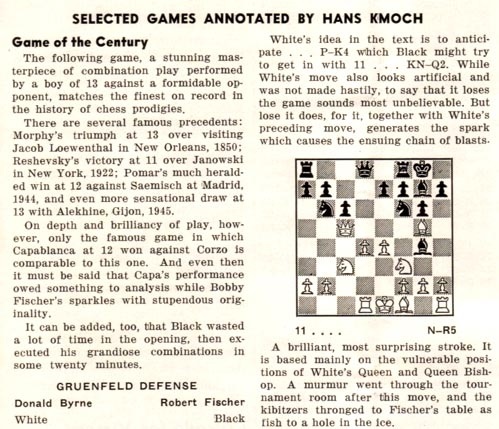
To answer the quiz question it is therefore tempting to jump to the conclusion that it was the Byrne v Fischer encounter that Purdy described as ‘Game of the Century? Yes and No’, but the importance of not jumping to conclusions is the theme of the present item.
The game discussed by Purdy was Smyslov v Pachman, Moscow Olympiad, 1956: 1 c4 Nf6 2 Nc3 e6 3 d4 d5 4 cxd5 exd5 5 Bg5 c6 6 e3 h6 7 Bh4 Bf5 8 Qf3 Qb6 9 Qxf5 Qxb2 10 Qc8+ Ke7 11 Nxd5+ cxd5 12 Qc1 Qb4+ 13 Ke2 Qb5+ 14 Kf3 Qd7 15 Bxf6+ Kxf6 16 g3 Qf5+ 17 Kg2 Bd6 18 Qd1 g6 19 Bd3 Qe6 20 Rb1 Nc6 21 Rxb7 Rab8 22 Rxb8 Rxb8 23 Ne2 Kg7 24 Qa4 Ne7 25 Rb1 Rxb1 26 Bxb1 Bb8 27 Bc2 h5 28 Qb5 Bc7 29 h4 a6 30 Qb7 Resigns. From page 139 of the June 1957 issue of Chess World:
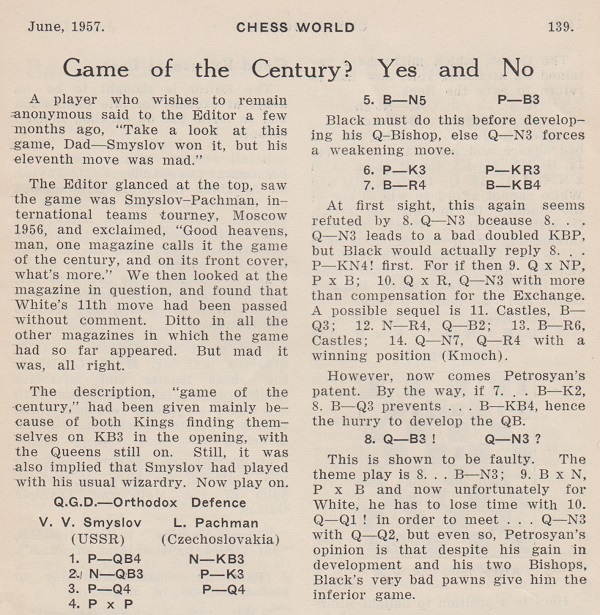
Purdy discussed the game in more detail, under the title ‘That “Mad” Move by Smyslov’, on page 221 of the October 1957 Chess World and on pages 240-241 of the November 1957 issue.
As shown above, the original (June 1957) article included this remark by Purdy about Smyslov v Pachman:
‘... one magazine calls it the game of the century, and on its front cover, what’s more.’
Another conclusion not to be jumped to is that Purdy never realized or corrected his mistake. A year later he reverted to the matter in Chess World:
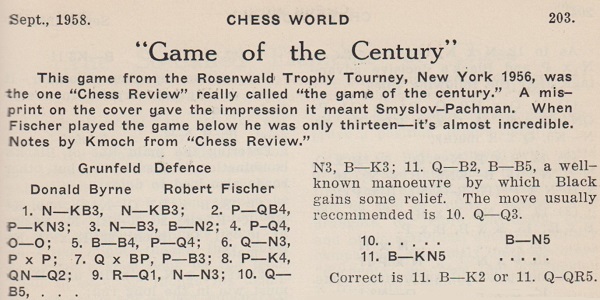
The relevant material in the December 1956 Chess Review:
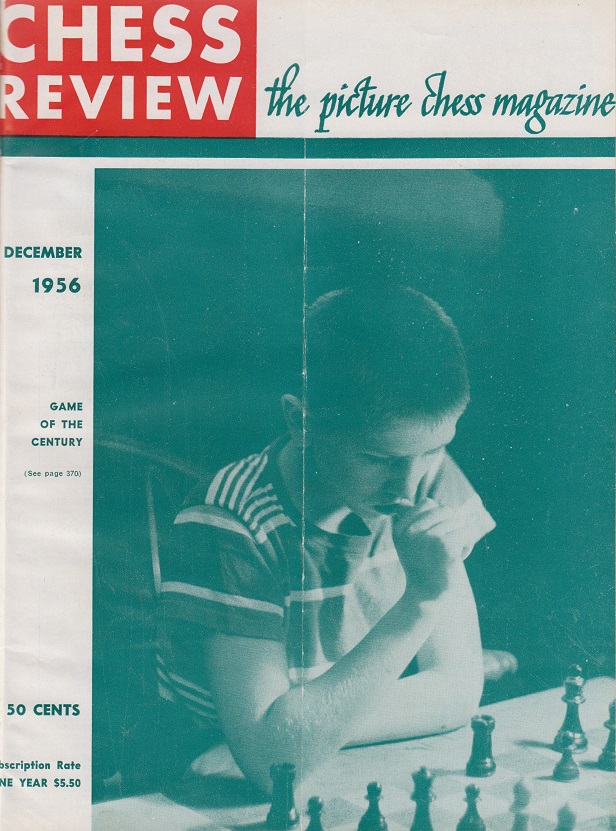
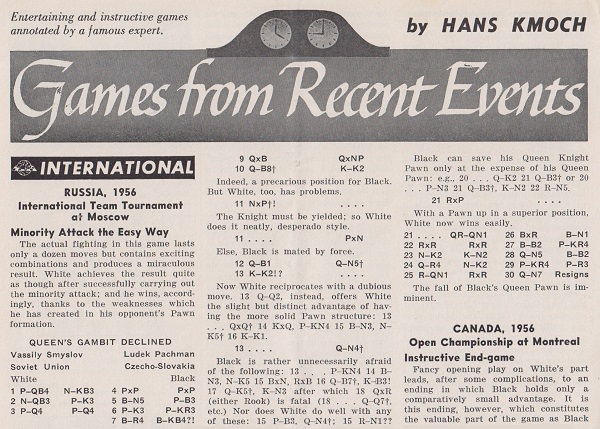
(10015)
There is a frequent lack of rigour in claims that Alekhine ‘dodged’ opponents, and it is unimpressive to find C.J.S. Purdy writing the following in a review of Lessons from My Games on pages 146-147 of Chess World, September-October 1967:
‘Reuben Fine became one of the world’s greatest players. At the time when his claims to play a match for the world title were unanswerable, he did not get to play a match because Alekhine, once he had regained his title from Euwe, did everything possible to evade a match.’
(10028)
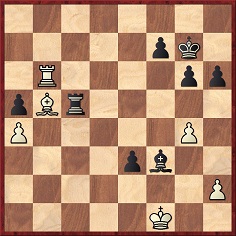
After 48...Re5-c5, White resigned
The winner’s annotations to this game (B.Y. Mills v C.J.S. Purdy in round three of the Australian Championship, Adelaide, 1946-47) are on pages 292-294 of C.J.S. Purdy: His Life, His Games and His Writings by J. Hammond and R. Jamieson (Melbourne, 1982), with the following remark after 48...Rc5:
‘White can save his position only by allowing mate.’
See too pages 250-251 of the algebraic edition, The Search for Chess Perfection (Davenport, 1997).
When Purdy’s notes originally appeared on pages 115-116 of Chess World, 1 May 1947 the comment was:
‘White can save his pieces only by allowing mate.’
The full score of what Purdy described as ‘his best game of the tourney’ (Chess World, 1 February 1947, page 28), played on 28 December 1946: 1 d4 Nf6 2 c4 e6 3 Nc3 Bb4 4 e3 O-O 5 Bd3 c5 6 Ne2 d5 7 a3 cxd4 8 exd4 dxc4 9 Bxc4 Be7 10 O-O Nbd7 11 Bg5 h6 12 Bh4 Nb6 13 Ba2 Bd7 14 Qd3 Bc6 15 Rad1 Nbd5 16 Bb1 Re8 17 Nxd5 Qxd5 18 Nf4 Qb5 19 Bxf6 Qxd3 20 Nxd3 Bxf6 21 Ne5 Ba4 22 Rd2 Red8 23 Re1 Rac8 24 f4 Bxe5 25 fxe5 Rc4 26 b3 Bxb3 27 Rb2 Rc3 28 Be4 b6 29 Rd2 Bd5 30 Rd3 Rxd3 31 Bxd3 Rc8 32 Re3 g6 33 Be2 Rc2 34 Kf1 Rd2 35 Rc3 Rxd4 36 Rc8+ Kg7 37 Rc7 a5 38 Bb5 Re4 39 Be8 Kf8 40 Bb5 Rxe5 41 a4 Rf5+ 42 Kg1 e5 43 Rc8+ Kg7 44 Rd8 e4 45 g4 Re5 46 Rd6 e3 47 Kf1 Bf3 48 Rxb6 Rc5 49 White resigns.
(10033)
In the second round (27 December 1946) of the Adelaide tournament discussed in the previous item, ‘Purdy, after wriggling out of a loss against Brose, won after being two pawns down with bishops on opposite colours’ (Chess World, 1 February 1947).
Although the 71-move game is in databases, we have yet to trace it in a newspaper or magazine of the time. It was the subject of a brief report under the headline ‘Aust. Chess Sensation’ on page 7 of the Sydney Sun, 28 December 1946:
‘Sensation developed in the second round of the Australian chess championship when Purdy (NSW) made an oversight against South Australian champion Brose, and appeared certain to lose. Brose finally lost the game, in which loss had seemed impossible.’
(10034)
‘Lasker’s Manual has claims to be the most important chess book ever written.’
Source: C.J.S. Purdy on page 240 of the November 1960 Chess World.
(10043)
From Lasker v Capablanca, Moscow, 3 June 1936:
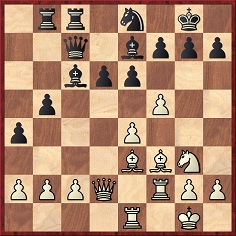
‘“What about the backward pawn?”, shrieks the pious student, brought up on sound positional principles. The answer is that there ain’t goin’ to be no backward pawn.’
That remark by C.J.S. Purdy was quoted on page 217 of The Immortal Games of Capablanca by Fred Reinfeld (New York, 1942) and on pages 259-260 of Capablanca’s Best Chess Endings by Irving Chernev (Oxford, 1978). Neither book mentioned the source: Purdy’s annotations on pages 283-284 of the Australasian Chess Review, 8 October 1936.
The game continued 20 Nh5 Qb7 21 Bg5 f6 22 Be3 Nc7 23 Qd1 Rd8 24 Rd2 Kh8 25 a3 Rbc8 26 Bf2 d5.
A game with the same theme was annotated by Purdy on pages 49-50 of Chess World, February 1957:
Emanuel Basta – Ortvin Sarapu
Melbourne Olympic Tourney, 1956-57 (round four)
Benoni Defence
1 d4 Nf6 2 c4 c5 3 d5 e6 4 Nc3 exd5 5 Nxd5 Nxd5 6 Qxd5 Be7 7 Nf3 Nc6 8 e4 O-O 9 Be3 d6 10 Qd2 Re8 11 Bd3 Bf6 12 O-O Qb6 13 Rab1 Bg4 14 Ne1 Ne5 15 f3 Be6 16 b3 Rad8 17 Bf2 h6 18 Rd1 Qa6 19 Be2 Nc6 20 Bd3 Nb4 21 a4 Qb6 22 Rb1 Bg5 23 f4 Bf6 24 Nf3
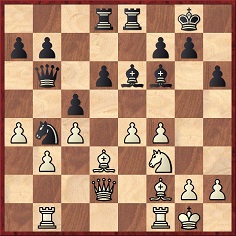
24...d5 25 exd5 Bxd5 26 cxd5 Rxd5 27 Rfe1 Red8 28 Nd4 Nxd3 29 Qxd3 Bxd4 30 Bxd4 Rxd4 31 Qc2 Rxf4 ‘and wins’.
In his introduction Purdy referred to ‘the extraordinary piece of play’, adding that the game ...
‘... illustrates the modern tendency to submit to a backward pawn on Q3 or K3, anathema to a classicist. The commonest example is the ...P-K4 line in the Sicilian Defence.
If the backward pawn cannot be attacked by minor pieces, it need not prove a handicap in the middle-game. Meanwhile it serves to support something on Q4 or K4.’
Purdy gave 24...d5 two exclamation marks and commented as follows on Sarapu’s play:
‘Because this looked permanently impossible, White had never bothered to think of it. But his 20th, 22nd and 24th moves have combined to make the impossible possible – and decisive.’
(10075)
A feature on page 43 of CHESS, November 1946:
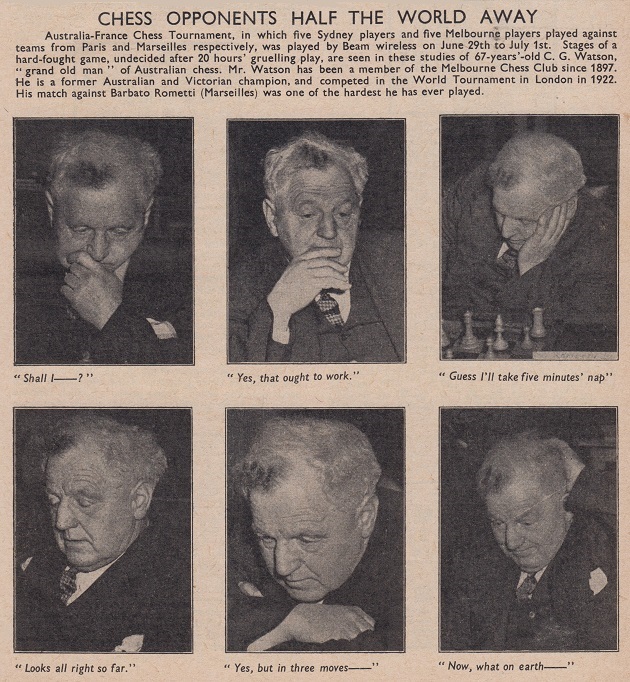
An article entitled ‘Watson the Unique’ by C.J.S. Purdy in the 1 November 1949 issue of Chess World had the following on pages 252-253 regarding London, 1922:
‘Then Watson went to London. It meant crashing into a field which included Capablanca, Alekhine, Vidmar, Rubinstein, Bogoljubow, Réti, Tartakower, Maróczy, Euwe and Co. It’s our firm belief that Watson, bred in the same environment as any of these, would have become a grandmaster himself – but when one considers that before this event he had competed in only one round-a-day tournament in his life, and in his whole 42 years had barely that number of match games against players of his own strength, his score of 4½ out of 15 in that field emerges as something of a miracle. It included four outright wins, the same number that was achieved by Euwe and Znosko-Borovsky. He scored 1½ out of 2 against Britain’s two greatest players, Yates and Atkins, and defeated Réti. He also made a great fight against Vidmar (winner of third prize below Capablanca and Alekhine) and, under time-pressure, missed a forced win against Maróczy.’
On page 261 of Chess World, December 1959 Purdy called Watson ‘Australia’s greatest living native-born player’ and added:
‘The series “Watson the Unique” is the best biographical series we have ever published – except possibly the Alekhine series in 1946.’
‘Watson the Unique’ appeared in three parts: 1 November 1949, pages 249-258; 1 December 1949, pages 275-281; 1 January 1950, pages 2-7.
On page 9 of the January 1962 Chess World Purdy wrote:
‘A circumstance without parallel in Australian chess history is that C.G. Watson, Victoria’s greatest chessplayer, died on 5 March 1961, yet the fact of his death remained unknown in Melbourne or other chess circles till March 1962 – 12 months later.’
(10093)
From page 147 of Chess World, 1 August 1946:
‘When Capablanca died, and when Lasker died, and when Alekhine died, something of every true chessplayer died, and our special memorial numbers were designed to re-incarnate these great masters in the minds of our readers. From our articles, many players now know Lasker, Capablanca and Alekhine better than they ever knew them while they lived.
In chess, very much more than in other sports, great players are a very part of the game, and not to know their play is simply to be not a chessplayer. The reason is simple: a Wimbledon final by Wilding or an innings by Trumper are now “one with yesterday’s 7,000 years” or exist merely as vague images in the minds of a small and ever diminishing number of surviving spectators. But Capablanca’s games can be played over again and again by chessplayers anywhere and any time just as Capablanca played them. Certainly there are many who can “play chess” and have never played over a Capablanca game, but anyone who confesses to it is not recognized as a chessplayer among chessplayers.
And yet he may be able to beat some players in the real chess world. That does not matter. He is still not one of them. Chess is not only a game but an art.’
(10153)
Regarding Luck in Chess, below is an observation by C.J.S. Purdy at the start of his article ‘The Element of Chance in Chess’ on pages 171-172 and 184 of Chess World, August 1957:
‘Chess is so complex that the result of any particular game is partly a matter of luck. Over a series of games the slightly stronger player should win, but in an individual game one can only say that he has slightly better than an even chance; anything can happen.
Chess is far more “flukey”, for instance, than tennis, squash or billiards. In those games, a single bad blunder rarely spells disaster; in chess, often.’
(10170)
From page 278 of the September 1963 BCM, in D.J. Morgan’s Quotes and Queries column:

It will be appreciated if a reader can provide the item published in Canadian Chess Chat. For now, we give an extract from a column by George Koltanowski on page 10 of the Corpus Christi Caller-Times, 20 May 1962:
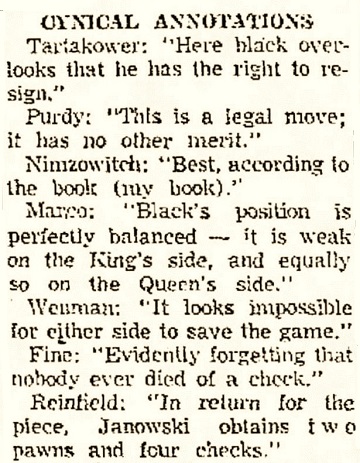
(10171)
Dan Scoones (Coquitlam, Canada) sends, courtesy of Stephen Wright, the requested item in Canadian Chess Chat (page 45 of the February 1963 issue):
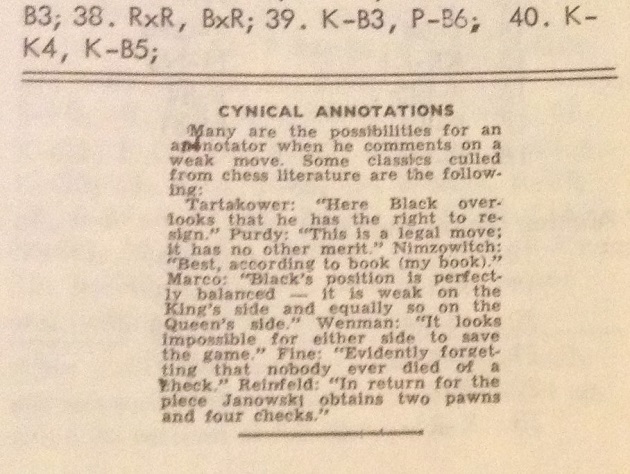
As shown in C.N. 10171, George Koltanowski had presented the same set of quotes, also without any sources, in a newspaper column about nine months previously. We should particularly like to know more about the remark attributed to Purdy.
(10182)
Still being sought: the source of the following annotation by Purdy:
‘This is a legal move; it has no other merit.’
(12002)
A remark by C.J.S. Purdy on the subject of chess and psychology:
‘Against a wary chessplayer the possibilities of applied psychology by an opponent are very limited. The real psychological opponent of every player is himself.’
Source: an article entitled ‘Psychology in Chess’ in Chess World, November 1957, pages 230-232.
(10193)
Some gleanings from the article ‘Luck in Chess, the Clock, the Bad Bishop’ by C.J.S. Purdy on pages 189-190 of Chess World, September 1957:
Another remark by Purdy about the term ‘swindle’, from page 22 of Chess World, January 1957, was quoted in C.N. 9749 (see below).
(10216)
‘The term “swindle” in chess is so widely used that we have to tolerate it. But it carries the implication we always fight against, i.e. that a player in a theoretically winning position has a sort of moral right to the game; if he fails to see through his opponent’s resourceful play, he says he was “swindled”.
Showing that he hasn’t a moral right to the game is just what the authors are really doing – and doing very well.’
Source: Chess World, January 1957, page 22, in a brief notice regarding Chess Traps, Pitfalls, and Swindles by I.A. Horowitz and F. Reinfeld (New York, 1954). Purdy’s item began: ‘This is the best book on traps yet.’
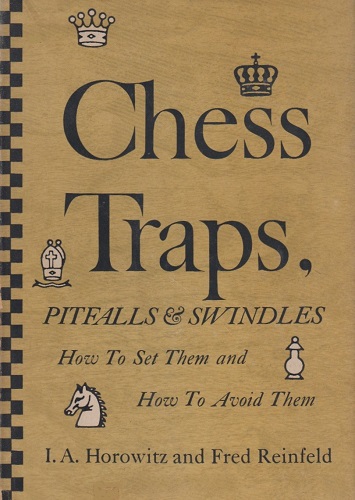
(9749)
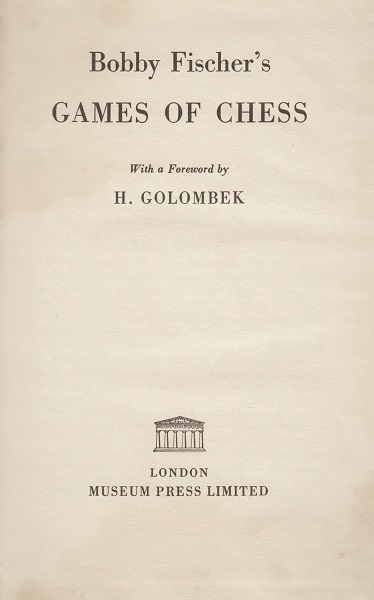
Bobby Fischer’s Games of Chess received a surprisingly warm welcome on page 19 of the January 1960 Chess World, where C.J.S. Purdy remarked:
‘We call the book expensive because it is not much more than a book of Fischer’s games in the USA championship of 1957-58. Perhaps it is not expensive if you consider the miracle of a boy of 14 winning the championship of one of the world’s strongest nations and ahead of the player then regarded as the strongest of the Western world – a standing Fischer himself has now usurped – and not only winning it but capably annotating his games in a mature and objective style.’
(10284)
Regarding the 1937 Euwe v Alekhine world championship match, C.J.S. Purdy wrote on page 80 of Chess World, 1 May 1946:
‘Although for sheer accuracy it could not compare with the Alekhine-Capablanca match, it was, on the whole, the greatest chess match ever played.’
(10363)
‘We do not approve of dry, completely objective annotations – this move is correct, this superior, this inferior, etc. An annotator should try rather to enter into the mind of the player, and explain his ideas.’
Source: Chess World, 1 March 1946, page 33.
(10382)
‘The most inspired “mysterious rook move” (to use Nimzowitsch’s terminology) I ever saw’ was C.J.S. Purdy’s comment on 19 Rhe1 in Crowl v Steiner, Sydney, 1945 (see The Australian Nimzowitsch):
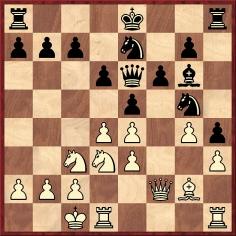
Position after 18...Qe6
(10702)
From an article entitled ‘Promotion, Zugzwang, Stalemate’ by C.J.S. Purdy on pages 81-83 of Chess World, 1 April 1949:
‘Zugzwang is the only kind of combination which doesn’t start with a threat, check or capture. Indeed, except when the motif of Zugzwang enters, every move by the attacker in every combination must be a threat, check or capture. That is why you can always say exactly when a combination begins and ends.’
See too the feature article Zugzwang.
(10837)
‘Chess is so complex that it is given to a very small minority of players, throughout their lives, ever to conduct a really good game over the board.’
Source: Australasian Chess Review, 8 October 1936, page 273 (in an article by C.J.S. Purdy).
(10929)
C.N. 6331 (see also Memory Feats of Chess Masters) showed that, in reply to a question from C.J.S. Purdy, Boris Kostić denied the claim about his exceptional memory made by Capablanca in My Chess Career.
We note now that Purdy wrote similarly about the claim on page 293 of the Australasian Chess Review, November 1936:
‘Naturally, many people swallowed this, but Kostić told the present writer that it was a wild exaggeration ventured upon by Capablanca for effect.’
(10934)
‘The player who completes his development first is said to have the initiative, because he is thus able to start making blunders while his opponent is still occupied in bringing out his men.’
That remark from page 14 of “Among These Mates” by Chielamangus (Sydney, 1939) was given in C.N. 1858 (see page 246 of Chess Explorations).
A modern alternative:
‘The player who completes his or her development first is said to have the initiative, because he or she is thus able to start making blunders while his or her opponent is still occupied in bringing out his or her men or women.’
The text on pages 12-15 of Purdy’s pseudonymous book:
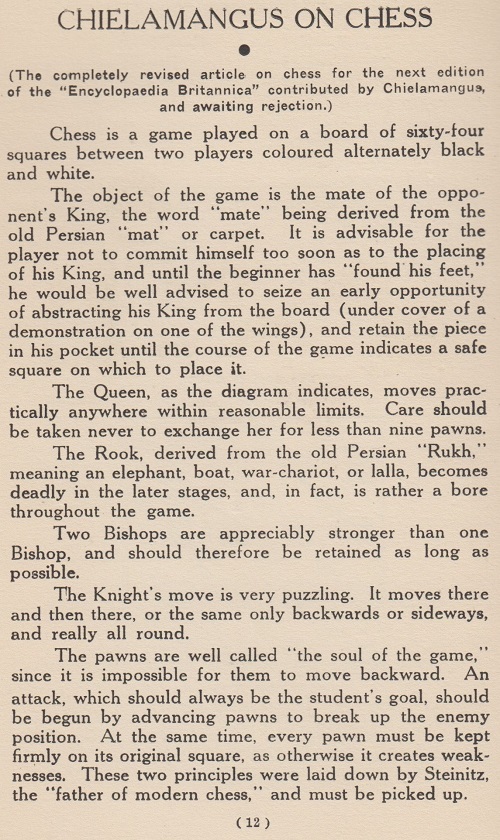
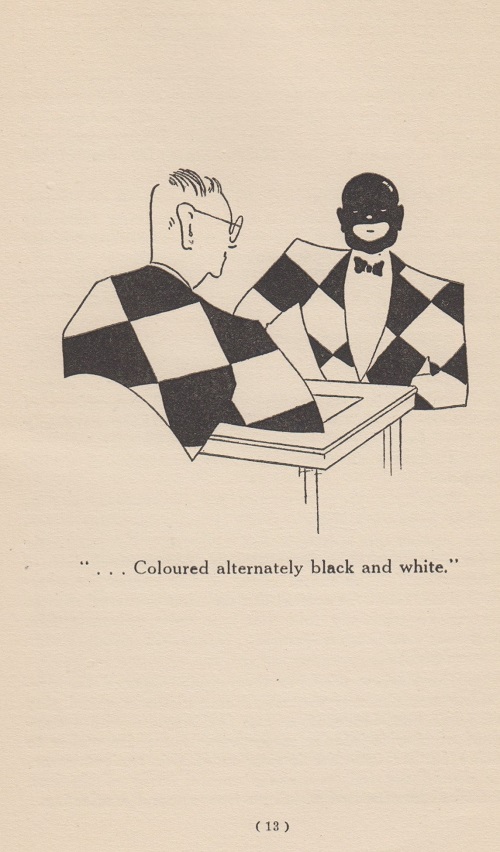
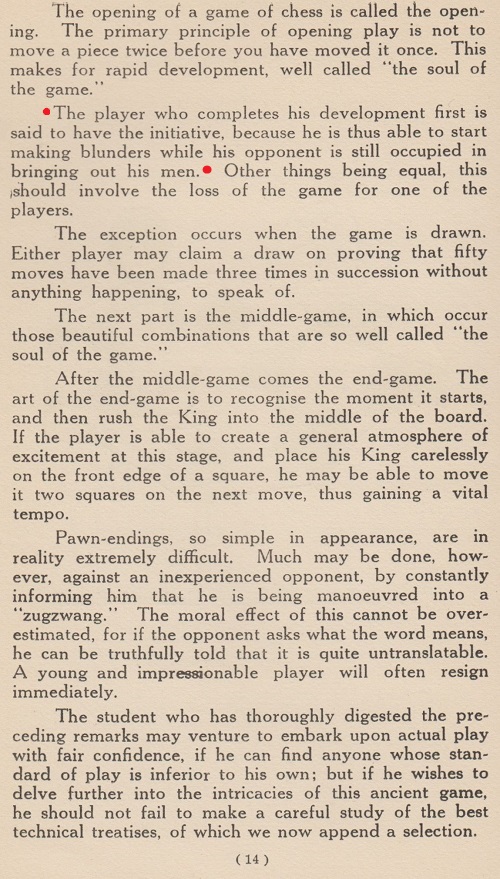

The concluding part of the Chielamangus article was a spoof history of chess.
(10973)
C.J.S. Purdy, writing on page 31 of the Australasian Chess Review, 27 February 1937:
‘Theory takes you further in chess than in any other game – but it does not take you all the way. What counts, above all, in practical play, is the ability to see mechanically and without effort all the “little combinations” that cloud the strategical issue. The master in constant practice can do this, where the amateur has to ferret them out laboriously, and occasionally misses them altogether, and then a blunder results. In tennis, cricket, etc., at least 80% of a player’s skill is purely mechanical – developed simply by assiduous practice. And in chess, although the percentage may be very much smaller – since intelligence and the ability to reason play much bigger parts than in other games – it is still quite large.’
(10979)
The inside front cover of the October 1972 CHESS stated that three books on the Spassky v Fischer match, by Alexander, Gligorić and Horowitz/Reshevsky, ‘were on sale in Britain within a fortnight of the close of play’. Alexander’s was considered the best: ‘There is ten times as much really original analysis as in the other two books put together.’
A letter from C.J.S. Purdy dated 22 October on pages 45-46 of the November 1972 CHESS commented:
‘I question your remark that there are three books in English on the Reykjavik match. There is a fourth, How Fischer Won, by me (echo of my 1935 book How Euwe Won). Fantastically, it was already out of print (a 14,000 edition) when your October number appeared. It went out of print in one week. The only batch sent to Europe was 100 copies airfreighted to Skopje. They did not arrive and have not yet been traced. A much revised and augmented version will have been printed when you receive this, re-titled Genius Crowned.’
We are aware of no publication by Purdy of that name.
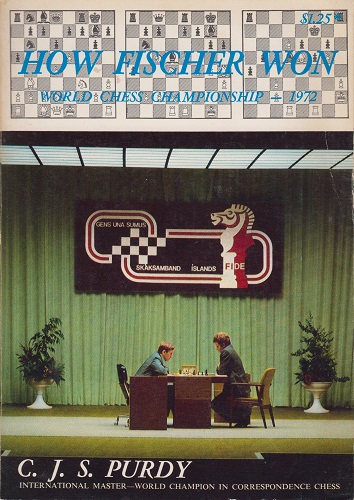
Purdy brought out an eight-page supplement, Post-Mortem 1976 to Fischer-Spassky 1972. A sample page:
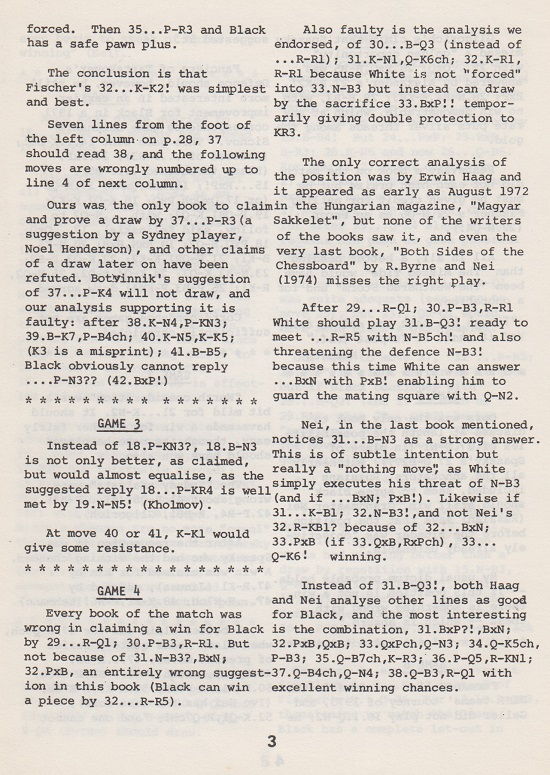
His remarks in CHESS about the print-run for How Fischer Won have prompted our latest feature article, Chess Book Sales.
(10983)
From page 184 of the Australasian Chess Review, 9 July 1936, in a report written during the Moscow, 1936 tournament:
‘Among the great, Capablanca can be great, because he does not have to play to avoid draws. He has not Alekhine’s gift for beating inferior players, but when all the competitors are of his own class, he can give free rein to his natural style – classical simplicity.’
(11039)
How did this position arise?
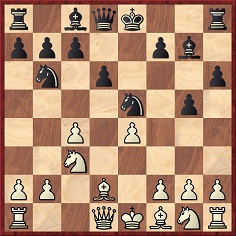
Black to move
It comes from a game between C.J.S. Purdy and F.A. Crowl (Melbourne, 29 December 1934 – see page 9 of the Sydney Daily Telegraph of 31 December 1934) which Purdy annotated on pages 317-318 of the November 1936 issue of the Australasian Chess Review under the heading ‘Humour in the Opening’.
Purdy began:
‘Little humour is to be found in the chess openings, a field that is sacrosanct to serious-minded theorists. The following game, however, contains a genuine piece of sheer buffoonery (unintentional) within the first dozen moves. Played in the fourth round of the last Australian championship tournament (Melbourne 1934-35), it is a disgrace to both contestants, but none the less entertaining for that.’
The full score, with Purdy’s punctuation:
1 c4 Nf6 2 d4 e5 3 dxe5 Ng4 4 Bf4 g5 5 Bd2! Nxe5 6 e4 Bg7 7 Nc3 d6 8 Qh5!? h6 9 Be2??? Nbd7 10 Bf1!! Nb6 11 Qd1!!! Be6 12 b3 Qd7 13 Be2! O-O-O 14 Nf3 Ng6 15 Qc2 g4 16 Ng1!! f5 17 exf5 Bxf5 18 Bd3 Rde8+ 19 Nge2 Rhf8 20 Bxf5 Rxf5 21 O-O-O Nh4 22 Nf4 Qf7 23 g3 Nf3 24 Be3 Qf6 25 Nb1! Kb8!? 26 h3 Qa1!? 27 Nd5 Nxd5 28 cxd5 Rf7 29 hxg4 Rfe7 30 Rd3 Ne5 31 Rd4 Nc6 32 Ra4 Nd4 33 Qd2 Nb5 34 Kc2 Nc3 35 Nxc3 Qxh1 36 Bxa7+ Kc8 37 Be3 Kd7? 38 Qd3 Rb8 39 g5 Bxc3 40 Kxc3 Qa1+ 41 Kc2 b5 42 Ra7 h5 43 Qf5+? Kd8 44 Qf8+ Re8 45 Qf7 Re7 46 Qxh5 Qe5 47 Qf3 Ke8 48 Qf6 Qe4+ 49 Kb2 Kd7 50 Qd4 Qxd4+ 51 Bxd4 Re2+ 52 Kc3 Rg8 53 Be3 Rg6 54 Kb4 Rxe3 55 fxe3 Rxg5 56 Kxb5 Rxd5+ 57 Kc4 Rg5 58 e4 Kc6 59 b4 Rxg3 60 a4 Kb6 61 Ra8 Kb7 62 Re8 Rg1 63 Re7 Rc1+ 64 Kb5 Ka7 65 e5 dxe5 66 Rxe5 Kb7 67 Re7 Ka7 68 a5 Kb8 69 Re5 Rd1 70 Re6 Rd8? 71 Kc6 Rh8 72 b5 Rg8 73 a6 Rd8? 74 a7+ Kxa7 75 Kxc7 Resigns.
A note in the middle-game is of interest:
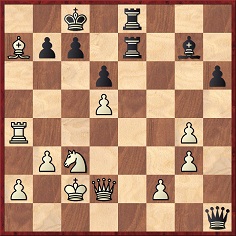
Position before 37 Be3 Kd7
[37 Be3] ‘White’s sealed move, virtually forced. Now, a remarkable instance of the psychological factor in chess is that Crowl, in spite of having an hour for private analysis, and being certain of White’s sealed move, made a gross blunder immediately on resuming. He had failed to adjust himself to the fact that White had completely recovered his lost ground. He had therefore examined only defensive moves for White. This shows that it is much better to recover from a bad game than to have an equal game all the time.’
Finally, Purdy called 70...Rd8 ‘the losing move’, adding this maxim in bold type:
‘Avoid using a rook for defence.’
(11164)
Concerning the 1934-35 correspondence game between Purdy and Crowl, see C.N. 1859 (pages 83-84 of Chess Explorations) and our feature article on Crowl, The Australian Nimzowitsch.
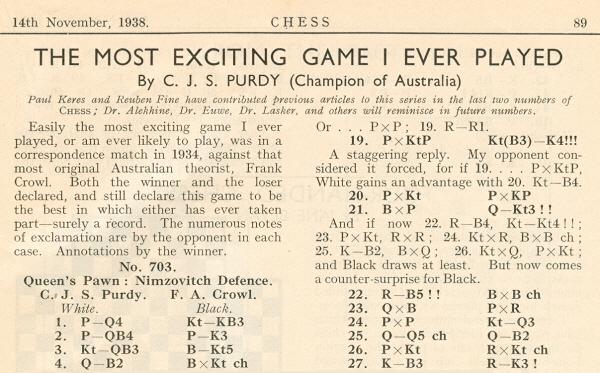
From page 35 of the February 1961 Chess Review:
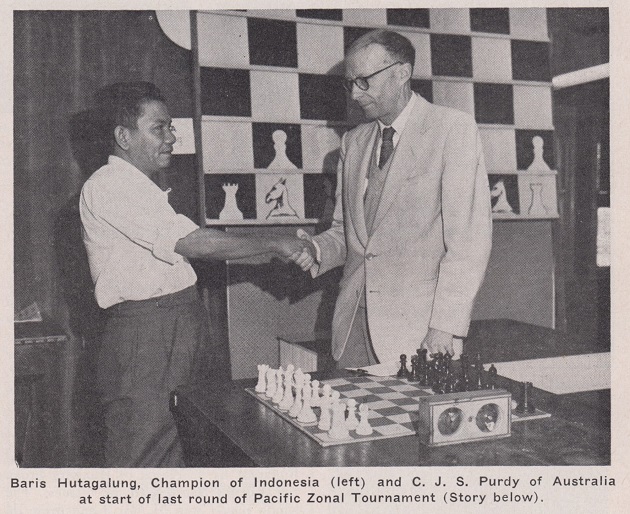
(11187)
C.N. 6884 reproduced this advice from page 92 of the 1 April 1949 Chess World:
‘... never resign just to show you can see your opponent’s threats.’
C.J.S. Purdy reverted to the matter on page 184 of the August 1961 issue of his magazine:
‘Never play quickly against a slow resigner just to show how easy it is. Likewise, never resign prematurely just to show you recognize your game is lost. In other words, showing off doesn’t pay.’
(11430)
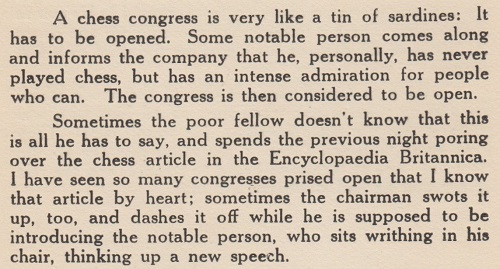
“Among These Mates” by Chielamangus (Sydney, 1939), page 58
(11452)
See too C.N. 9230.
C.J.S. Purdy on pages 184 and 185 of Chess World, 1 August 1949:
‘Have you noticed that the López tends to win long games and lose short ones? There’s a reason. In the López White sacrifices development for long-term theoretical advantages. Sometimes Black’s advantage in development tells quickly.’
‘Boiling water is the most efficient for washing dishes but it will scald you if you’re not very careful. The López is like that. White has certain theoretical assets which he has purchased at the cost of development. He must try not to give Black a chance to capitalize his gain in development with a sharp attack – unless, as in the Marshall, he gets a pawn or something, with a good chance of holding it.’
After a reference to Capablanca v Marshall, New York, 1918, Purdy’s article (page 184) had a comment which is quoted on page 328 of our book on the Cuban:
‘Capablanca was the gambit-killer of all time.’
(11454)
As an addition to Chess Strategy and Tactics, some observations by C.J.S. Purdy on page 74 of the Australasian Chess Review, 30 March 1938:
‘What is it that really distinguishes strategy from tactics?
... When the player begins calculating on the basis of possible replies, he enters the realm of tactics.
In other words, we must arrive at definitions which indicate that tactics is the part of chess thinking based on calculation move by move, and that strategy is the part of chess thinking that is concerned with aims and plans (which are one side’s moves only). In actual play, the two are sometimes inextricably interwoven, but however much you tangle two different pieces of string, they remain two different pieces.’
(11612)
‘Vidmar is just a divinely-gifted wood-shifter.’
That comment was by C.J.S. Purdy in the Australasian Chess Review, 12 November 1936, page 290, in an article on that year’s Nottingham tournament:
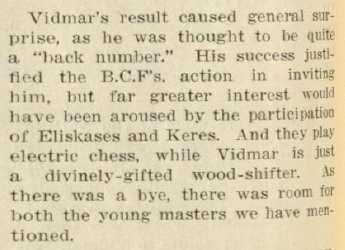
(11620)
Sean Robinson (Tacoma, WA, USA) informs us of the death of Robert B. Long earlier this month. He was murdered at his home in Davenport, IA, USA.
Bob Long was a chess editor, bookseller and writer whose magazines included the Chess Gazette, Lasker & His Contemporaries and Squares. The most prominent of the many books published by his company, Thinkers’ Press, was a series of compilations of C.J.S. Purdy’s writings.
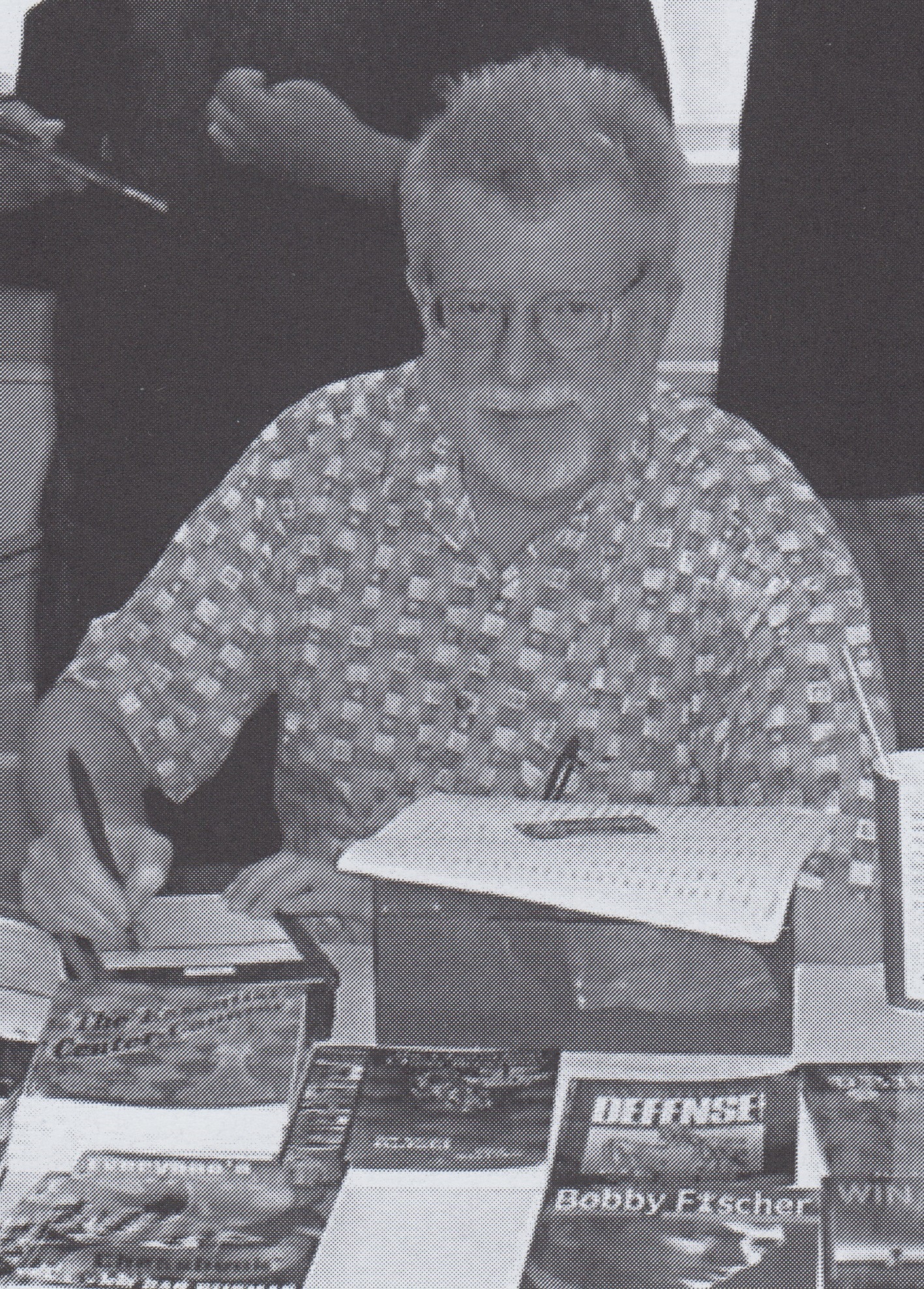
Bob Long
Squares, Fall 2005, page 34
(11666)
C.N. 9561 showed part of the back cover of C.J.S. Purdy’s Guide to Good Chess (Davenport, 2006):

The front cover of another Thinkers’ Chess production, published towards the end of 2019, also has a reference to Fischer on which more information is sought:
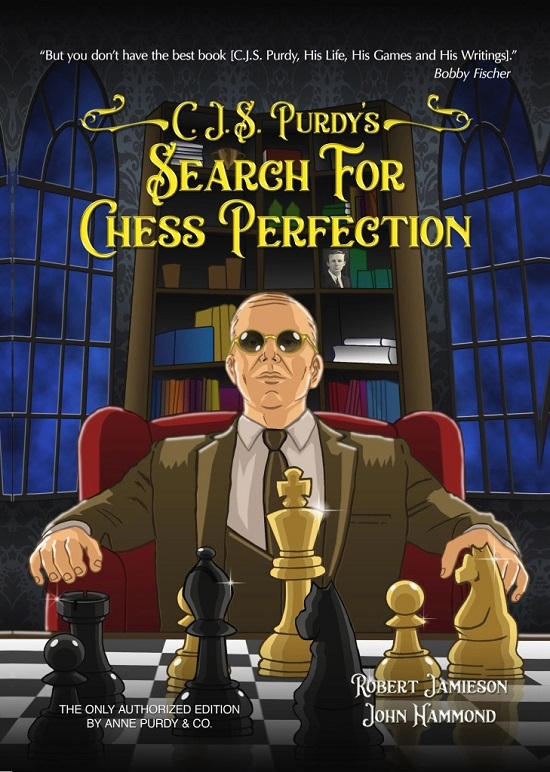
Purdy is almost universally admired, but C.N. 9639 quoted the following from Larry Evans, in a letter to us dated 12 November 1990:
‘... the relatively obscure Australian magazine Chess World (which probably never reached 1,000 subscribers) edited by a minor master to whom I could have given pawn and move ... If you care to place a wager – with the loser to pay for the cost of a poll – I maintain that not ten in a thousand subscribers to Chess Life have ever heard of or seen a copy of Purdy’s Chess World, which they would probably confuse with Frank Brady’s short-lived periodical.’
We add here a filmclip of Purdy giving a simultaneous display. An announcement of the event was on page 41 of Chess World, 1 February 1951:
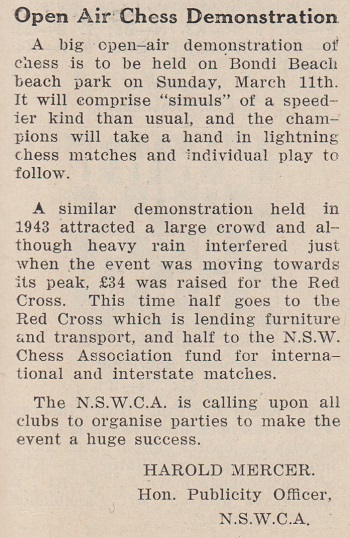
The photograph of Purdy below comes from page 155 of the Australasian Chess Review, 30 June 1938 and is of slightly better technical quality than the version given in C.N. 4924 from page 284 of Chess World, December 1951.
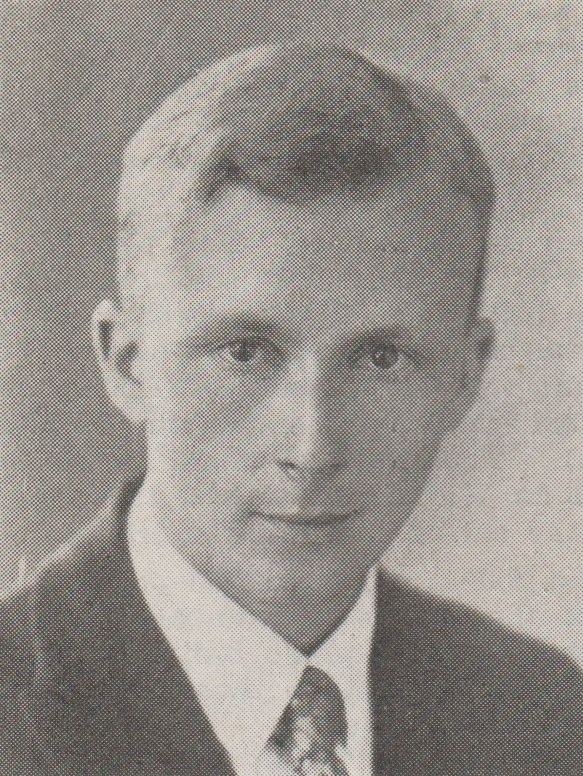
(11673)
Purdy discussed the circulation of Chess World in an editorial on page 105 of the July-August 1967 issue. Paying tribute to the late Harry Campbell, the magazine’s inexpensive printer, Purdy wrote:
‘C.W. owed its long survival to Harry Campbell. At the end of the year 1966 we realized that C.W. could only be made economic if it could build up to a circulation of 4,000. ... We had raised our circulation by a thousand, and had been banking on raising it by two thousand.’
Pages 5 and 7 of Chess Life, 20 November 1957 had some comments by Purdy about G.H.D. Gossip:
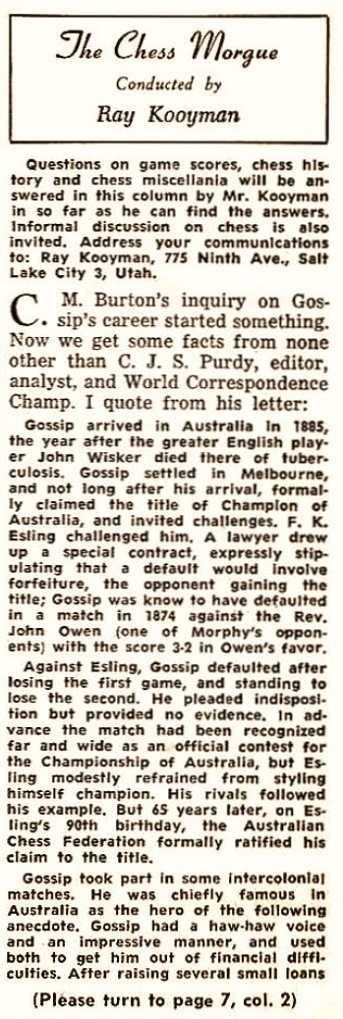
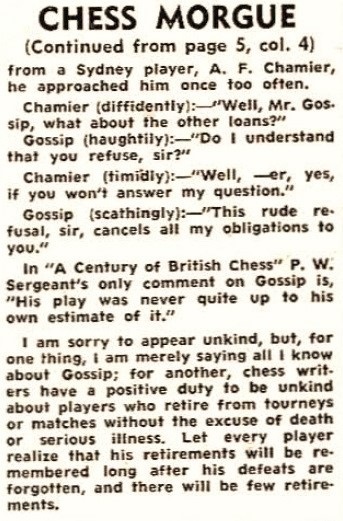
From page 234 of Chess Life, August 1967, in the ‘Women’s Chess’ column by Kathryn Slater:
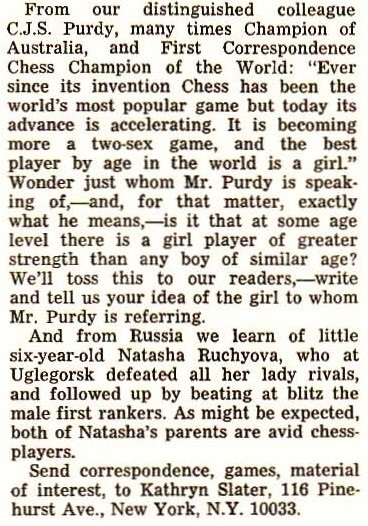
Purdy was referring to Jutta Hempel, whom he had discussed in Chess World earlier in the year:
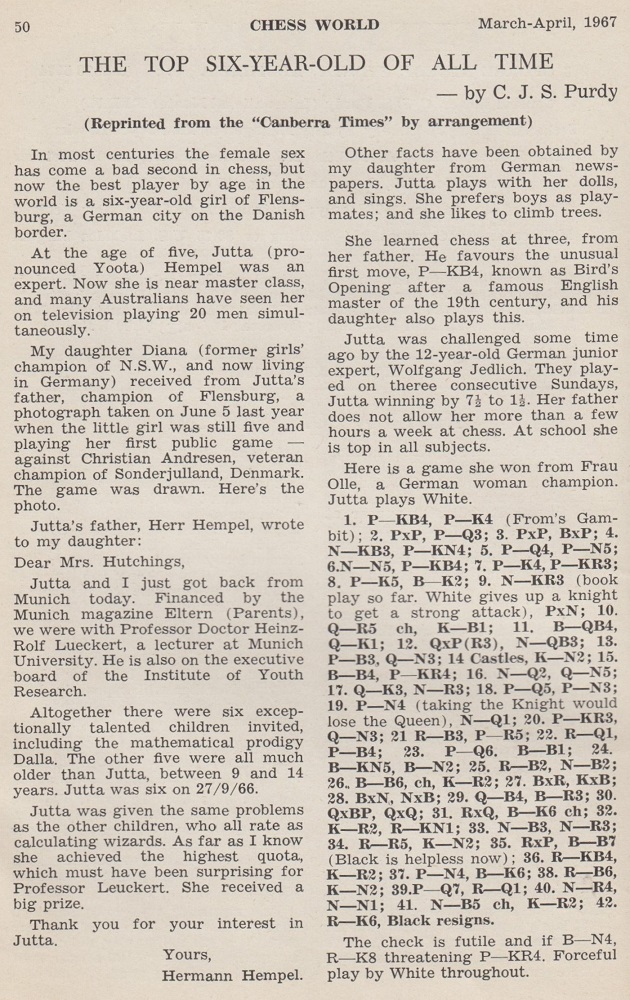
The following page had the photograph of Jutta Hempel shown in C.N. 9613, and on page 52 Purdy concluded with some general remarks on prodigies and on male and female chessplayers:
‘Alas for the popular fallacy that prodigies “burn themselves out”! No chess prodigy has done this.
In my opinion the general male superiority in chess has been mainly a matter of fashion. For a long time it has been “in” for boys to play chess, and for some of them to study it from books – only those who study it become good. It has not hitherto been “in” for girls, and among them the idea of studying chess books has been regarded as eccentric. This situation is altering slightly. If it begins to change completely, chess will become again a two-sex game, as it has been at other times in history, especially in mediaeval Europe.’
(11701)
Also from page 52 of the March-April 1967 Chess World:
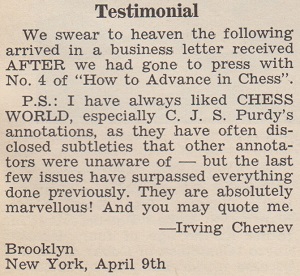
Purdy’s ‘How to Advance in Chess’ article was on pages 77 and 80 of the same issue. Most of his praise of Irving Chernev was quoted in C.N. 9713, but below is an additional passage in which Purdy related that he had recently given a chess lesson, lasting just over an hour, to a 13-year-old girl, ‘a fairly raw beginner’:
‘What would I charge for such a lesson normally? Well, at least $4, assuming I was willing to give one at all. Not many beginners care to pay so much for early lessons.
What is the answer? I saw it at once, and told the pupil, who realized I would not have time to give further lessons.
Ten years ago there was no answer. Now there is. It is Chernev’s Logical Chess Move by Move.
For this is the only book of annotated games that is comprehensible to a tyro. Every other book of annotated games leaves some moves unexplained.’
(11702)
When the mess over the year of birth of C.J.S. Purdy (1906 or 1907?) was discussed in C.N. 4924, these statements from his own output were listed:
The list can be expanded:

The back cover of the fourth edition (1957) gave no year of birth but stated:
‘C.J.S. Purdy has had a distinguished Chess career dating from 1924, when at seventeen he became Chess Champion of New Zealand.’
When he won that event (Nelson, December 1924-January 1925) his youth was frequently remarked upon; his reported age, 17, is compatible with a birth-date of 27 March 1907. According to page 181 of the April 1925 BCM, Purdy was ‘only 17 years and nine months old’. The New Zealand press regularly stated that he was aged 17 and/or that he was born in 1907, and features such as the one below (from page 7 of the Manawatu Times, 8 January 1925) were commonplace:

1 d4 d5 2 Nf3 Nf6 3 c4 e6 4 Nc3 c5 5 cxd5 exd5 6 g3 Nc6 7 Bg2 cxd4 8 Nxd4 Bc5 9 Nxc6 bxc6 10 O-O O-O 11 Bg5 Ba6 12 Na4 Be7 13 Re1 Re8 14 Qd4 Ne4 15 Bxe7 Rxe7 16 e3 Nd6 17 Qc3 Rc8 18 Bh3 Rcc7 19 Qa5 Bc8 20 Bf1 Ne4 21 Rac1 Qd6 22 Nc5 Ng5 23 Bg2 Nh3+ 24 Bxh3 Bxh3 25 Qc3 h6 26 Red1 Bg4 27 Rd4 Qg6 28 Rf4 Bh3 29 Qd4 Bc8 30 f3 f5 31 e4 Qe8 32 exf5 g5 33 fxg6 Re1+ 34 Rxe1 Qxe1+ 35 Kg2 Re7 36 Rf8+ Kxf8 37 Qh8 mate.
Other Purdy games from the championship published in New Zealand newspapers were his encounters with E.H. Severne and B.W. Stenhouse, both with Purdy’s notes. An unnumbered page of Australian Chess 1915 to 1930 by Anthony Wright (Melbourne, 1997) gave the score of Purdy v F.K. Kelling (game 178), without a source.
With the barrage of evidence, and particularly from Purdy’s own pen, in favour of 1907 as his year of birth, it was natural for reference books to follow suit. See, for instance, the Purdy entries in the works by Horton (1959), Le Lionnais/Maget (1967 and 1974), Sunnucks (1970 and 1976), Chicco/Porreca (1971) and Golombek (1977). Purdy reviewed the Horton volume positively on page 226 of the October 1959 Chess World; whilst observing that his own entry was too long, he did not demur from its statement that he was born in 1907.
In the second impression (1980) of Golombek’s work, as well as the 1981 paperback edition, 27 March 1907 quietly became 27 March 1906. A possible explanation is this brief item by K. Whyld in his Quotes & Queries column on page 152 of the March 1980 BCM:
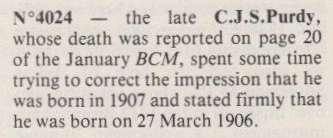
Such a bald assertion would not pass muster today. A proper source is required, with acknowledgement that it was Purdy himself who had been the most active disseminator of 1907. That takes us back to the unanswered question in C.N. 4924: when did he discover that 1907 was wrong? If a reader has access to a run of Who’s Who in Australia, we should like to know when that publication switched from 1907 to 1906.
That the year 1907 is wrong can hardly be disputed given the public announcement of his birth cited in C.N. 4924. From page 1 of The Times (London) of 26 May 1906:
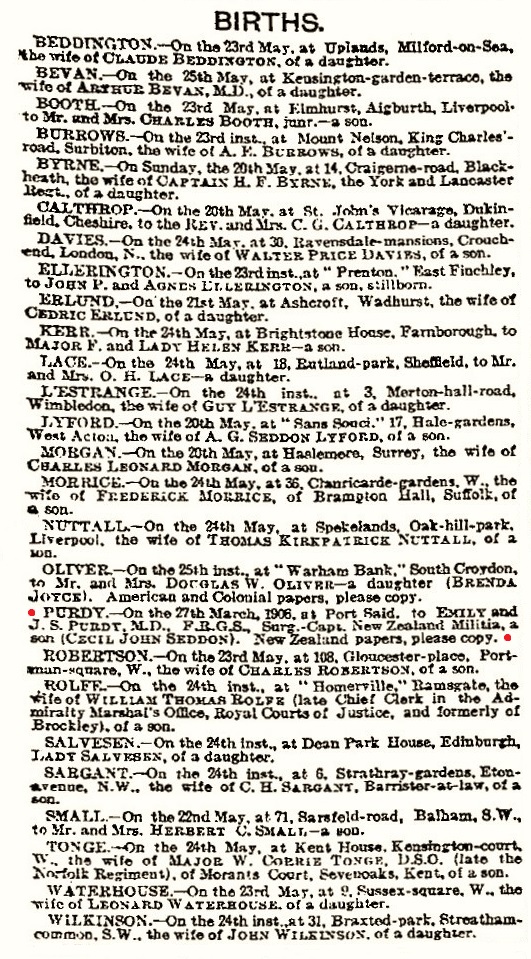
It remains to be clarified how the later muddle occurred.
(11705)
From page 14 of C.J.S. Purdy, His Life, His Games and His Writings by J. Hammond and R. Jamieson (Melbourne, 1982), in the chapter ‘C.J.S. Purdy – His Life’ by Anne Purdy, his widow:
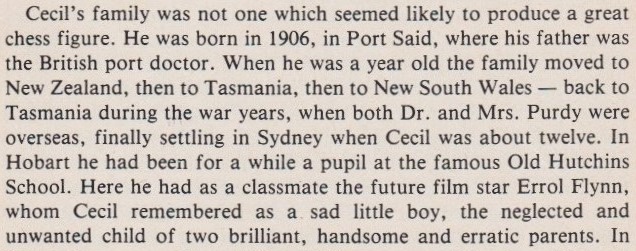
The Hutchins School was mentioned on pages 13-15 of The Young Errol by John Hammond Moore (Sydney, 1975), which asserted that Errol Flynn (born on 20 June 1909) was a pupil there:
‘Errol began his formal education at the Franklin House School on Davey Street, but by 1918 was enrolled in the junior division of the Hutchins School, Hobart’s most prestigious private, old-tie institution for miniature bluebloods.
... Errol lasted only one more term at Hutchins. (Australian schools traditionally operate on three terms of several months each from February to December.) In April of 1920 he entered Friends’ School ...’
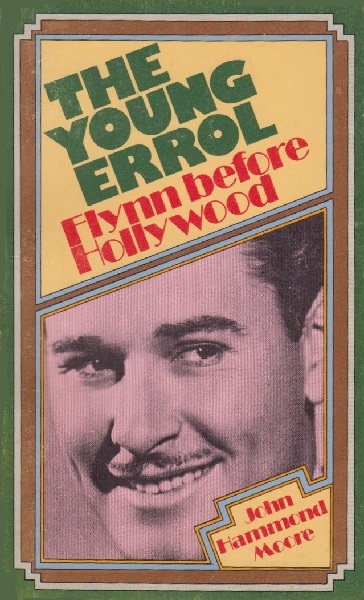
Different information is on pages 7 and 9 of Errol Flynn The Tasmanian Story by Don Norman (Hobart, 1981):
‘Errol first attended Franklin House School in July 1916, which was later incorporated in Hutchins Junior School in June 1917 ... Hutchins School is a prestigious establishment for boys begun in 1846 and modelled on the lines of the upper class English schools.
Errol went with the boys of Franklin House School to Hutchins Junior in June 1917, but remained there for only a short time before attending Albuera Street Model School ...
There is no explanation as to why Errol was taken away from Albuera Street School when he was ten years and ten months old and placed as a boarder at Friends School, a long established academy for girls and boys. He was nine months at Friends leaving on 20 December 1920.’
(11706)
Purdy appears in group photographs of the Sydney, 1926 and Melbourne, 1930-31 tournaments on unnumbered pages of Australian Chess 1915 to 1930 by Anthony Wright (Melbourne, 1997).
From page 70 of “Among These Mates”:

The congress depicted by Loaline Lancaster was the 1936-37 Australian championship in Perth. A group photograph from the tournament is in the plate section between pages 48 and 49 of Australian Chess at the Top by Cathy Chua (Oaklands Park, 1998). The same section has the above-mentioned picture of Melbourne 1930-31.
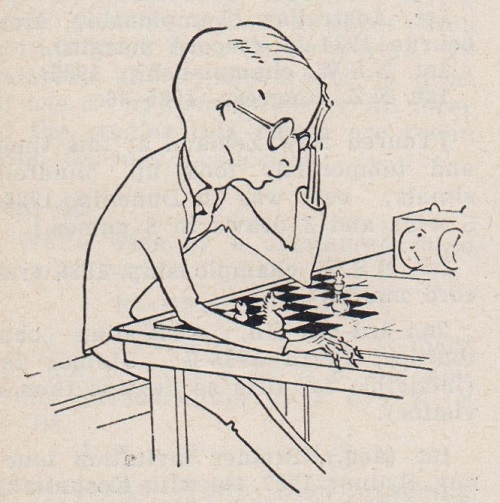
C.J.S. Purdy
Chess World, August 1960, page 162
From page 6 of Chess World, January 1967, at the end of an article entitled ‘How to Advance in Chess (2)’ by C.J.S. Purdy, under the heading ‘Purdy, Iconoclast’:
‘My later contribution to chess theory was to point out the bunkum inherent in a priori theories like Z-B’s [Znosko-Borovsky’s] force-space-time one and to show that the proper way to examine chess was to start from the game itself, not to impose something upon it from outside. Thus I started to examine the moves and the rules. Above all, I pointed out that almost the whole basis of chess is the rule that each player must move in turn and only one thing at a time. This makes it entirely different from war and explains why such enormous advantage results if one side can face his opponent with the often impossible task of doing two things at once. Not impossible always, for one move will sometimes do two things. But often. Combinations are all based on that rule.
For years I searched around for a true definition of a combination – there have been at least a dozen attempts – and finally realized that a definition was unnecessary. And why? Because combinations can be split up into something simpler, namely threats. Thus I arrived at my most important dictum:
Threats are the basis of winning chess.’
‘A pawn sacrifice may be more brilliant than a queen sacrifice ...’
Source: Australasian Chess Review, November 1936, page 314, from the introduction to Reshevsky v Vidmar, Nottingham, 1936.
In the annotated game below (on pages 116-117 of the Australasian Chess Review, 8 July 1942), Purdy’s comments on White’s 11th and 29th moves are notable:
‘In chess one should never be influenced by previous play.’
‘These painless deaths ... are characteristic of Capablanca’s games.’
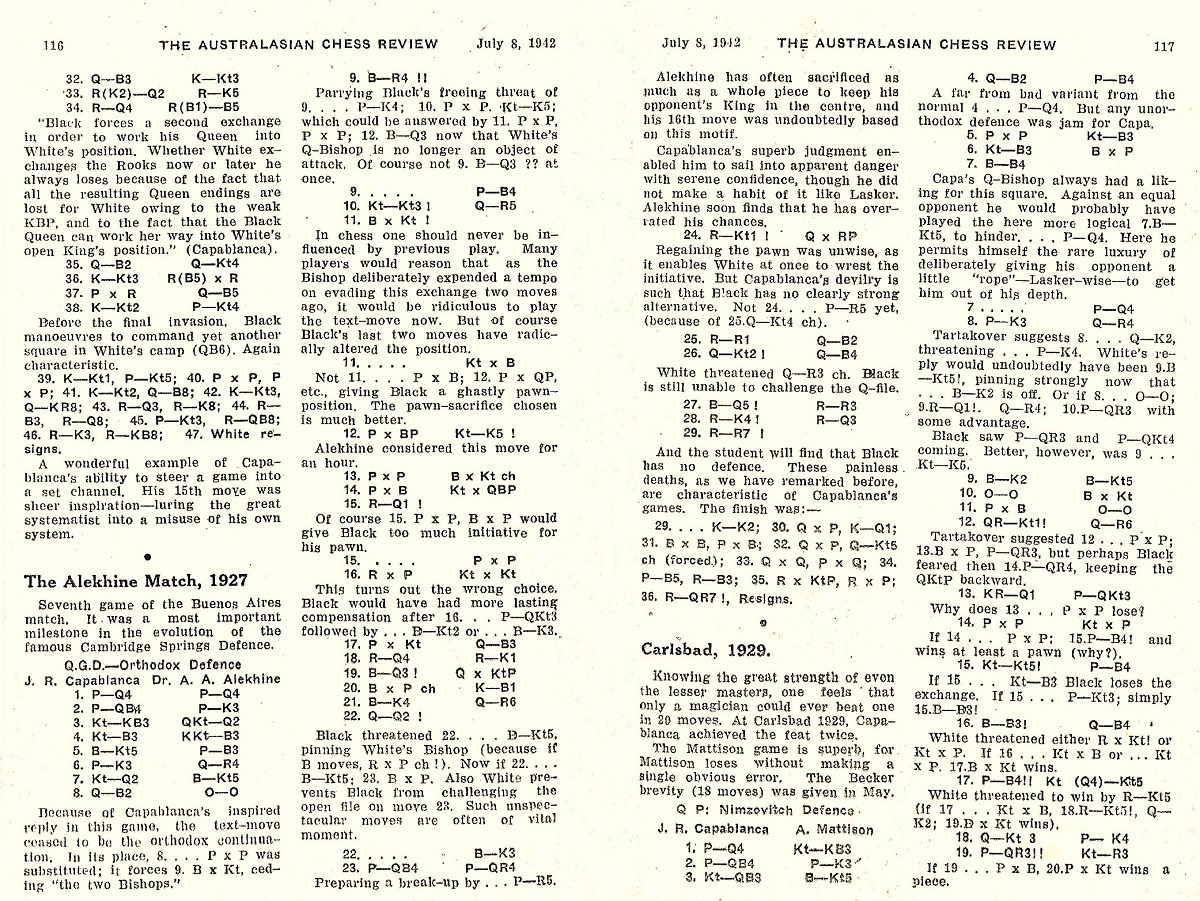
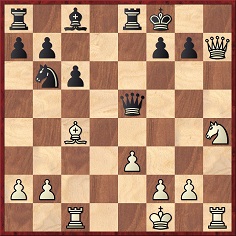
White to move
The Abrahams v Thynne brilliancy was discussed in C.N.s 3158 and 3167 (see pages 278-279 of Chess Facts and Fables), but we have not yet quoted C.J.S. Purdy on the game. He annotated it on pages 315-316 of the Australasian Chess Review, 12 November 1936 with this introduction:
‘We all enjoy bombshell moves. The 20th move in this game makes a loud enough explosion for anybody. Abrahams specializes in bombing.’
Purdy gave 20 Qg8+ three exclamation marks.
(11959)
See also:
C.N. 9639: Kok study
C.N. 10251: draws and scoring systems
C.N. 16111: the lengthy Charlick v Crane game.
Feature articles:
Steinitz, Lasker, Potter and ‘Modern Chess’
To the Chess Notes main page.
To the Archives for other feature articles.
Copyright: Edward Winter. All rights reserved.